Author: admin

Bangladesh ArchSummit 2025 Begins Alongside the IAB Build Expo 2025
The Institute of Architects Bangladesh (IAB) inaugurated the Bangladesh ArchSummit 2025 today, December 11. This year’s theme, “Crafting Space, Shaping Habitat,” sets the stage for a grand celebration of architecture, education, profession and practice, ideas, innovation, and excellence. Running in parallel with the Summit, IAB also launched the IAB Build Expo 2025, the country’s largest exhibition of building materials and construction innovations. Both events will continue until December 13 at the Bangladesh China Friendship Conference Centre (BCFCC). The Summit is open exclusively to registered participants, while the Expo is open to all visitors. This year’s Summit has been carefully planned with a distinguished lineup of renowned international and national speakers, along with a range of enriching programmes, including an exhibition of award-winning architectural works, roundtable discussions, a young citizens’ painting competition, a photography competition, and exciting cultural events for registered participants. Participants will also have the opportunity to attend the Student Forum, Youth Forum, and plenary sessions, where esteemed speakers will share their ideas, design philosophies, and professional insights throughout the three-day event. Day One began with the Student Forum, featuring a quiz and debate competition, and included the Summit and Build Expo Inauguration Ceremony. Other attractions include the Open Photography Competition, Young Citizens’ Painting Competition, and Public Exhibition on Architecture. The Young Painting Exhibition features curated artworks submitted by students from Classes 6 to 10. The jury panel for the selection included Architect Rafiq Azam, artist Afzal Hossain, and Farida Zaman. The theme of the architectural works exhibition, PEOPLE | PLACE | PRESENCE, celebrates architecture that shapes communities, responds to context, and defines presence through space. The exhibition showcases curated works selected from project submissions in the following categories: Internationally Awarded Projects (2024–2025) from Bangladesh IAB & BERGER Award Projects (last cycle) Public Projects (nationwide) Projects Located in Old Dhaka The project selection team comprised Dr. Abu Sayeed M Ahmed, Ar. Khan Md. Mahfuzul Hug Zaglul, Ar. Nowajish Mahbub, Dr. Khurshid Zabin Hossain Taufique, and Prof. Zainab Faruqui Ali. The ArchSummit and Build Expo aim to provide a platform for architects, students, industry professionals, and the public to explore architecture, innovation, and the future of the built environment in Bangladesh. Written By Tasmiah Chowdhury
Read More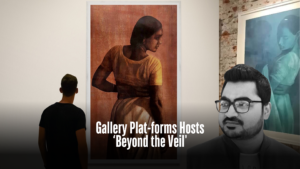
Gallery Plat-forms Hosts ‘Beyond the Veil’
Gallery Plat-forms is hosting ‘Beyond the Veil’ – 3rd solo exhibition by M F I Mazumder Shakil. In this exhibition, the artist presents the ancient medium of woodcut in a fresh, contemporary artistic form. A total of 24 woodcut prints are on display which includes 8 large-scale works. The exhibition began on November 9 and has now been extended until December 13, with visiting hours from 11 am to 8pm. As noted by Gallery Plat-forms, in ‘Beyond the Veil’, Shakil revives the long-format woodcut to explore a world both intimate and exclusive. Through sweeping panels in amber, midnight blue, and stark monochrome, a woman emerges through fabric, fold and shadow. The veil becomes a threshold rather than concealment, inviting us to see without seeing. Each cut and layer conjures the textures of cloth and memory, secrecy and freedom. Part portrait, part landscape of the unseen. Beyond the veil transcends identity to question how we perceive, what lies hidden. Rooted in tradition yet distinctly contemporary. Shakil’s work reimagines the politics of visibility and expands the language of global printmaking. “My work is primarily in printmaking – specifically woodcut. I begin by drawing on plywood or any other board, then carve the block using woodcut tools based on the distribution of light and shadow. After that, I apply ink to the block with a roller through various processes, and finally transfer the print onto paper. Depending on the size, completing a single piece can take several months,” explains Shakil. “I have participated in various exhibitions, art camps, and art fairs both in Bangladesh and abroad. In the future, I plan to organize solo exhibitions outside the country as well. In recent times, young artists in Bangladesh have been tirelessly pursuing creative practice, and their works have already received significant recognition on the international stage. However, the overall acceptance of fine arts within the country has yet to reach the desired level. I remain hopeful that with proper patronage and support, our artists will be able to present Bangladesh’s artistic heritage to the world with even greater distinction,” the artist further adds. Mohammed Fakhrul Islam Mazumder, a Bangladeshi artist born in Comilla in 1989. He completed his M.F.A and B.F.A in Printmaking from the Faculty of Fine Arts at Dhaka University in 2016 and in 2014. Mazumder has held two solo exhibitions— “Obscure Beauty” (GalleryChitrak, 2023) and “The Odyssey of the Soul” (Zainul Gallery, 2018). His art has been showcased widely across Asia,Europe, and Australia, including major exhibitions in Japan, China, Thailand, Korea, India, Nepal, and Bangladesh. He has received numerous national and international awards such as the 26th Berger Young Painters’ Award (2022), Excellent Works Award, COP15 Global Art & Design Competition, China (2022), 2nd International Print Biennale Award, India (2021), and the Shilpacharya Zainul Abedin Award (2019). Mazumder’s works are part of collections at the China Printmaking Museum, Ino-cho Paper Museum (Japan), Bengal Foundation, and Lalit Kala Academy (India). He has also participated in several artist residencies, including the Chitrashala International Artist Residency in India and Kali Artist Residency at Cosmos Atelier 71, Bangladesh. Currently, Mazumder continues to experiment with layers of print, texture, and form to reflect the subtle interplay between the visible and the unseen. Through this exhibition, Shakil opens a new doorway not only to beauty but also to perception. His works, imprinted with the labor of hand-carved marks on solid wood surfaces, unfold into a poetry of light and shadow. This exhibition is part of Gallery Plat-forms’ commitment to presenting Bangladeshi artists who bring together heritage and contemporaneity, offering them anew to the global stage. Written by Tasmiah Chowdhury Photo Credits Sarmin Akter lina Gallery plat-Forms
Read More
National SME Product Fair begins today
The curtain rises today on the 12th National SME Product Fair, a flagship exhibition spotlighting the rapid expansion of Bangladesh’s small and medium enterprise sector. The event, organised by the SME Foundation, has become a cornerstone of the country’s entrepreneurial calendar, offering a platform where innovation, tradition, and business ambition converge. The SME Foundation, which is steering the initiative, underscored its ambitions to widen market reach, accelerate innovation, and strengthen the country’s entrepreneurial base. Officials emphasise that the fair is not merely a showcase of products but a comprehensive programme designed to connect entrepreneurs with consumers, investors, and policymakers, thereby strengthening the ecosystem that sustains small and medium enterprises. The eight-day programme is being staged at the Bangladesh-China Friendship Conference Centre in Sher-e-Bangla Nagar, Dhaka, drawing participants from across the nation’s diverse business landscape. Organisers expect a vibrant atmosphere, with stalls and exhibitions reflecting the creativity and resilience of entrepreneurs from every corner of the country. More than 350 small and medium enterprises are set to participate in this year’s exhibition, with women-led ventures accounting for roughly 60 percent of the total. This strong representation highlights the growing role of women in Bangladesh’s SME sector, a trend that has been steadily gaining momentum over the past decade. The stalls will represent a broad spectrum of industries, ranging from garments and traditional crafts to leather goods, agro-based processing, ICT solutions, light engineering, and herbal commodities. Such diversity underscores the sector’s contribution to industrial diversification and inclusive growth. Financial inclusion is another key focus of the fair. The organisers said the event has been designed to advance access to finance, with daily sessions pairing entrepreneurs and bankers. Close to 30 banks and financial institutions will be present to advise business owners on securing SME credit facilities. In certain cases, loan applications may even be processed directly at the venue, offering entrepreneurs immediate opportunities to expand their businesses. Knowledge exchange will also be a central feature, with six specialised seminars scheduled between December 8 and 10. Discussions will address export diversification, innovation strategies, halal certification standards, intellectual property protection, blended financing models, and the development of a skilled workforce. Organisers say these sessions are intended to equip entrepreneurs with regulatory, technical, and financial insights essential for long-term growth. Officials emphasise that the initiative is designed not only to showcase domestic products but also to equip SMEs with the tools, knowledge, and financing opportunities needed to scale up in a competitive environment—both locally and internationally. “Many SME entrepreneurs face challenges in marketing their products despite high-quality production. This fair serves as a platform to bridge that gap,” said Md Musfiqur Rahman, chairperson of the SME Foundation. A key highlight of the fair will be the presentation of the National SME Entrepreneur Awards 2025, recognising six outstanding entrepreneurs in the micro, small, medium, and startup categories. These awards are intended to celebrate excellence, inspire others, and highlight the transformative potential of SMEs in Bangladesh’s economy. Since its inception in 2012, the SME Foundation has organised 11 national and 93 regional fairs, supporting over 5,000 entrepreneurs. According to the foundation, past fairs have generated Tk 57 crore in direct sales and Tk 93 crore in product orders, demonstrating the tangible economic impact of such initiatives. The event’s chief patron is The City Bank, with other sponsors including BRAC Bank, Eastern Bank, Bank Asia, IDLC Finance, LankaBangla Finance, United Finance, and IPDC Finance. Their involvement reflects the growing interest of financial institutions in supporting SMEs, which are widely recognised as engines of job creation and innovation. Only locally produced goods will be allowed for display and sale, with no foreign or imported items permitted. This policy ensures that the fair remains a platform dedicated to promoting domestic industries and encouraging consumers to support homegrown businesses. By combining exhibition, financial support, training, and policy dialogue, the fair continues to position itself as a key national initiative to elevate Bangladesh’s SME ecosystem—a sector seen as crucial for job creation, inclusive growth, and industrial diversification. The fair will remain open to visitors until December 14, from 10 am to 9 pm daily—with no entry fee. Written By Nibir Ayaan
Read More
Bangladesh: Asia’s Next Trade Powerhouse
Bangladesh is quietly rewriting its economic story. Once known primarily for its ready-made garments, the country is now emerging as a diversified trade hub in Asia. Its export basket is expanding—and so is its global relevance. Earnings from exports have always been the nation’s driving force, and the last fiscal year was no different. Apparels played a dominant role, earning $48 billion, while other sectors also expanded their global reach. “Bangladesh’s export basket did not widen overnight—it was hard-won,” said Moynul Islam, president of the Bangladesh Ceramic Manufacturers and Exporters Association (BCMEA). “And now Bangladesh is home to a vibrant young population—more active and intelligent than their predecessors,” said Islam, who also serves as vice chairman of Monno Group. “From ceramics to garments, pharmaceuticals to electronics, this generational shift is redefining the business landscape and accelerating new export frontiers, positioning Bangladesh as one of Asia’s most promising investment and trade destinations,” he added. RMG : The Backbone of Bangladesh’s Trade Garments remain Bangladesh’s strongest export pillar, contributing over $39 billion in FY2024-25 knitwear and woven categories combined. Knitwear alone earned $21.1 billion, while woven garments brought in $18.1 billion, according to data from the Export Promotion Bureau (EPB). The sector’s strength lies in its scale and adaptability. Bangladesh retained its position as the world’s second-largest apparel exporter in 2024, as confirmed by the Bangladesh Garment Manufacturers and Exporters Association (BGMEA). Exports to non-traditional markets are rising, and shipments to the USA grew by 29 percent between January and April 2025. Yet, the industry faces headwinds. Rising production costs, energy inefficiencies, and compliance pressures are squeezing margins. Extortion in industrial belts and loan defaults among top exporters have also raised concerns, as noted by Bangladesh Bank. To stay competitive, the sector is embracing green manufacturing and automation. Over 260 factories are now LEED-certified, and green factories enjoy tax incentives and higher buyer preference. With continued investment in sustainability and worker welfare, RMG is poised to remain Bangladesh’s trade anchor. Home Textile: The Quiet Climber Once a niche category, home textiles have become Bangladesh’s second-largest textile export segment. The sector continued growing despite global challenges, earning $871 million in the last fiscal year. The rise of wellness living and interior-focused consumption has boosted demand for bed linens, curtains, and towels. Bangladesh’s manufacturers are responding with eco-friendly fabrics and design-led collections. However, the sector remains vulnerable to tariff uncertainties, especially in the US market. To mitigate this, the Bangladesh Knitwear Manufacturers and Exporters Association (BKMEA) recommends diversifying export destinations and investing in design innovation. With stable growth and rising global demand for sustainable home goods, Bangladesh’s home textile sector is quietly climbing the ranks. Leather and Leathergoods: A Legacy in Transition Bangladesh’s leather sector has shown resilient performance, earning over $1 billion annually since FY2018-19. Once hailed as the country’s second-largest export earner, the sector has struggled with environmental compliance and infrastructure bottlenecks. Shipments of leather and leathergoods have slowed due to delays in setting up the Central Effluent Treatment Plant (CETP) in Savar, said Arifur Rahman Chowdhury, general manager of ABC Footwear Industries Ltd, a concern of Abedin Group. “Without the CETP, many tanneries fail to meet global environmental standards, particularly the Leather Working Group (LWG) certification required by most European buyers,” he noted. Chowdhury added that the CETP’s completion would resolve nearly 80% of the sector’s challenges. Still, there is hope. According to the Leather Goods and Footwear Manufacturers & Exporters Association of Bangladesh (LFMEAB), 80 percent of exports go to just 10 countries—highlighting the potential for market expansion. With renewed focus on compliance and branding, leather could reclaim its place as a premium export. Frozen and Live Fish: The Blue Economy Awakens Bangladesh’s quiet revolution in aquaculture has made it a regional leader in sustainable fish farming. The country’s fisheries sector earned around half a billion US dollars in the last fiscal year, reflecting steady demand for shrimp, pangasius, and tilapia. Bangladesh Bank and the Ministry of Fisheries are working on improving traceability and certification standards. Yet, export volumes remain modest due to quality inconsistencies and limited cold-chain infrastructure. With rising global interest in clean protein and sustainable seafood, Bangladesh’s fish exports could scale rapidly—if supported by investment in logistics and branding. Empowering smallholder farmers with training, digital tools, and access to finance could unlock further growth. Strengthening community-based hatcheries and eco-friendly practices would ensure sustainability, while coordinated branding could position Bangladesh as a trusted global seafood supplier. Agricultural Commodities: A Sleeping Giant Agricultural exports brought in just over $1 billion in FY2024-25, led by fruits, vegetables, and processed foods. Mangoes, in particular, saw a rebound thanks to improved quality and packaging. However, the sector suffers from fragmented supply chains and slow policy support. Export growth has been inconsistent, and agricultural products face steep competition from regional players. The Ministry of Agriculture and EPB are now focusing on diaspora-driven demand and organic certification. Digital platforms for farm-to-market linkages, real-time price data, and quality monitoring could reduce inefficiencies and empower growers. Strategic partnerships with private investors and international buyers would further enhance competitiveness, ensuring that Bangladesh’s produce earns recognition in premium global markets and that agri-exports become a major growth engine. Pharmaceuticals: The Next Frontier Bangladesh now exports medicines to more than 160 countries after meeting 98 percent of its domestic demand, including shipments to highly regulated markets in Europe and North America. Pharmaceutical exports have nearly doubled in recent years to about $215 million, driven by WHO-compliant manufacturing facilities and competitively priced generic formulations. According to Md Zakir Hossain, secretary general of the Bangladesh Association of Pharmaceutical Industries (BAPI), exports could have easily surpassed the one-billion-dollar mark if not for a series of global setbacks, including the Covid-19 pandemic, the Ukraine–Russia war, and the ongoing devaluation of the Taka against
Read More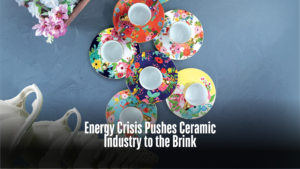
Energy Crisis Pushes Ceramic Industry to the Brink
Bangladesh’s ceramic industry is facing one of its toughest periods in decades, as soaring gas prices and unstable energy supply strain production and profitability. Between 2015 and 2023, gas prices in the manufacturing sector surged by about 345 percent, including a 150 percent hike in 2023 alone. This escalation has raised production costs by 18-20 percent, since gas serves as both a key energy source and raw material. Yet, producers cannot freely increase prices due to competition from cheaper imports, forcing many factories into losses. The government is now considering another 152 percent gas price hike, which could raise rates to Tk 30-75.72 per cubic meter, further lifting costs by 30-35 percent and impacting other major sectors. Unstable Gas Supply and Factory Shutdowns For ceramic producers, a consistent gas supply is vital, as the industry depends on a 24-hour flow at steady pressure—around 15 PSI—for uninterrupted kiln operation. In reality, however, gas pressure often drops to 2–3 PSI or even zero, halting production. Despite paying full rates, factories in hubs such as Savar, Dhamrai, Rupganj, Tongi, Gazipur, Narsingdi, and Mymensingh face frequent disruptions, with 20–25 units affected daily, causing losses of about Tk 20 crore and export order cancellations. BCMEA President: The Sector Is Under Severe Pressure “Currently, the country’s ceramic manufacturers are grappling with a sharp decline in sales and rising production costs amid unstable gas supply and a sluggish construction sector,” said Moynul Islam, president of the Bangladesh Ceramic Manufacturers and Exporters Association (BCMEA). He explained that gas shortages and high fuel costs have pushed production expenses up by 18-20 percent, forcing many factories to reduce output and offer deep discounts just to stay in business. “The ceramics sector is under severe pressure,” he said. Islam highlighted that the industry plays a crucial role in employment generation and foreign exchange earnings. “Lead (Pb) and Cadmium (Cd)-free tableware and affordable sanitary ware are essential for modern living. Bangladesh needs affordable tiles, tableware, sanitary ware, and ceramic bricks to meet domestic demand and support our $1 billion monthly foreign currency inflow. This prominent sector employs millions and still has scope for further investment.” “When gas supply drops, factories switch to alternative fuels, which significantly increase costs. Profit margins have shrunk, and some producers are even running at a loss,” he added. According to BCMEA estimates, sales of tiles, sanitary ware, and tableware have fallen by 15-40 percent since mid-2024. “After the fall of the Awami League government during the ‘July Uprising’ last year, the artificial economic bubble burst, weakening demand for construction materials. Many projects slowed, and the private housing market cooled. As a result, factories are operating well below capacity, with unsold goods piling up in warehouses,” said Islam. He added that the entire construction value chain—including cement, steel, and ceramics—has been affected by the broader economic slowdown. “If development projects regain momentum and gas supply stabilises, the market will gradually recover. We expect business confidence to return once these challenges are addressed,” the BCMEA president said. Energy Sector Woes Compound the Crisis Shafiqul Alam, lead energy analyst for Bangladesh at the Institute for Energy Economics and Financial Analysis (IEEFA), said all industrial sectors, including ceramics, are suffering due to energy supply disruptions or reduced supply. “Bangladesh’s growing reliance on the international fossil fuel market—now accounting for about 56 percent of total energy supply—has made the system highly vulnerable to global price shocks,” he said. Although energy efficiency has improved in industries, there is untapped potential too. Further, transmission and distribution losses in the gas sector remain significant. “Had these losses been minimized, the gas shortage facing industries could have been slightly reduced,” Shafiqul noted. He added that despite several gas price hikes at industrial levels, supply to industries remains insufficient. For the ceramics industry, he recommended improving kiln efficiency and enhancing energy efficiency in captive power generation by utilizing waste heat to cut energy use and costs. Fiscal and Policy Burdens Beyond the gas crisis, the ceramic industry faces additional challenges from import delays, high raw material costs, and steep bank interest rates. Compounding these pressures are additional duties—currently 15 percent on locally made tiles and 10 percent on sanitary ware—that make domestic products less competitive. Industry leaders argue that these duties are counterproductive, as ceramic goods are no longer luxury items but basic necessities for hygienic living. High taxes, they warn, may deprive citizens of affordable sanitation products and undermine the government’s “Sanitation for All” initiative. The BCMEA has urged policymakers to refrain from further gas price hikes for industrial users, ensure uninterrupted gas supply at stable pressure levels, and withdraw additional duties on local ceramic products. Policy and Renewable Solutions Dr. Masrur Reaz, chairman of Policy Exchange Bangladesh (PEB), believes the ceramic sector still holds “immense potential,” but supportive policies are crucial. “Despite skilled workers, a growing domestic market, and strong international demand, the industry has yet to reach its full potential due to unsupportive policies,” said Dr. Reaz. “Even with modern technology and efficient management, factories suffer daily losses when gas pressure drops or supply is disrupted. Additional duties also make local products less competitive than imports.” He urged the government to recognise the industry’s strategic role in employment, exports, and infrastructure. “Practical steps—such as halting further gas price hikes, ensuring stable supply, and reviewing duties on local tiles and sanitaryware—are essential to stabilise the sector.” Dr. Reaz also advocated renewable energy as a sustainable solution. “Installing solar panels on rooftops or open land allows ceramic manufacturers to generate their own power, reduce gas dependence, cut costs, and promote eco-friendly production.” He noted Bangladesh’s strong export potential, especially in South Asia, the Middle East, and the United States, where tariffs are more favourable. “Removing internal barriers, fostering innovation, and expanding exports can unlock the industry’s full
Read More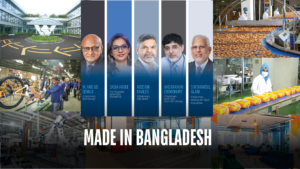
MADE IN BANGLADESH: Homegrown Champions of Change
Bangladesh’s meteoric rise in the global garment industry has long been admired, and now a deeper transformation is underway — one that reflects diversification, resilience, and ambition. Amid global supply chain realignments and rising manufacturing costs in East Asia, Bangladesh has emerged as one of the world’s most export-ready economies. But beyond the looms and threads, “Made in Bangladesh” businesses are stepping into the spotlight — from green technology and agribusiness to pharmaceuticals and consumer goods. It’s time the world pays closer attention to the homegrown brands proudly carrying the “Made in Bangladesh” label. The list is far from exhaustive, as Bangladesh is home to many more brands that deserve global recognition. In this special feature, we bring into focus five companies and visionaries who have not only grown with the country but have also redefined what it means to be a “Made in Bangladesh” business. From expanding beyond borders to competing with international players, their journeys reflect the spirit of a nation that refuses to be boxed in. A common thread binds them all — a relentless desire to rise despite the odds. To begin the story, there is none other than Anis Ud Dowla, the visionary chairman of ACI Group. A pioneer in every sense, Dowla represents the kind of leadership that has helped redefine the possibilities of Bangladeshi enterprise. Next comes Hossain Khaled, Chairman of City Bank. This visionary banker played a crucial role in transforming a struggling bank with weak financials into one of the top lenders in the country. From the travel and tourism field, Sadia Haque — co-founder and CEO of ShareTrip — steals the spotlight with her innovations in the sector. The full-stack travel solutions her firm offers have brought about a massive change in the tourism landscape of Bangladesh. No story on Bangladesh would be complete without mentioning Ahsan Khan Chowdhury, chairman and CEO of Pran-RFL Group — a perfect example of how a legacy can be nurtured and turned into an empire. And last but not least, Walton Hi-Tech Industries PLC — the first Bangladesh-origin company to ship electrical and electronic appliances to international markets — stands as a testament to the nation’s growing industrial prowess. Let’s explore the trailblazers behind the “Made in Bangladesh” renaissance. A Beacon of Principled Leadership In Bangladesh’s corporate history, few names command as much respect as M. Anis Ud Dowla. At a time when business and politics often converge, Dowla has carved a distinct path—one rooted in ethics, innovation, and an unwavering commitment to national progress. His career began not in boardrooms but in the field, as a young executive with British Oxygen. Over nearly three decades, he rose through the ranks, managing operations across Pakistan, Kenya, and Bangladesh. That global exposure laid the foundation for a leadership style defined by experimentation and efficiency. The defining moment came in 1992, when Imperial Chemical Industries (ICI) offered him a chance to take over its Bangladesh operations. The deal was unconventional: a “pay-as-you-earn” arrangement that required no upfront capital. Dowla accepted, and Advanced Chemical Industries (ACI) was born. “The beginning was challenging, but I made sure that no matter what, I would remain fair to my workers,” Dowla said. “I assured them that they would receive a fair share of the benefits for the efforts they were putting in. It was a 60:40 profit-sharing arrangement between the investors and workers. And it paid off.” From modest beginnings with just 352 employees, ACI has grown into one of the country’s largest conglomerates, now employing over 30,000 people across 29 subsidiaries. Its portfolio spans pharmaceuticals, consumer goods, agribusiness, and logistics. Under Dowla’s leadership, ACI became the first Bangladeshi company to earn ISO 9001 certification, setting a benchmark for quality and transparency. “I wanted to have a guardian who would ensure that there was no compromise in quality. The ISO certificate did that for me. They used to visit ACI, conduct audits, and help me produce quality products every time.” “I went for the certificate to fulfil my dream of remaining true to our customers and never deceiving anyone in any way.” Despite his success, Dowla remains grounded. His philosophy centres on values—quality, fairness, customer focus, and continuous improvement. These principles, he insists, are not slogans but lived realities within the company. Dowla’s views on politics are equally clear-cut. He believes that mixing business with political ambition undermines merit and compromises governance. “I strongly believe entrepreneurs should not enter politics, and politicians should not be entrepreneurs.” For Dowla, politics is a service, not a career path for entrepreneurs. At ACI, employees are treated as family. The ACI chairman sees leadership as a process of unlocking human potential. To young entrepreneurs, his advice is simple yet profound: pursue what you love, embrace failure as a lesson, and never settle for shortcuts. Even in his late eighties, Dowla remains active, drawing energy from ideas rather than rest. In an era of blurred boundaries and shifting values, Anis Ud Dowla stands as a beacon of principled leadership—an icon admired not just for what he built, but for how he built it. From Startup to Market Leader When Sadia Haque set out to build a travel platform, her vision was rooted in something deeper than bookings and itineraries. “We wanted a travel tech platform where everything would be shared,” said the ShareTrip CEO and Co-Founder. “Sharing of adventure, sharing of experience, sharing of laughter, and sharing of joy. And from that perspective, the name came as ShareTrip.” That philosophy of connection would go on to shape one of Bangladesh’s most successful digital ventures. Drawing on her background in telecoms, media, and technology, Haque channelled over a decade of corporate experience into a startup that would soon redefine how the country travels.
Read More
Welcome to the World of Ceramics
Once a quiet corner of the industrial map, Bangladesh’s ceramic sector has sculpted its way into the spotlight. Over the past decade, the industry has witnessed an extraordinary 150 percent surge in both production and investment, transforming it from a modest manufacturing niche into a vibrant engine of growth. It’s a milestone that marks the rise of a sector now central to the country’s architectural identity. That journey now enters a new chapter with the return of Ceramic Expo Bangladesh 2025, the flagship event of the Bangladesh Ceramic Manufacturers and Exporters Association (BCMEA). From November 27 to 30, the International Convention City Bashundhara (ICCB) in Dhaka will transform its Pushpanjali – Hall 5 into a showcase of ceramic excellence—bringing together over 136 exhibitors, 300 brands, and more than 25,000 visitors under one roof, with the support of the Export Promotion Bureau (EPB), Techna, ASEAN Ceramics, Keramika Indonesia, and Ceramic China. Now in its fourth edition, the expo has grown into one of South Asia’s most influential B2B platforms, drawing over 500 foreign delegates and participants from 25 countries. “This is Bangladesh’s only international exhibition dedicated to ceramics,” said Irfan Uddin, general secretary of BCMEA and chairman of Ceramic Expo Bangladesh. “With 31 local manufacturers and 105 global exhibitors, the expo creates unmatched opportunities for partnership, investment, and growth.” From raw materials to robotics, from sustainable kilns to smart design, the expo promises a panoramic view of what’s next in ceramic innovation. GLOBAL AND LOCAL EXHIBITORS The 2025 edition of the ceramic expo has a long list of local and foreign exhibitors. Every local ceramic company will join the show, along with international participants—most of which are raw material, machinery, or tech suppliers. Every participant of the expo has high hopes for Bangladesh’s ceramic industry. Kutubuddin Ahmed, chairman of Sheltech Ceramics Ltd, said the ceramic industry in Bangladesh is entering a new era driven by talent, quality, and a growing domestic market. “Ceramic Expo Bangladesh 2025 is the perfect platform to experience this progress.” Leading Chinese company Foshan HLT & DLT Technology Co. Ltd also believes ceramics have every potential to be the next big export earner for Bangladesh, said Marco Guan, deputy managing director of HLT & DLT and chairman of DLT, a supplier of engineering design, machinery, and technical know-how. Sacmi Imola S.C. (SALA), a global ceramic technology leader, sees Bangladesh’s strong entrepreneurial spirit and technical expertise as key to becoming a global hub. Despite challenges like energy costs, infrastructure gaps, and banking inefficiencies, local ceramic companies show resilience, long-term vision, and a focus on quality over price wars, the company said. SPONSORS Leading local ceramic company Sheltech Ceramics Ltd is the principal sponsor of this year’s Ceramic Expo, while there are three platinum sponsors: DBL Ceramics Ltd, Akij Ceramics Ltd, and Meghna Ceramic Ind. Ltd. The 2025 edition has four gold sponsors: Mir Ceramic Ind. Ltd and Abul Khair Ceramic Ind. Ltd from the local market, and Sacmi Imola S.C. (SALA) and Foshan HLT & DLT Technology Co., Ltd. from the foreign market. FOUR DAYS OF CERAMIC ACTIVITY “At Ceramic Expo Bangladesh 2025, local technicians will directly engage with global exhibitors to find real-time solutions,” said Moynul Islam, president of BCMEA. “It’s the world’s only trade fair uniting both Chinese and European ceramic giants under one roof.” Dealers’ Night One of the standout moments at Ceramic Expo Bangladesh 2025 will be the Dealers’ Night, a grand gathering designed to celebrate the people who carry the industry’s story to every corner of the country. More than just a networking event, Dealers’ Night will serve as a recognition of the sales leaders, distributors, and retail partners who bridge the gap between manufacturers and consumers. The evening will bring together over 200 dealers, sales professionals, and more than 20 industry leaders from across Bangladesh, creating a vibrant forum for exchange, collaboration, and celebration. It is here that the industry’s “deal-breakers” will share experiences, discuss market trends, and explore strategies to expand the reach of Bangladeshi ceramics both locally and globally. The BCMEA is organising the event with a clear vision: to honour the dealers and salespersons as the torchbearers of the ceramic industry. Their role is not limited to transactions; they are the storytellers who translate innovation into demand, and the ambassadors who ensure that Bangladesh-made ceramics find their way into homes, offices, and institutions. Seminars Every day at Ceramic Expo Bangladesh 2025 won’t just be about booths and business cards—it’ll be buzzing with ideas. Alongside the packed exhibition halls, multiple seminars will dive into the real issues shaping the future of Bangladesh’s ceramic industry. With over 70 manufacturers investing nearly $2 billion and more than 60,000 people directly involved, these conversations matter. From energy costs to export hurdles, topics that often go unheard will finally take center stage—thanks to open discussions between industry leaders, policymakers, and professionals. The seminars are: Energy Efficiency Strategies for Industry in Bangladesh: Challenges and Opportunities This seminar will explore how Bangladesh’s ceramic industry can adopt renewable energy, improve efficiency, and reduce costs. Experts will highlight practical solutions, policy frameworks, and global best practices to ensure sustainable growth amid rising energy challenges. Skills Development for Sustainable Growth in Industry Focused on workforce transformation, this session will examine training, technical education, and innovation-driven skill sets. Industry leaders and policymakers will discuss how nurturing talent can strengthen competitiveness, empower youth, and secure long-term sustainability for Bangladesh’s ceramic sector. Global Market Strategies: Challenges and Opportunities for Ceramic Products This seminar will analyze export diversification, branding, and competitiveness in international markets. Discussions will address trade barriers, logistics, and evolving consumer preferences, while showcasing strategies to position Bangladeshi ceramics as a global leader in quality and innovation. B2B / B2C Meetings The fair will offer ample space for B2B and B2C meetings, enabling local and global
Read MoreWelcome to the World of Ceramics
Once a quiet corner of the industrial map, Bangladesh’s ceramic sector has sculpted its way into the spotlight. Over the past decade, the industry has witnessed an extraordinary 150 percent surge in both production and investment, transforming it from a modest manufacturing niche into a vibrant engine of growth. It’s a milestone that marks the rise of a sector now central to the country’s architectural identity. That journey now enters a new chapter with the return of Ceramic Expo Bangladesh 2025, the flagship event of the Bangladesh Ceramic Manufacturers and Exporters Association (BCMEA). From November 27 to 30, the International Convention City Bashundhara (ICCB) in Dhaka will transform its Pushpanjali – Hall 5 into a showcase of ceramic excellence—bringing together over 136 exhibitors, 300 brands, and more than 25,000 visitors under one roof, with the support of the Export Promotion Bureau (EPB), Techna, ASEAN Ceramics, Keramika Indonesia, and Ceramic China. Now in its fourth edition, the expo has grown into one of South Asia’s most influential B2B platforms, drawing over 500 foreign delegates and participants from 25 countries. “This is Bangladesh’s only international exhibition dedicated to ceramics,” said Irfan Uddin, general secretary of BCMEA and chairman of Ceramic Expo Bangladesh. “With 31 local manufacturers and 105 global exhibitors, the expo creates unmatched opportunities for partnership, investment, and growth.” From raw materials to robotics, from sustainable kilns to smart design, the expo promises a panoramic view of what’s next in ceramic innovation. GLOBAL AND LOCAL EXHIBITORS The 2025 edition of the ceramic expo has a long list of local and foreign exhibitors. Every local ceramic company will join the show, along with international participants—most of which are raw material, machinery, or tech suppliers. Every participant of the expo has high hopes for Bangladesh’s ceramic industry. Kutubuddin Ahmed, chairman of Sheltech Ceramics Ltd, said the ceramic industry in Bangladesh is entering a new era driven by talent, quality, and a growing domestic market. “Ceramic Expo Bangladesh 2025 is the perfect platform to experience this progress.” Leading Chinese company Foshan HLT & DLT Technology Co. Ltd also believes ceramics have every potential to be the next big export earner for Bangladesh, said Marco Guan, deputy managing director of HLT & DLT and chairman of DLT, a supplier of engineering design, machinery, and technical know-how. Sacmi Imola S.C. (SALA), a global ceramic technology leader, sees Bangladesh’s strong entrepreneurial spirit and technical expertise as key to becoming a global hub. Despite challenges like energy costs, infrastructure gaps, and banking inefficiencies, local ceramic companies show resilience, long-term vision, and a focus on quality over price wars, the company said. SPONSORS Leading local ceramic company Sheltech Ceramics Ltd is the principal sponsor of this year’s Ceramic Expo, while there are three platinum sponsors: DBL Ceramics Ltd, Akij Ceramics Ltd, and Meghna Ceramic Ind. Ltd. The 2025 edition has four gold sponsors: Mir Ceramic Ind. Ltd and Abul Khair Ceramic Ind. Ltd from the local market, and Sacmi Imola S.C. (SALA) and Foshan HLT & DLT Technology Co., Ltd. from the foreign market. FOUR DAYS OF CERAMIC ACTIVITY “At Ceramic Expo Bangladesh 2025, local technicians will directly engage with global exhibitors to find real-time solutions,” said Moynul Islam, president of BCMEA. “It’s the world’s only trade fair uniting both Chinese and European ceramic giants under one roof.” Dealers’ Night One of the standout moments at Ceramic Expo Bangladesh 2025 will be the Dealers’ Night, a grand gathering designed to celebrate the people who carry the industry’s story to every corner of the country. More than just a networking event, Dealers’ Night will serve as a recognition of the sales leaders, distributors, and retail partners who bridge the gap between manufacturers and consumers. The evening will bring together over 200 dealers, sales professionals, and more than 20 industry leaders from across Bangladesh, creating a vibrant forum for exchange, collaboration, and celebration. It is here that the industry’s “deal-breakers” will share experiences, discuss market trends, and explore strategies to expand the reach of Bangladeshi ceramics both locally and globally. The BCMEA is organising the event with a clear vision: to honour the dealers and salespersons as the torchbearers of the ceramic industry. Their role is not limited to transactions; they are the storytellers who translate innovation into demand, and the ambassadors who ensure that Bangladesh-made ceramics find their way into homes, offices, and institutions. Seminars Every day at Ceramic Expo Bangladesh 2025 won’t just be about booths and business cards—it’ll be buzzing with ideas. Alongside the packed exhibition halls, multiple seminars will dive into the real issues shaping the future of Bangladesh’s ceramic industry. With over 70 manufacturers investing nearly $2 billion and more than 60,000 people directly involved, these conversations matter. From energy costs to export hurdles, topics that often go unheard will finally take center stage—thanks to open discussions between industry leaders, policymakers, and professionals. The seminars are: Energy Efficiency Strategies for Industry in Bangladesh: Challenges and Opportunities This seminar will explore how Bangladesh’s ceramic industry can adopt renewable energy, improve efficiency, and reduce costs. Experts will highlight practical solutions, policy frameworks, and global best practices to ensure sustainable growth amid rising energy challenges. Skills Development for Sustainable Growth in Industry Focused on workforce transformation, this session will examine training, technical education, and innovation-driven skill sets. Industry leaders and policymakers will discuss how nurturing talent can strengthen competitiveness, empower youth, and secure long-term sustainability for Bangladesh’s ceramic sector. Global Market Strategies: Challenges and Opportunities for Ceramic Products This seminar will analyze export diversification, branding, and competitiveness in international markets. Discussions will address trade barriers, logistics, and evolving consumer preferences, while showcasing strategies to position Bangladeshi ceramics as a global leader in quality and innovation. B2B / B2C Meetings The fair will offer ample space for B2B and B2C meetings, enabling local and global
Read More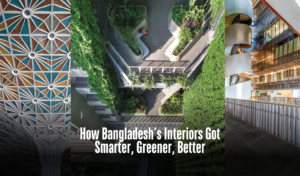
How Bangladesh’s Interiors Got Smarter, Greener, Better
Over the past decades, Bangladesh’s interior sector has undergone a steady evolution. This progressive transformation in design trends and practices is significant across all sectors, including residential, industrial, healthcare, hospitality, retail, and commercial spaces. Rapid urbanisation, economic growth, globalisation, cultural exposure, and growing concern for sustainability are the major forces driving the interior design shift. Changing Residential Interior As urbanisation accelerates, a gradual shift in housing typology has emerged. Traditional single-storey houses and bungalows are being replaced by denser urban structures and micro-apartments, particularly in major cities such as Dhaka and Chittagong. As a result, residential units are now designed with more compact and efficient layouts. To maximise functionality, designers incorporate space-saving solutions, including wall-mounted shelving, built-in storage, and modular furniture. As plots shrink and outdoor gardens become scarce, balconies and terraces are being converted into green oases that help bring nature indoors. In terms of design styles, interior spaces now reflect greater diversity, ranging from minimalist and modern to contemporary and fusion. Collectively, these factors are redefining residential interiors as more functional, sustainable, and visually harmonious. Shift in Commercial Design In the early to mid-20th century, commercial interiors were formal and compartmentalised, with enclosed rooms and long corridors. Materials such as wood and marble were used to convey permanence and formality. By the late 20th century, the rise in corporate culture and global trends led to the emergence of open-plan layouts. Rigid walls began to be replaced by glass partitions that fostered communication and a transparent working environment. From the 2010s onward, corporate interiors started to prioritise sustainability and employee wellbeing. Concepts such as biophilic design and eco-friendly materials, including reclaimed wood and recycled components, are now being incorporated to improve air quality. The Decathlon’s Dhaka office designed by Studio One Zero, is a perfect example of a workspace that blends nature and smart design seamlessly. “What truly distinguishes the office space is its deliberate, sensitive incorporation of natural elements into an urban setting. We wanted the overall design to be meaningful and experiential” ,says Jafor Hoq, chief architect of Studio One Zero. Embracing Tech-led Designs Bangladesh’s industrial interiors—especially in RMG, tanneries, food processing, and other sectors—have drastically changed over the past 50 years. Early factories were built with tight production floors, poor lighting and ventilation, and minimal worker amenities. As industries began to rise, manufacturers moved towards vertical integration (cutting, dyeing/finishing, warehousing, R&D/sample rooms). This initiative introduced a major shift in industrial interiors; however, worker facilities remained basic. The Rana Plaza collapse in 2013 led to a surge of inspections and safety retrofits, resulting in changes to fire safety systems, marked aisles, medical rooms, and improved workstation ergonomics. New industries now increasingly integrate life-safety upgrades (fire doors, fire escape signage), clear zoning, and worker-welfare blocks (cleaner toilets, canteens, and childcare rooms). Energy-efficient LED lighting, water-saving fixtures, and other green building strategies are being adopted. According to the Bangladesh Garment Manufacturers and Exporters Association (BGMEA), the country boasts 258 LEED-certified factories, including 109 Platinum and 133 Gold-rated facilities. Institutional interiors in Bangladesh have also undergone significant transformation, shaped by both local and global design trends in architecture, technology, and educational philosophy. Earlier universities featured classic, colonial-style architecture, such as the University of Dhaka. Over time, university interiors shifted towards creating more flexible and student-centric spaces. Classrooms today are equipped with modern technologies such as multimedia projectors and smartboards. Moreover, charging stations and internet access points are being integrated into common spaces—libraries, lounges, and cafeterias. Sustainable design practices have become one of the most significant considerations over the decades. For example, BRAC University has incorporated biophilic design principles, eco-friendly materials, and energy-efficient systems. The university adopts modern colour schemes and diverse textures, along with more student-friendly amenities that promote collaboration and creativity. Hospitality and Public Spaces Blending Global Aesthetics Early hotels (during the 1960s–1980s) in Bangladesh prioritised functionality over aesthetics, often shaped by a colonial-modern architectural approach. Interior layouts were formal, with minimal ornamentation and durable finishes such as terrazzo floors and simple wooden or rattan furniture. In the 1990s–2000s, with the arrival of international brands, interiors shifted towards a contemporary design approach. Spaces became more refined, introducing upgraded amenities, grand lobbies and ballrooms, and heavy use of imported finishes and materials. A significant example of a luxury hotel is the new Sheraton Dhaka, designed by Volumezero Ltd. It features grand lobbies and banquets, lavish dining venues, and premium materials and finishes. From 2010 onwards, hotel and resort design began to blend local cultural elements with global contemporary styles. This includes the use of local craftsmanship, textiles, motifs, and artwork. Sustainable materials such as bamboo and jute, along with natural textures like wood finishes and earthy plasters, are now extensively used. Public spaces such as airports in the early period focused primarily on practicality and functionality. For example, the old Tejgaon Airport and early Hazrat Shahjalal International Airport (HSIA) featured simple layouts with limited amenities. With gradual modernisation, airport interiors began to prioritise passenger comfort. Duty-free shops, cafés, lounges, and digital flight displays have been incorporated. From the 2010s to the present, design has integrated modern efficiency with local art and aesthetics. Elements include modern amenities (digital signage, self-scanners), imported materials, and sustainable finishes. A prominent example is HSIA Terminal 3, designed by architect Rohani Baharin. The design incorporates modern minimalism and local cultural motifs, highlighting clean, light-toned finishes, large open spaces, and high vaulted ceilings with an eye-catching floral geometric motif. Natural lighting is emphasised, reducing dependence on harsh artificial lighting. Another prominent example in the transformation of public transport infrastructure is the new Cox’s Bazar Railway Station, designed by Volumezero Ltd. The transportation hub has evolved from a functional terminal into a high-end passenger experience. “We aimed to depart from the traditional notion of railway stations being merely standard
Read More
BANKS BRUISED but Still Standing Strong for Manufacturing
Bruised by inflation, foreign exchange volatility, and a surge in non-performing loans, Bangladesh’s banking sector has nonetheless held its ground — emerging as the country’s lone financial engine in a year of global and domestic disruption. With the capital market still lacklustre, banks have shouldered the full weight of financing both government and private enterprise, keeping the wheels of development turning. In 2024, the sector showed remarkable grit, navigating macroeconomic turbulence while maintaining liquidity and credit flow across industries. This resilience was not just structural — it was strategic. As investor sentiment cooled, the private sector leaned harder on banks, reaffirming their role as the backbone of Bangladesh’s economic recovery. Profits Surge as Six Banks Break Records Performance-wise, several private commercial banks surged ahead, with six institutions — BRAC Bank, Pubali Bank, Jamuna Bank, Bank Asia, Shahjalal Islami Bank, and Dhaka Bank — surpassing their entire 2024 profit figures within just the first nine months of 2025 — a testament to operational strength and depositor confidence. Combined, these banks earned Tk 7,411 crore from investments, mostly in treasury bonds — a roughly 70 percent increase from the previous year. Moreover, BRAC Bank and City Bank crossed the Tk 1,000 crore profit mark in 2024 for the first time in the country’s banking history, while others recorded their highest-ever earnings. Sustainability Ratings Reflect Governance Strength Recognizing this momentum, Bangladesh Bank named 10 banks and two non-bank financial institutions (NBFIs) as sustainable performers in its Sustainability Rating 2024. The banks include BRAC Bank, City Bank, Dutch-Bangla Bank, Eastern Bank, Jamuna Bank, Mutual Trust Bank, NCC Bank, Prime Bank, Pubali Bank, and Shahjalal Islami Bank. Among NBFIs, IDLC Finance and IPDC Finance retained their positions. These 12 institutions were evaluated across five key indicators: the sustainable finance index, CSR activities, green project financing, the core banking sustainability index, and banking services coverage. Banks with strong risk management, healthy capital adequacy, and low non-performing loans scored higher, while metrics like Tier-1 capital to risk-weighted assets, CMSME loan share, large-loan exposure, and agent banking reach added depth to the rankings. The sector also saw moderate asset growth, with total assets rising 9.65% in 2024 to Tk 26,29,775 crore — reversing declines from 2021 and 2022, according to the central bank’s Financial Stability Report. Liquidity remained sound, with the Advance-to-Deposit Ratio at 81.55% — well below the 87% ceiling — while strong deposit growth continued to fuel rising loan demand. In a year defined by uncertainty, Bangladesh’s banking sector didn’t just endure — it evolved. With sustainability, profitability, and resilience converging, it has reaffirmed its role as the country’s principal engine of financial stability and growth. Governance: The Line Between Success and Struggle “Some banks in the banking sector have performed very well, while others have done quite poorly,” said Syed Mahbubur Rahman, CEO and Managing Director of Mutual Trust Bank. “The main factor behind weak performance in some banks is governance — banks with better governance have performed better. Those where the Board of Directors interfered in day-to-day operations have not done well,” he said. On the other hand, banks that followed proper corporate governance practices have consistently performed well, and their non-performing loans have remained within limits, he added. The sluggish pace of NPL recovery has also contributed to the accumulation of NPLs. Additionally, the Russia-Ukraine war, global tensions, local currency depreciation, and other domestic economic challenges are straining business operations and reducing borrowers’ repayment capacity — further accelerating the banking sector’s NPLs in Bangladesh, according to Bangladesh Bank’s Financial Stability Report. Even though some banks have underperformed, the banking sector has made a major contribution to the economy — especially as the capital market remains small and its role in capital formation negligible, he said. The bond market is also nearly non-existent. Since independence, industrialisation, employment, and per capita income growth have been supported 80–90 percent by the banking sector, directly and indirectly, he clarified. Banks have facilitated letters of credit for trade, enabled remittance inflows, and provided refinancing during Covid-19. From agricultural loans to start-up financing, the sector has stepped in whenever funding was needed. Most CSR spending in the country also comes from banks. “The banking sector is definitely playing a significant role in overall economic activity,” he said. “The banks are contributing to sustainable finance too,” added Rahman, also a former president of the Association of Bankers, Bangladesh (ABB). Some banks are doing extraordinarily well in increasing their sustainable and green financing. Toufic Ahmad Choudhury, a former Director General (DG) of the Bangladesh Institute of Bank Management (BIBM), said that although there were high NPLs in the banking sector “under the carpet,” which were not previously disclosed, the poor health of some banks is now clear. “This is a positive sign that the problem of some banks is now diagnosed.” Most importantly, the central bank is focusing on the banking sector to ensure good governance in every bank. “It is another good sign that good governance is now being ensured across the sector,” he said. Regarding the merger of five banks, he said that if new leadership can boost public confidence and the government does not interfere unnecessarily, only then can the banks be revived. Depositor Confidence and the Road to Reform Banking sector deposits registered an average annual growth rate of 7.69 percent by the end of 2024, compared to 10.15 percent the year prior, according to Bangladesh Bank data. Deposit growth slowed mainly due to high inflation and a confidence crisis in several banks. Inflation in Bangladesh has hovered above 9 percent since May 2023, and stood at 8.36 percent in September 2025. Among asset managers who invest in bank shares and analyse their performance most closely is Mir Ariful Islam, CEO and Managing Director of Sandhani Asset Management. He said some banks saw significantly
Read More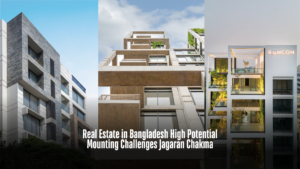
Real Estate in Bangladesh High Potential Mounting Challenges
Bangladesh’s real estate sector stands at a defining moment. With an annual housing demand of nearly 100,000 new apartments and rapid urbanisation, the sector holds enormous promise. Yet affordability, regulatory constraints, volatile economic conditions, and weak financing continue to hold it back. As cities like Dhaka and Chattogram sprawl under population pressure, a more inclusive, well-regulated, and investor-friendly environment is crucial to unlock the sector’s full potential. Industry leaders and analysts agree that timely reforms and coordinated strategies are vital for steering real estate towards sustainable growth. A Burgeoning Market Over the past two decades, Bangladesh has seen unprecedented urbanisation, driven by rural-to-urban migration. Dhaka alone absorbs around 300,000 new residents each year, fuelling soaring demand for both residential and commercial spaces. “We developers have the capacity to meet the entire demand,” said FR Khan, managing director of Building Technology and Ideas (bti). Yet the current supply meets only about 8 percent of annual demand, revealing both opportunity and inefficiency. At the same time, housing preferences are shifting. Buyers are seeking wellness-focused, eco-friendly and community-oriented living rather than plain apartments, reflecting changing lifestyles and higher expectations. Affordability and Rising Costs Homeownership remains out of reach for most middle-income families due to high borrowing costs. Mortgage rates of 12 to 13 percent make long-term loans unaffordable, while the standard 30 percent down payment blocks many aspiring buyers. In a high-inflation economy where daily living costs keep rising, saving for such an amount is nearly impossible. “Even those with stable jobs and moderate incomes can’t commit to housing loans due to high rates and economic uncertainty,” said M Hoque Faisal, director of sales and marketing at Tropical Homes Ltd. “What we need is a subsidised loan scheme for the middle class—say, at 5 percent interest.” Most banks cater to high-net-worth clients, leaving middle-income households with limited financing options. Without tailored financial products, millions remain excluded from the housing market. Rising construction costs and land scarcity have worsened the crisis. Fluctuating exchange rates and higher VAT and customs tariffs on materials such as steel, lifts, and cement have sharply pushed up costs. The taka’s depreciation against the US dollar has further compounded the problem. Land acquisition in urban areas is also becoming prohibitively expensive. “Shortage of land is making investors pay a fortune,” said M Mahbubur Rahman, CEO of Rupayan City. These twin pressures have squeezed developer margins and pushed housing prices even higher. Economic and Political Instability Real estate is highly sensitive to broader economic and political trends. Inflation, currency instability, and election-year uncertainty have all dampened investor confidence. According to Bangladesh Bank data, outstanding construction loans fell to Tk 1.23 trillion during April–June FY2024–25, down from Tk 1.26 trillion in the previous quarter. Residential housing loans for urban buyers dropped by 3.96 percent, while infrastructure loans declined by 2.05 percent. “Banks and developers are becoming increasingly cautious,” said economist Dr Masrur Reaz. “Commercial housing has shown resilience due to higher margins, but overall lending has slowed, signalling a contraction in the sector.” The DAP Controversy The Detailed Area Plan (DAP), introduced by Rajuk in 2022, has sparked heated debate among developers. The main concern is the Floor Area Ratio (FAR), which limits how many units can be built on a plot. “While the DAP is academically sound, it doesn’t account for the dense, historic nature of Dhaka,” said FR Khan. “It’s based on planning models from low-density, developed cities.” Since the DAP’s implementation, over 200 industries connected to real estate have been affected, according to the Real Estate and Housing Association of Bangladesh (REHAB). Landowners are increasingly reluctant to offer their property for joint ventures, citing reduced profitability under stricter zoning and height limits. REHAB has formally urged the government to revise the DAP to reflect Dhaka’s ground realities and revive sectoral momentum. Market Trends and Opportunities Even as high-end housing demand cools amid declining purchasing power, the mid-market segment is expanding. Many people are investing in real estate to hedge against inflation, viewing property as a safer long-term asset. Rental yields in Dhaka and Chattogram have remained relatively stable. The sector is also a major employment driver—ranking as the country’s third-largest employer—and supports industries such as cement, steel, transport, and home electronics. In 2020, the government’s policy allowing undeclared income to flow into real estate channelled over Tk 20,000 crore into the sector, generating Tk 2,000 crore in tax revenue. Sustainability: A Growing Focus Environmental awareness is reshaping real estate practices. The Bangladesh National Building Code (BNBC) now promotes energy-efficient designs, rainwater harvesting, and sustainable materials. Green-certified buildings appeal to climate-conscious buyers and help developers access international green financing. Policy Roadmap for Reform To unlock the sector’s full potential, experts call for coordinated action between the government and private developers. Home loans must become more affordable through lower interest rates, while fixed-rate mortgage options can shield buyers from rate volatility. Raising loan-to-value ratios would let buyers borrow a greater share of property value. Bangladesh Bank could introduce targeted credit lines for first-time and middle-income buyers to expand access to financing. Registration fees and stamp duties should be reduced to encourage participation in the formal housing market. Lower VAT and import duties on materials would cut construction costs. Tax rebates or subsidies for first-time buyers, especially from middle-income brackets, would make ownership more achievable. The DAP’s FAR and zoning rules need to better reflect Dhaka’s urban density. Increasing FAR in suburban and peri-urban areas would promote growth beyond the city centre, while planning models should align with Bangladesh’s infrastructure capacity and population dynamics. Investment in satellite towns equipped with schools, hospitals, markets, and transport links would ease pressure on Dhaka and Chattogram. Strengthening inter-city connectivity and ensuring public services and job opportunities outside major cities would support balanced regional development. Licensing and
Read More
Bangladesh A Champion in Green Sustainable Manufacturing
Bangladesh’s garment industry, once marred by tragedy and global scrutiny, is now leading a quiet revolution in sustainable manufacturing. The world’s second-largest producer of readymade garments, the south Asian nation is currently home to the highest number of green factories in the world. The change did not come overnight. From being hit by twin disasters that damaged the country’s global image to emerging as a frontrunner in green production, the journey was far from smooth. From solar-powered facilities to water-saving technologies, local manufacturers have embraced environmental compliance not just to rebuild trust—but to redefine Bangladesh’s role in the global supply chain. A decade ago, in the wake of the Tazreen Fashion fire and the Rana Plaza collapse, the garment sector suffered a severe reputational blow. End consumers began chanting slogans against Bangladeshi garments, claiming the clothes were blood-stained, and started avoiding locally made apparel. As a result, both international clothing retailers and brands, as well as local manufacturers and suppliers, faced trouble as the inflow of work orders declined after the crisis. However, Western consumers’ buying behaviour was also changing at that time, as they began preferring products made with environmental protection in mind and in adherence to higher compliance standards. Retailers, brands, and local manufacturers capitalised on this green shift—primarily to restore the image of the apparel sector and, by extension, the country’s reputation among international communities and Western consumers. As part of this strategy, local manufacturers began greening their production facilities to convince Western consumers that Bangladesh adheres to international compliance standards in the garment trade. Moreover, there was pressure from international communities to reduce carbon emissions. Consequently, factories were built following guidelines from the US Green Building Council (USGBC), the body that certifies Leadership in Energy and Environmental Design (LEED) for environmental sustainability. Within a short span of time, Bangladesh saw the establishment of 263 LEED-certified factories, of which 111 are Platinum rated, 133 Gold, 15 Silver, and four Certified. The best part is that Bangladesh boasts 68 of the world’s top 100 highest-rated LEED-certified factories. Almost all top LEED-certified apparel manufacturing units are located in Bangladesh—a milestone that testifies to the vision and resilience of the country’s apparel entrepreneurs. This is not all. Over 500 more factories are currently awaiting certification from the USGBC. By investing in green buildings and sustainable practices, manufacturers are not only reducing environmental impact but also enhancing efficiency, cutting costs, and strengthening Bangladesh’s reputation as a responsible and forward-looking sourcing destination. Their commitment ensures that the industry remains globally competitive. Fazlee Shamim Ehsan runs one of the greenest garment factories in the world. He is the managing director of Narayanganj-based Fatullah Apparels Limited, which earned LEED Platinum certification from the USGBC with a score of 97 out of 110—one of the highest ever awarded globally in the apparel sector. Ehsan said: “Local manufacturers began building green garment factories primarily to improve the image of the sector and the country. Environmental protection has also become a crucial part of the global supply chain, particularly in reducing carbon emissions,” he added. “Manufacturers are not only greening their factories but also adopting new technologies. By greening their factories, they can reduce underground water consumption by 40 percent and save 35 to 40 percent in electricity costs,” Ehsan said. “Manufacturers also preserve rainwater through harvesting systems, using it primarily for flushing toilets.” According to Ananta Ahmed, managing director of 360 Total Solution Limited (360TSL), a sustainable development consultancy company, some Platinum-rated LEED garment factories can reduce carbon emissions by up to 70 percent. This means that if a normal factory emits 100 megatonnes of carbon, a specially built Platinum factory emits only 30 megatonnes, he said. It is even possible to achieve net-zero carbon emissions by installing new technologies and adopting innovative practices. However, average-rated garment factories typically reduce emissions by 30 to 40 percent. Garment factories are now using solar panels, as required by Western buyers, which reduces dependence on fossil fuels and provides natural lighting, significantly cutting carbon emissions, he said. Do green factories cost more to build than regular ones? Many assume green garment factories are costlier to build, but they are actually more economical and yield higher long-term profits, said Ananta Ahmed, also a faculty member of the US Green Building Council (USGBC). Construction costs are roughly 10 percent lower than those of conventional factories, he noted. In Bangladesh, green factories also enjoy a reduced corporate tax rate of 10 percent, compared to 12 percent for non-green facilities. Profitability is significantly higher. Studies show that while a conventional factory may earn Tk 50 crore, a green facility can generate up to Tk 100 crore—thanks to savings on water and electricity, tax incentives, and a steady flow of work orders from international buyers. Buyers tend to prioritise green-certified facilities when placing orders, as end consumers increasingly prefer sustainably produced goods. Green factories may not command higher prices, but they attract more orders and are crucial for meeting European Union (EU) environmental regulations—now a key condition for sourcing from Bangladesh. Mahmud Hasan Khan, president of the Bangladesh Garment Manufacturers and Exporters Association (BGMEA), said buyers are not offering higher prices for green factories, but they are prioritising automation, sustainability, energy efficiency, water conservation, and recycling. These factors, he noted, are driving indirect gains for the industry by attracting more work orders. Adoption of New Technologies To cut water use in washing and dyeing, many factories have recently adopted advanced technologies. According to studies by the International Finance Corporation’s PaCT programme, over 338 Bangladeshi factories have reduced freshwater consumption by 25 million cubic metres annually, while slashing wastewater discharge by 21.08 million cubic metres. A decade ago, washing one kilogram of denim required nearly 200 litres of underground water. Today, that has dropped to 50 to 53 litres.
Read More
Top 5 Lifestyle Brands in Bangladesh
The fashion scene in Bangladesh has truly blossomed over the last decade. Not too long ago, Bangladeshi shoppers used to depend heavily on India or Pakistan to find fashionable clothes. But, in the recent years, there has been a rapid change in Bangladesh fashion realm. The country now boasts a thriving fashion industry, characterised by creativity, high-quality fabrics, and brands that genuinely understand local style. We’ve always had the famous stretch of markets opposite Dhaka College — a go-to spot for bargain hunters, but anyone who’s been there knows it takes time, patience, and a bit of luck to find the really good stuff. For many working people, that’s just not an option. They want something stylish, something that stands out, without having to dig through piles of clothes. Luckily, several Bangladeshi brands have stepped up to make that possible. In this world where everyone prioritizes sustainability and wants their products to last longer, given the price point, here are five local brands that are absolutely worth swiping your card for, as they assure quality products and longevity. YELLOW Yellow, under the Beximco Group, started in 2004, has built a loyal following over the last decade. Their biggest strength is quality; you can literally feel the difference in their fabric and stitching. They don’t just mass-produce clothes; each design looks thought-out and on-trend. Their collections cater to men, women, and kids, offering everything from formal shirts and trousers to dresses, polos, and casual wear. Their style leans more towards modern and minimal, perfect for people who like clean, smart looks without too much fuss. Balancing comfort and style is a universal challenge for fashion brands, and in Bangladesh’s tropical climate, it’s even more essential. Over time, Yellow has established clear comfort benchmarks tailored to each season. In Summer, Yellow favors breathable fabrics like cotton and linen, while in Winter, we turn to warmer materials such as wool, fleece, and corduroy. Each garment undergoes multiple testing phases, including wear tests and internal group reviews, to ensure that comfort is never compromised. Yellow also has a great range of shoes, bags, belts, and accessories. Their eyewear line has quietly gained popularity, too. Whether you’re shopping for work-wear or something for the weekend, Yellow’s designs are reliable, stylish, and long-lasting. SAILOR Sailor came into the picture in 2015 and has built quite a name in just ten years. Their collections feel fresh, colourful, and very wearable, perfect for people who like both western styles and deshi touches. They’ve got something for everyone: men, women, and kids. You’ll find everything from t-shirts and jeans to kurtis, panjabis, and festive outfits. What makes Sailor fun is how they mix comfort with creativity. You can go from casual Friday to weekend hangouts without needing a wardrobe change. And it’s not just about clothes, as they’ve got shoes, handbags, backpacks, and even small lifestyle bits like grooming items. Sailor has become one of those go-to brands where you can easily pick a whole look without hopping from store to store. AARONG There’s really no way to talk about Bangladeshi fashion without mentioning Aarong. Started in 1978 under BRAC, Aarong has been part of so many homes and celebrations that it’s practically a household name. From timeless sharis to beautifully crafted panjabis and kurtis, Aarong has always represented classic Bangladeshi craftsmanship. Over the years, they’ve expanded far beyond traditional wear. Their western and fusion collections now appeal to a wide range of customers, from university students to professionals. The versatility in their collections makes it easy to dress for both festive occasions and everyday wear. And let’s not forget everything else Aarong offers — jewellery, shoes, handbags, and a beautiful range of home décor and crafts. Their Aarong Earth line has skincare and lifestyle products made with natural ingredients, which have become a favourite for many. Aarong is not just a clothing brand; it’s a full experience. RANG BANGLADESH Since 1994, Rang Bangladesh has been spreading colors across the nation—bright, lively, and full of the energy that mirrors our culture. Their collections are not just clothes; they are stories woven in threads, celebrating the rhythm of Bangladesh’s festivals and traditions. From Sharee, Panjabi dresses to matching outfits, statement jewellery and handicraft, every piece reflects a cheerful spirit. Some outlets even carry small home items, keeping that colorful essence alive in every corner of life. Rang Bangladesh designs and creates a wide range of theme-based and festival-inspired outfits. Each festival comes with its own special collection. Every design reflects a sense of originality, beautifully expressing time, tradition, and emotion through thoughtful themes. What truly sets Rang Bangladesh apart is how it captures the festive Bengali spirit in wearable, everyday pieces. Whether it’s Pohela Boishakh, Eid, Durga Puja, Lalon Utsab, Winter, the Season of Spring, Valentine’s Day, Victory Day, Nazrul or Rabindranath special collections, or simply a day you want to brighten up, there’s always something to match your mood. JATRA Jatra, founded in 2000 by artist and musician Anusheh Anadil, was created to celebrate and revive Bangladesh’s rich folk arts and crafts. Over the years, Jatra has become a vibrant platform showcasing the country’s culture through art, fashion, and lifestyle products. Since its inception, the brand has designed, promoted, and popularized handwoven clothing and handmade products, emphasizing sustainability and community empowerment. “Jatra has its own line of products, and we also provide a platform for successful online businesses. This allows customers to find eco-friendly and reliable products all in one place,” said Imtenaan Mohammad Jaquie, CEO of Jatra. The brand also offers customized products where customers can design their own product. This personalized approach rightly aligns with Jatra’s vision of
Read More
Invest in Wonder: Unlock Bangladesh’s Tourism Potential
In a country that ranks as the eighth most populous in the world, both opportunities and challenges in the tourism sector are rising exponentially. While popular destinations often experience near-zero vacancy during holidays, many other locations still require significant development and promotion to comprehend their full potential and generate substantial revenue. Globally, the travel and tourism sector contributed $10.9 trillion, or 10% of global GDP, in 2024. It is projected to reach $16 trillion—11.4% of global GDP by 2034, marking an unprecedented decade of growth and presenting a $16 trillion opportunity for nations like Bangladesh. This global boom calls for a crucial opportunity for Bangladesh, to transform its natural landscapes, coastlines, and cultural heritage into sustainable tourism assets that drive growth, generate jobs, and strengthen the economy. That being said, here are a few travel destinations in Bangladesh, each poised for significant growth: Cox’s Bazar Beach Loved by both domestic and international travelers, Cox’s Bazar—home to the world’s longest uninterrupted natural sea beach remains a go to tourists’ destination. Whether it’s a leisurely drive along the marine Drive, hunting for authentic local goods, strolling under the moonlit shore, savouring fresh seafood, or simply escaping the nine-to-five grind, Cox’s Bazar offers something for everyone. In the social media era, now more travel enthusiasts are discovering its full potential. Ongoing development and upgrades of international-standard hotels, resorts, and specialized eco-retreats, particularly in hotspots like Cox’s Bazar, are set to expand opportunities for a diverse range of visitors. Its ultimate challenge, however, lies in implementing a sustainable master plan that promotes economic growth while protecting the fragile environment and safeguarding the well-being of its diverse communities. The Sundarbans As global demand for ecotourism rises, the Sundarbans holds immense potential to become a flagship destination that blends conservation with community empowerment. This UNESCO World Heritage Site offers serene landscapes, golden sunsets, and the rare glow of bioluminescent plankton, making it a truly world-class destination in waiting. Its network of waterways presents a unique chance to generate significant financial returns while serving the global public good. Comfortable resorts in Khulna provide ideal bases for travellers to relax while experiencing the region’s exceptional ambiance. The Sundarbans is a global Blue Carbon hub, absorbing carbon faster than any land forest. By promoting eco-friendly lodges, safe walkways, and guided wildlife tours, visitors can experience its unique beauty without damaging one such valuable global asset. Empowering local communities and ensuring they share in tourism benefits will make every visit meaningful not only for the travellers but also for the people and pulse of Sundarbans. Kuakata Kuakata is one of the few places in Bangladesh where one can witness both sunrise and sunset over the sea, offering breathtaking vistas for Instagrammers and nature lovers. Unlike Cox’s Bazar, its beaches are relatively less crowded, providing a more peaceful coastal experience. The area is also a significant hub for the Indigenous Rakhine community, who settled here after being expelled from Arakan (Myanmar) in the 18th century. The adjacent forests and secluded beaches are home to diverse bird species and natural phenomena like Red Crab Island (Kakra Dwip), where thousands of bright red crabs emerge at low tide, creating a stunning visual spectacle. The inauguration of the Padma Bridge in 2022 drastically reduced travel time from the capital, Dhaka, making Kuakata significantly more accessible and fuelling a rise in domestic tourism. With growing potential for quality accommodations, infrastructure, and adventure services, it is emerging as a promising alternative to Cox’s Bazar. Keokradong ‘‘Nothing can beat Bandarban’’—that’s how people often describe their favorite tourist destination in Bangladesh.” It’s picturesque, wild, and untouched—an experience that makes visitors want to return here again and again. Often called the “roof of Bangladesh,” Bandarban is home to the country’s highest peaks, including Tahjindong (Bijoy), Mowdok Mual, and Keokradong. Its cloud-kissed mountains, dense forests, winding rivers like the Sangu, tranquil lakes, and numerous waterfalls make it a paradise for nature lovers. While the road infrastructure has significantly improved, high-quality accommodations for guests remain limited. Current constraints including infrastructure, quality lodging, and adventure services—should not be seen as roadblocks, but rather as clear market signals for innovative developers to help this stunning destination reach its full potential. Rangamati For those seeking the true ethnic flavors of Bangladesh, Rangamati is the answer. As the administrative heart of the Chittagong Hill Tracts and home to diverse indigenous communities, it offers rich cultural experiences and a unique dimension to tourism. Known as the “Lake City,” Rangamati is surrounded by lush hills and hosts Bangladesh’s largest artificial lake, Kaptai. Its scenic boat rides allow visitors to explore tranquil waters and islands, while notable sites such as Rajban Vihara, a prominent Buddhist monastery, attract travelers for their religious and architectural significance. The region’s indigenous communities are also celebrated for their handwoven textiles, offering beautifully crafted souvenirs at local markets. For the adventurous, Rangamati presents exciting trekking routes along its picturesque hill trails. By actively involving local communities in planning and management, the region can ensure that economic benefits are equitably shared while preserving its cultural and environmental heritage for generations to come. Muktagacha Jamidar Bari The Muktagacha Zamindar Bari in Mymensingh is a magnificent, though perhaps less-discussed, testament to Bangladesh’s rich architectural and cultural heritage. This historic estate, once home to affluent landlords, offers a window into the country’s aristocratic past, showcasing classic colonial-era architecture, intricate woodwork, and expansive courtyards. Despite its dilapidated state, the Bari holds a strong appeal for niche visitors. While many artifacts have found homes elsewhere, such as at Shashi Lodge, it is the crumbling grandeur, the silent courtyards, and the weathered walls that define its haunting beauty. For history enthusiasts, the site is a deeply atmospheric landmark where the past feels almost tangible. Preserving the legacy of Muktagacha Zamindar Bari and transforming it into a prominent heritage
Read More
Three-day Leathertech Bangladesh 2025 begins in Dhaka
Leathertech Bangladesh 2025, an international trade show, began in Dhaka on December 4, showcasing raw materials, machinery, chemicals, accessories and components for the leather sector alongside finished leather, travel goods and both leather and non-leather footwear. More than 200 local and foreign exhibitors are taking part in the event, which occupies 15,000 square metres at the International Convention City Bashundhara in the capital. The expo is being organised by ASK Trade & Exhibitions Pvt Limited with the support of the Leathergoods and Footwear Manufacturers & Exporters Association of Bangladesh (LFMEAB). Chowdhury Ashik Mahmud Bin Harun, executive chairman of the Bangladesh Investment Development Authority (BIDA), inaugurated the expo as chief guest, while Syed Nasim Manzur, president of LFMEAB, attended as special guest. Leaders of industry associations from Bangladesh, China, India and Pakistan were also present, reflecting the regional significance of the event. Leathertech Bangladesh began its journey 11 years ago as a technology platform created to bring innovations in footwear, travel goods and allied manufacturing from across the world closer to local producers. Over the years, it has become the most preferred platform for exploring and expanding opportunities in Bangladesh’s leather, footwear and travel goods sector. In the past decade, it has grown into the country’s leading networking platform for the leather industry. “The 11th edition will feature pavilions from the Council for Leather Exports India (CLE), Pakistan Tanners Association (PTA), India Footwear Components Manufacturers Association (IFCOMA), and the Confederation of Indian Footwear Industries (CIFI), along with a pavilion from the Guangdong Shoe-Making Machinery Association (GSMA) of China,” said Tipu Sultan Bhuiyan, managing director of ASK Trade & Exhibitions Pvt Ltd. “Most of the leading industry associations are supporting the event, with LFMEAB providing the lead support. Nearly 200 exhibitors from eight countries, including Bangladesh, are participating in the largest technology trade show for the leather sector in the country.” “Bangladesh’s leather industry now stands on the threshold of realising its full potential. An exhibition like ‘Leathertech’ is not merely a showcase; it is a remarkable initiative to propel the sector towards that ultimate potential,” the BIDA executive chairman said at the event. “Such events signal that the leather industry is ready to enter a new chapter. I firmly believe that with coordinated efforts between the public and private sectors, Bangladesh’s leather industry will advance much further.” The LFMEAB president, Syed Nasim Manzur, said: “The leather industry of Bangladesh is now at a crossroads to accelerate export-oriented manufacturing. To move to the next level, policy liberalisation is essential.” “If we can strengthen the right connections between our country and neighbouring economies, technological development within the leather sector will progress even faster,” he said. The leather and footwear industry is Bangladesh’s second-largest export sector after readymade garments, contributing approximately 3% of the global leather goods market and meeting nearly 10% of global leather demand. Designated as a priority sector for export diversification under the Industry Policy 2022, the industry is positioning itself as a global sourcing hub, backed by a cost-competitive workforce, abundant raw materials and targeted policy incentives. Bangladesh’s leather and footwear exports continued their recovery in October FY25–26, posting a 9.7% year-on-year growth, reaching $591.5 million compared with $539.4 million last year, according to data from the Export Promotion Bureau (EPB). Gates of the three-day showcase will remain open to business visitors free of charge from 11am to 7pm every day. Written By Nibir Ayaan
Read More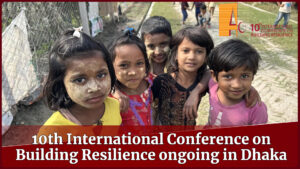
10th International Conference on Building Resilience ongoing in Dhaka
The 10th International Conference on Building Resilience (ICBR) started in Dhaka on December 4, bringing global experts together to address cascading and compound risks posed by climate change, humanitarian crises and disasters. The three-day event is hosted by BRAC University’s Cell for Adaptation, Resilience, Security, and Humanitarian Assistance (CARSHA) alongside its Department of Architecture under the School of Architecture and Design. Established in 2008, the ICBR series has become a globally recognised platform for disaster resilience and risk reduction, attracting academics, practitioners and policymakers from diverse disciplines. Previous editions have been held in Australia, Indonesia, New Zealand, Portugal, Sri Lanka, Thailand, the UK and the USA, underscoring the conference’s international reach and reputation. The Dhaka conference will focus on the theme “Addressing Cascading and Compound Risks of Climate Change, Humanitarian Crises and Disasters.” Organisers say the theme reflects the growing complexity of global hazards, where climatic shifts, natural disasters, conflicts, technological failures and environmental degradation increasingly overlap. They warn that societies must now prepare for multiple disasters occurring simultaneously, as well as the chain reactions triggered by single events. The conference aims to provide a platform for experts, researchers, academics, practitioners and decision-makers to share knowledge and strategies for reducing these risks in a global context. Key areas of discussion included anticipatory approaches to disaster risk reduction, climate financing and loss-damage calculation, forced displacement and its impacts, and challenges in rehabilitation, relocation and emergency accommodation. Sessions also explored innovation in climate change adaptation, building financial resilience, humanitarian operations, peace and development, and community participation in addressing complex risks. Other topics included ecosystem-based adaptation, the nexus of humanitarian crises and climate change impacts, the future of global humanitarian operations, and resilient built environment design. The organisers have set out a detailed timeline for participation. Abstract and poster submissions opened on June 1 of 2024, with the final deadline on August 1 of 2025. Notifications of acceptance was issued on August 22 of 2025, followed by revised submissions due on September 26 of 2025. Final selections were confirmed on October 24 of 2025, while early bird registration closed on October 31 the same year. The conference itself will run from December 4–6 at BRAC University’s campus on Bir Uttam Rafiqul Islam Avenue in Dhaka. Organisers emphasised that the event is designed to encourage cross-sectoral collaboration, bringing together voices from academia, government, industry and humanitarian organisations. They argue that such collaboration is essential to tackle the escalating risks posed by climate change and disasters, which in creasingly cut across national boundaries and sectors. The Dhaka edition is expected to highlight Bangladesh’s role as a frontline nation in climate resilience, given its vulnerability to rising sea levels, cyclones and flooding. By hosting the 10th ICBR, BRAC University aims to position itself as a hub for global dialogue on resilience and adaptation. The conference also showcased the work of CARSHA, which focuses on adaptation, resilience, security and humanitarian assistance in the context of climate change and disasters. Organisers say the event will not only disseminate research but also foster practical solutions that can be applied in vulnerable regions worldwide. With participation from international partners and knowledge networks, the Dhaka conference is expected to strengthen global cooperation on disaster resilience. As the countdown begins, the 10th ICBR is being framed as a milestone event in the global effort to confront cascading and compound risks. At a time when climate change and humanitarian crises are converging, the Dhaka conference seeks to chart a path towards resilience and preparedness. Written by Nibir Ayaan
Read MoreAkijBashir Group Opens New “Selections” Showroom at Banglamotor
AkijBashir Group has opened a new Selections showroom at Banglamotor, Dhaka, expanding its network of outlets that offer building-material solutions under one platform. Launched in October 2022 with the motto “Select from the Best,” Selections now operates seven flagship outlets across Dhaka, Chittagong, Sylhet, Savar, Tangail, and Kishoreganj. The newly opened Banglamotor showroom, located at 18 Link Road, features a range of ceramic tiles, boards, doors, sanitaryware, bathware, and tableware – representing the complete product lineup of AkijBashir Group brands. The showroom was inaugurated by Mohammod Khorshed Alam, Chief Operating Officer of AkijBashir Group. Senior officials present included Mohammed Ashraful Haque, General Manager (Sales) of Akij Ceramics; Bishwajit Paul, Head of Sales at ROSA; and Md. Hasan-Ur-Rashid, proprietor of Yasir Trade Corporation. With the opening of the Banglamotor outlet, Selections continues its expansion, offering customers improved access to its building-material categories and a convenient selection experience.
Read More
Three-day Global Sourcing Expo 2025 opens in Dhaka
The Global Sourcing Expo 2025 – Dhaka has opened at the Bangladesh-China Friendship Exhibition Centre in Purbachal, bringing together exporters, buyers and trade bodies from across the world in a major push to diversify Bangladesh’s export markets. Jointly organised by the Export Promotion Bureau (EPB) and the commerce ministry, the three-day event is being billed as a strategic international platform showcasing Bangladesh’s evolution from a global apparel powerhouse to a diversified export hub. The expo features products from eight major sectors: readymade garments, leather and leather goods, jute and jute products, agricultural goods, plastics and kitchenware, home décor and furniture, pharmaceuticals, and ICT. More than 100 firms are taking part, including multinational companies, wholesalers and supply-chain representatives. Buyers and sourcing organisations from Afghanistan, China, Iran, Japan, Myanmar, Pakistan, Singapore, Sri Lanka, Thailand, the UAE, the US and several other countries are attending business-to-business meetings and negotiating potential contracts. The fair houses 200 stalls and includes 12 thematic seminars, fashion shows, product demonstrations, and both online and offline networking sessions. Organisers say the event is designed to connect local businesses with global buyers, trade bodies and new market opportunities to accelerate export growth and diversification. Commerce Adviser Sk Bashir Uddin, who inaugurated the expo, said Bangladesh must accelerate diversification, strengthen competitiveness and adopt forward-looking trade policies as it prepares to graduate from the group of least developed countries (LDCs). “To navigate this transition successfully, we must accelerate diversification, improve competitiveness, and adopt forward-looking trade policies,” he said. He added that while graduation is a major achievement, it will gradually reduce the preferential market access and duty benefits Bangladesh currently enjoys. At a seminar on the sidelines of the expo, Mohammad Hatem, president of the Bangladesh Knitwear Manufacturers and Exporters Association, said foreign involvement in port operations could improve efficiency. He also called for suspension of the amended labour law until a newly elected government is in place, arguing that the current changes are neither industry- nor worker-friendly. In another session, Inamul Haq Khan, senior vice-president of the Bangladesh Garment Manufacturers and Exporters Association, stressed the need for easier access to green financing, greater support from brands through knowledge sharing and technology transfer, and targeted interventions for SMEs. He urged wider regional inclusion so that areas such as North Bengal, Sylhet and Chattogram can benefit alongside Dhaka-centric clusters. Khan also called on the government to amplify the industry’s success stories through Bangladesh’s embassies and high commissions abroad, showcasing achievements on the global stage. The expo is being positioned as a vital opportunity for companies aiming to expand exports, launch new product lines or strengthen global brand visibility. With strong government backing for trade and investment, it reflects Bangladesh’s push for product and market diversification at a time when the country is seeking to secure its place in global markets beyond garments. Speakers at the event included Lutfey Siddiqi, special envoy for international affairs to the chief adviser; Mohammad Hasan Arif, EPB vice chairman; Mahbubur Rahman, commerce secretary; and Md Abdur Rahim Khan, administrator of the Federation of Bangladesh Chambers of Commerce and Industry (FBCCI). Organisers say the expo is not only about showcasing products but also about building long-term partnerships. The inclusion of thematic seminars and networking sessions is intended to encourage dialogue on issues ranging from sustainable production and green financing to supply-chain resilience and regional inclusion. The event comes at a critical time for Bangladesh’s economy. As the country prepares for LDC graduation, policymakers and industry leaders are emphasising the need to diversify the export basket, strengthen supply-side capacity and forge new partnerships with international buyers. The expo, they argue, provides a platform to address these challenges while highlighting Bangladesh’s achievements and ambitions. By bringing together stakeholders from across the world, the Global Sourcing Expo 2025 – Dhaka underscores the country’s determination to move beyond its reliance on garments and establish itself as a competitive player in a wider range of industries. Written by Nibir Ayaan
Read More
Driving Global Competitiveness and Strategic Growth for the Ceramic Industry: CERAMIC EXPO Bangladesh-2025 Highlights
The third day of the 4th CERAMIC EXPO Bangladesh-2025 was marked by high energy, featuring power-packed seminars focused on the industry’s future. One of the key events was Seminar-2: “Global Market Strategies: Challenges and Opportunities for Ceramic Products.” This session served as a platform for manufacturers, exporters, and suppliers from home and abroad to examine market trends and share key insights regarding the challenges and opportunities for Bangladesh’s ceramic products in global market. Bangladesh’s ceramic sector, a $905 million industry growing around 20% annually since 2001, still faces major hurdles in scaling globally. The session brought together academia,policymakers,and industry leaders,sparking a dynamic discussion on how the sector can overcome obstacles and cement its place on the global stage. Key Insights from Academia The spotlight first fell on Keynote Speaker Dr.Aditi Shams,Associate Professor, Department of International Business (IB), University of Dhaka, who presented a data-filled report that set an intellectually charged tone for the event. Dr.Shams noted that while strong backward linkage makes the sector more competitive by reducing imports and boosting exports, the industry’s major challenge lies beyond external factors. “Sadly,beyond the external challenges, it is our unresolved internal struggles that continue to hold the sector back from reaching its full potential,” she asserted. She highlighted the ongoing gas and energy crisis,coupled with the long, complicated, and exhausting investment paperwork process, as steadily delaying growth and slowing overall progress. With Bangladesh moving beyond LDC status, its exporters may now face new tariffs and lose some of the previous advantages giving the competitors a potential edge. However, the final impact depends heavily on destination market rules, product type, certification, and production/export conditions. Ms.Aditi urged firms to follow the lead of companies like Akij Ceramics and the Abul Khayer Group,which are already investing in advanced technology to create high-end, standout products. She also highlighted the critical need for green certifications, noting that as consumers become increasingly climate-conscious, sustainable practices are no longer optional but essential for entering international markets. Finally,she emphasized the importance of branding Bangladeshi ceramics on the global stage-telling our story through our products. Just as one can distinguish Vietnam’s ceramics from China’s,she said, people should be able to recognize Bangladeshi products at a glance. She addressed how such expo trade fairs can be greatly impactful to increase visibility and exposure to world industry tycoons. Another panellist Dr. Mohammad Monirul Islam, also an Associate Professor from the University of Dhaka’s International Business (IB) department, specifically criticized the country’s unbalanced priorities, arguing that its over-reliance and singular focus on the Ready-Made Garments (RMG)sector have led to the neglect of other booming industries, such as ceramics. Dr.Amnir Ahmed, Associate Professor and Head Department of Real Estate Daffodil International University, focused on the necessity of curriculum reform. He highlighted the success of his institution’s real estate graduates, who are now specialists in their field. Therefore, Bangladesh’s educational curriculums must integrate such effective courses that ensure graduates secure immediate employment while simultaneously providing the country with a much-needed skilled workforce. Dr. Amir Ahmed and Dr. Aditi Shams couldn’t help but address the vital importance of engaging more in research, a deficiency this industry must overcome to fill necessary gaps. Industry and Policy Perspectives: M.Mamunur Rashid of Artisan Ceramics Ltd. gave his thoughtful take on maintaining a well-maintained,clean factory for high-end production and worker efficiency. He said how policymakers play a significant role in facilitating progress from every angle. Special guest Baby Rani Karmakar from the Export Promotion Bureau emphasized the importance of investing in clients, describing it as the “secret sauce” for long-term success in order to build a strong foundation for the industry’s future growth. She mentioned the necessity of a decisive,future-focused approach with clear vision:”We must set our target, where we would like to see us, and take actions likewise.” This strategic planning extends to market engagement, where she insisted on the need to actively “win the buyers” and pursue mutually beneficial partnerships. To effectively brand and exert influence on the global stage, Karmakar argued, “we need to come to that antiquity to tell our stories and attract buyers from the globe,” citing examples such as Rooplal House, the Armenian Church,and the Tara Mosque. The session concluded on a strategic paradox: while Bangladesh’s ceramic sector possesses significant foundational strengths, its long-term viability is critically impeded by deep structural weaknesses.Opportunities could emerge from addressing these very challenges.The sector’s over-reliance on imported raw materials (85-95%) and acute domestic energy and infrastructure deficits render it vulnerable to input cost inflation and order cancellations, despite the potential presented byrapid domestic urbanization and global market expansion. Crucially,the window for growth is constrained by the existential threat of LDC graduation and the subsequent loss of GSP preferential market access, necessitating an urgent strategic shift toward developing backward linkages and resolving energy vulnerabilities before external policy risks fully materialize.
Read More
For the first time BCMEA organized a ‘Dealer Night’ in honour of ceramic dealers
Dhaka (28 November 2025): The largest gathering of ceramic industry dealers took place at the International Convention City Bashundhara in the capital, as part of the major event in the ceramic sector, Ceramic Expo Bangladesh 2025. On the evening of the second day, BCMEA held a Dealer Night in honour of the dealers for the first time in Bangladesh’s history. In the event, BCMEA’s President Moinul Islam stated that we need to advance significantly in this sector to face future challenges. For this, timely use of technology and preparing products according to customer demand to survive in the global market is essential. The welcome speech was delivered by BCMEA’s Senior Vice President Abdul Hakim Sumon. The event featured speeches from Syed Mohsin Hossain, Head of Corporate Marketing at Principal Sponsor Sheltech Ceramics; Shahiduzzaman Raj, Head of Sales at Platinum Sponsor DBL Ceramics; Bishwajit Pal, Head of Sales at Akij Ceramics; and Iftekhar Alam, Head of Sales at Fresh Ceramics. BCMEA’s Senior Vice President Mamunur Rashid FCMEA expressed gratitude. The event was enlivened by the humour of renowned comedian Abu Hena Roni and the songs of the melody queen Anika. Later, through a raffle draw, 10 dealers were awarded attractive prizes. The event was attended by directors of the Bangladesh Ceramic Manufacturer and Exporter Association, heads of sales from ceramic companies, dealers from across the country, exhibitors, and architects. On the second day of the four-day BCMIEA Ceramic Expo Bangladesh 2025, a large number of domestic and foreign visitors, dealers, engineers, businessmen, students, and individuals related to the construction industry visited the fair. During this time, they expressed amazement at the world-class technology-dependent ceramic products produced in Bangladesh. Throughout the day, various stalls had arranged different courtesy gifts and a raffle draw for the visitors. The venue was bustling with all stakeholders of the ceramic sector under one roof. Here, through various business agreements, experience sharing, and consultations, it is believed by most that the companies related to this sector will benefit. There was a separate stall for those who want to build their careers in the ceramic industry, where many students and job seekers submitted their CVs, while various companies expressed interest in recruiting personnel in this sector. Written by Mizanur Rahman Jewel
Read More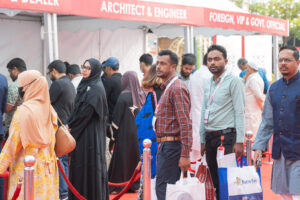
The Ceramic Expo bustling with a large number of people on the 2nd day
Dhaka (28 November 2025): The BCMEA Ceramic Expo Bangladesh 2025 has gathered in the capital. On the second day of this four-day vibrant event, the International Convention City Bashundhara was bustling with local and foreign visitors, exhibitors, businessmen, engineers, architects, and representatives from various companies. The arriving businessmen held meetings with B2B, B2C, and representatives from different companies. In the various pavilions and stalls, they demonstrated their products and ensured spot orders. Senior officials of various companies stated that due to the holiday, there was a noticeable crowd of visitors from the morning, and many placed orders for products. Artist Shahin Mahmud Reza, participating in the fair for the first time, expressed satisfaction with the organization of the fair. As every year, dealer Md. Rahim Uddin has come to the expo from Chittagong. He mentioned that he has seen many new designs at this year’s expo. Following this, a seminar was held in a very large hall where relevant stakeholders participated. Mohammad Khaled Hasan, Deputy General Manager of Sheltech Ceramics Limited, the titled sponsor of the expo, mentioned that the ceramic industry of Bangladesh is a glorious sector. Earlier, we used to import ceramic products at about 80 percent, but nowadays approximately 15 to 20 percent we import; we export it and gradually extend its market. One of the visiting engineers stated that this sector has achieved an average growth of over 20 percent, setting records. Despite the gas crisis, the uninterrupted supply of electricity, and various domestic and international crises, this industry remains an emerging sector. Unlike the ready-made garment, jute, and textile sectors, which receive policy support, this sector has reached a respectable position solely due to the courageous initiatives of entrepreneurs. One could say that the ceramic industry has brought about a silent revolution in the last 10 years. Through rapid expansion in the local market, stable presence in foreign markets, and massive job creation, this industry has demonstrated that with industry-friendly policies, uninterrupted gas supply, and proper branding, it will be capable of exporting billions of dollars in the future solely in Asia. Today, there are about 65–70 ceramic factories and brands in the country producing various products including tableware, tiles, sanitary ware, and electric insulators. As a result, instead of being import-dependent like before, Bangladesh now fulfils a large part of its own demand and sends excess production to the global market; this is not a small change but rather a picture of slow yet steady success in industrial policy. The domestic market for Bangladeshi ceramic products is currently considered to be worth around 70 to 90 billion BDT, with annual growth hovering around 20 percent for a long time. Once where 80 percent of the market was occupied by foreign brands, today local companies meet nearly 85 percent of market demand; in tableware, local participation exceeds 90 percent. Some visitors stated rapid urbanisation, development in the housing sector, rising incomes of the middle class, and changes in lifestyle perspectives have contributed to this achievement. The use of tiles and sanitary products in new flats, shopping malls, hotels, and restaurants is now not just a necessity but also a symbol of prestige and taste. In this way, the ceramic industry has become directly linked to the dreams of the urban middle class, as if the contribution of this industry is silently signing on the walls and floors of every new flat. Although the export earnings of the ceramic industry are still seen by many as ‘less compared to the size of investment’, in reality, it has passed an important initial phase. In the fiscal year 2022–23, the export earnings from ceramic products reached around 43–55 million USD (equivalent to 600–650 crore BDT), which is the highest in four years. The export growth in this sector from 2021–22 to 2022–23 was over 21 percent, although in the fiscal year 2023–24, it has slightly decreased by nearly two percent. Tableware occupies the largest share in the export basket; recently, tiles have also been added. Bangladeshi ceramic products now go to over 50 countries; United States, Canada, Germany, France, Italy, Japan, and various countries in the Middle East are major destinations. In such a reality, despite slight fluctuations, it is clear that Bangladesh is establishing itself as a reliable source of ‘low-cost but quality’ ceramic products in the global market. This expo carries a very high potential for the Bangladeshi ceramic industry and also plays a vital role in the economy. Written by: Mizanur Rahman Jewel
Read More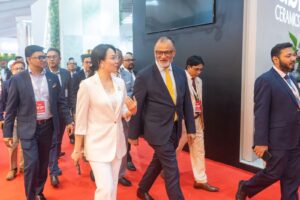
Government Pledges Full Policy Support to Boost The Ceramic Industry Growth: Sheikh Bashir
“The Interim Government will provide all necessary policy and regulatory support to accelerate the ceramic industry’s expansion.”, said the Commerce Adviser Sheikh Bashir Uddin. At the inauguration of the Ceramic Expo Bangladesh 2025, he stated “The ceramic industry, once fully dependent on imports, has now secured a strong position in global markets. There is a growing need for advanced technology adoption and uninterrupted energy supply to maintain production efficiency.” The four-day international exhibition has commenced on 27th Nov in Dhaka to present Bangladesh’s ceramic industry to local and global buyers and investors. Organized by the Bangladesh Ceramic Manufacturers and Exporters Association (BCMEA), Ceramic Expo Bangladesh 2025, one of Asia’s largest and most influential international ceramic trade exhibitions, is being held at the International Convention City Bashundhara (ICCB). The event was presided over by BCMEA President Moinul Islam. Other speakers included Export Promotion Bureau Vice-Chairman Mohammad Hasan Arif, Italian Ambassador to Bangladesh Antonio Alessandro, BCMEA Senior Vice-Presidents Md Mamunur Rashid and Abdul Hakim Sumon, and BCMEA General Secretary Irfan Uddin. BCMEA President Moinul Islam noted that the ceramic industry has experienced rapid growth over the past decade. More than 70 factories producing tableware, tiles, and sanitary ware are currently in operation, serving a domestic market valued at Tk 8,000 crore annually. Over the last ten years, both production and investment have increased by nearly 150 percent. He added that Bangladesh now exports ceramic products to more than 50 countries, earning nearly Tk 500 crore in annual export revenue. Total industry investment exceeds Tk 18,000 crore, with the sector providing direct and indirect employment to approximately 500,000 workers. He further highlighted that major ceramic-producing nations, including China and India, are increasingly exploring investment opportunities in Bangladesh due to its competitive cost advantages and expanding global footprint. Fair Committee Chairman and BCMEA Secretary-General Irfan Uddin said Bangladeshi ceramic products are gaining international recognition for their quality, durability, and modern design. Demand is rising, and new global markets are opening for local manufacturers. He added that the expo will spotlight next-generation ceramic technologies, including automation, advanced digital printing, robotic handling, and upgraded production lines. “Smart tiles and sensor-integrated ceramic products, which are already popular worldwide, are expected to enter the domestic market soon. This expo will help local manufacturers connect with these emerging technologies,” he said. Following the inauguration, the commerce adviser and distinguished guests visited various pavilions and stalls, where they praised the innovations and product displays. The adviser expressed confidence that the sector will become increasingly export-driven. This fourth edition of the expo is set to host 135 companies and 300 global brands from 25 countries, including host Bangladesh, while more than 500 international delegates and buyers are scheduled to participate, underscoring the increasing global focus on Bangladesh’s rapidly expanding ceramic sector. BCMEA confirmed that the exhibition will feature three technical seminars, a job fair, extensive B2B and B2C meetings, live product demonstrations, spot-order opportunities, raffle draws, attractive giveaways, and the launch of new ceramic technologies and products. The exhibition is open to visitors free of charge from 10:00 AM to 6:00 PM daily and is expected to attract buyers, suppliers, and stakeholders from across the sector. The event is supported by key industry partners. Sheltech Ceramics is serving as the Principal Sponsor, while DBL Ceramics, Akij Ceramics, and Meghna Ceramics are Platinum Sponsors. Gold Sponsors include Mir Ceramics, Abul Khayer Ceramics, HLT DLT, and SACMI, reflecting broad industry backing for the international expo. Written By: Mizanur Rahman Jewel and Anonno Aziz NIbir
Read More
Ceramic Expo Bangladesh 2025 Opens in Dhaka, Showcasing National Industry to Global Markets
A four-day international exhibition has commenced in Dhaka to present Bangladesh’s ceramic industry to local, global buyers and investors. Organized by the Bangladesh Ceramic Manufacturers and Exporters Association (BCMEA), Ceramic Expo Bangladesh 2025, one of Asia’s largest and most influential international ceramic trade exhibitions, is being held at the International Convention City Bashundhara (ICCB). This fourth edition of the expo is set to host 135 companies and 300 global brands from 25 countries, including host Bangladesh, while more than 500 international delegates and buyers are scheduled to participate, underscoring the increasing global focus on Bangladesh’s rapidly expanding ceramic sector. BCMEA confirmed that the exhibition will feature three technical seminars, a job fair, extensive B2B and B2C meetings, live product demonstrations, spot-order opportunities, raffle draws, attractive giveaways, and the launch of new ceramic technologies and products. The exhibition is open to visitors free of charge from 10:00 AM to 6:00 PM daily and is expected to attract buyers, suppliers, and stakeholders from across the sector. Speaking at the opening ceremony, Commerce Adviser Sheikh Bashir Uddin said the industry, once fully dependent on imports, has now secured a strong position in global markets. He stressed the need for advanced technology adoption and uninterrupted energy supply to maintain production efficiency. The adviser added that the Interim Government will provide all necessary policy and regulatory support to accelerate the industry’s expansion. Following the inauguration, the adviser and distinguished guests visited various pavilions and stalls, where they praised the innovations and product displays. The commerce adviser expressed confidence that the sector will become increasingly export-driven. The event was presided over by BCMEA President Moinul Islam. Other speakers included Export Promotion Bureau Vice-Chairman Mohammad Hasan Arif, Italian Ambassador to Bangladesh Antonio Alessandro, BCMEA Senior Vice-Presidents Md Mamunur Rashid and Abdul Hakim Sumon, and BCMEA General Secretary Irfan Uddin. BCMEA President Moinul Islam noted that the ceramic industry has experienced rapid growth over the past decade. More than 70 factories producing tableware, tiles, and sanitary ware are currently in operation, serving a domestic market valued at Tk 8,000 crore annually. Over the last ten years, both production and investment have increased by nearly 150 percent. He added that Bangladesh now exports ceramic products to more than 50 countries, earning nearly Tk 500 crore in annual export revenue. Total industry investment exceeds Tk 18,000 crore, with the sector providing direct and indirect employment to approximately 500,000 workers. He further highlighted that major ceramic-producing nations, including China and India, are increasingly exploring investment opportunities in Bangladesh due to its competitive cost advantages and expanding global footprint. Fair Committee Chairman and BCMEA Secretary-General Irfan Uddin said Bangladeshi ceramic products are gaining international recognition for their quality, durability, and modern design. Demand is rising, and new global markets are opening for local manufacturers. He added that the expo will spotlight next-generation ceramic technologies, including automation, advanced digital printing, robotic handling, and upgraded production lines. “Smart tiles and sensor-integrated ceramic products, which are already popular worldwide, are expected to enter the domestic market soon. This expo will help local manufacturers connect with these emerging technologies,” he said. The event is supported by key industry partners. Sheltech Ceramics is serving as the Principal Sponsor, while DBL Ceramics, Akij Ceramics, and Meghna Ceramics are Platinum Sponsors. Gold Sponsors include Mir Ceramics, Abul Khayer Ceramics, HLT DLT, and SACMI, reflecting broad industry backing for the international expo. Written by: Mizanur Rahman Jewel
Read More
Four-day Ceramic Expo Bangladesh 2025 Begins Thursday
The Ceramic Expo Bangladesh 2025 is set to begin Thursday, November 27, at the International Convention City Bashundhara (ICCB), Kuril, Dhaka. The four-day international ceramic fair is being organized by the Bangladesh Ceramic Manufacturers and Exporters Association (BCMEA). The expo will be formally inaugurated by Commerce Adviser Sheikh Bashiruddin. For the fourth time, this world-class exhibition on ceramic raw materials, machinery, and technology will feature participation from 300 brands representing 135 companies from 25 countries, including Bangladesh. In addition, 500 international delegates and buyers will join the event. The expo will also include three seminars, a job fair, B2B and B2C meetings, raffle draws, attractive gifts, live demonstrations, spot orders, and opportunities for launching new products. From BCMEA President Moynul Islam, more than 70 ceramic tableware, tiles, and sanitary ware factories have already been established in the country. Over the past ten years, production and investment in the ceramic sector have grown by nearly 150 percent. Bangladesh exports ceramic products to more than 50 countries worldwide, earning around Tk 500 crore annually. Export earnings in this sector are increasing. Many countries, including major ceramic-producing nations such as China and India, have shown interest in investing here. The sector has attracted investments of over Tk 18,000 crore. “Ceramic Expo Bangladesh 2025 has been organized to showcase the development of the country’s ceramic industry and its capabilities worldwide. I hope that your overall cooperation will make this event even more dynamic, says BCMEA President Moynul Islam. Fair Committee Chairman and BCMEA General Secretary Irfan Uddin expressed that Ceramic Expo Bangladesh 2025 is the country’s fourth and Asia’s largest international exhibition of its kind. “Ceramic manufacturers, exporters, and suppliers are getting the opportunity to showcase their new products, modern technologies, and expertise to a global audience. Along with marketing domestic ceramic products, the expo will also help raise awareness about their use”, he adds. The four-day exhibition will remain open to visitors, buyers, and participants free of charge every day from 10 a.m. to 6 p.m. Sheltech Ceramics is the principal sponsor of the fair, while DBL Ceramics, Akij Ceramics, and Meghna Ceramic are the platinum sponsors. In addition, the gold sponsors include Mir Ceramic, Abul Khair Ceramic, HLT DLT, and Sacmi. Written By Tasmiah Chowdhury
Read More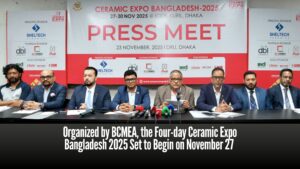
Organized by BCMEA, the Four-day Ceramic Expo Bangladesh 2025 Set to Begin on November 27
The Ceramic Expo Bangladesh 2025 is set to begin on November 27 at the International Convention City Bashundhara (ICCB), Kuril, Dhaka. The four-day international ceramic fair—one of Asia’s most prominent—is being organized by the Bangladesh Ceramic Manufacturers and Exporters Association (BCMEA). For the fourth time, this world-class exhibition on ceramic raw materials, machinery, and technology will feature participation from 300 brands representing 135 companies from 25 countries, including Bangladesh. In addition, 500 international delegates and buyers will join the event. The expo will also include three seminars, a job fair, B2B and B2C meetings, raffle draws, attractive gifts, live demonstrations, spot orders, and opportunities for launching new products. At a press conference held today, November 23, the Dhaka Reporters Unity auditorium in the capital, BCMEA President Moynul Islam shared these details. In addition, Fair Committee Chairman and BCMEA General Secretary Irfan Uddin spoke, highlighting various aspects of the expo. Also present at the event were BCMEA Senior Vice President Md. Mamunur Rashid, FCMA; Senior Vice President Abdul Hakim Suman; Vice President Rasheed Mymunul Islam; and Director Mohd. Ziaul Hoque Zico. From the Principal Sponsor of the fair, Sheltech Ceramics Ltd., Director (Sales & Marketing) Syed Ali Abdullah Jami, Didarul Alam Khan, Head of Marketing of Platinum Sponsor DBL Ceramics Ltd., Md. Ashraful Haque, General Manager (Sales & Marketing) of Akij Ceramics Ltd., and Shahjada Yeasir Arafat Shuvo, Manager (Brand) of Meghna Ceramic Ind. Ltd., were present. The press conference announced that on November 27, the expo will be formally inaugurated at the ICCB by Commerce Adviser Sheikh Bashiruddin. In addition, on November 29, Foreign Affairs Adviser Mohammad Touhid Hossain will attend a special segment of the expo as the chief guest. BCMEA President Moynul Islam said that more than 70 ceramic tableware, tiles, and sanitary ware factories have already been established in the country. The annual sales volume in the local market is approximately Tk 8,000 crore. Over the past ten years, production and investment in the ceramic sector have grown by nearly 150 percent. Bangladesh exports ceramic products to more than 50 countries worldwide, earning around Tk 500 crore annually. Export earnings in this sector are increasing, as is investment. Many countries, including major ceramic-producing nations such as China and India, have shown interest in investing here. The sector has attracted investments of over Tk 18,000 crore, and it directly and indirectly provides employment to nearly five lakh people. Fair Committee Chairman and BCMEA General Secretary Irfan Uddin said that due to superior quality and attractive designs, the demand for Bangladesh-made ceramic products is increasing in the global market. Not only that, new markets are also emerging. He added that Ceramic Expo Bangladesh 2025 is the country’s fourth and Asia’s largest international exhibition of its kind. Ceramic manufacturers, exporters, and suppliers are getting the opportunity to showcase their new products, modern technologies, and expertise to a global audience. Along with marketing domestic ceramic products, the expo will also help raise awareness about their use. Irfan Uddin said that they believe the use of technology in the ceramic industry will completely transform its future. Through automation, advanced digital printing, robotic handling, and high-quality production lines, manufacturing will become faster, more precise, and more cost-effective. He added that smart tiles and sensor-integrated products are gaining popularity worldwide, and this trend will soon influence the Bangladeshi market as well. The expo, he noted, will create a vital link between these technologies and local manufacturers. The four-day exhibition will remain open to visitors, buyers, and participants free of charge every day from 10 a.m. to 6 p.m. Sheltech Ceramics is the principal sponsor of the fair, while DBL Ceramics, Akij Ceramics, and Meghna Ceramic are the platinum sponsors. In addition, the gold sponsors include Mir Ceramic, Abul Khair Ceramic, HLT DLT, and Sacmi. Written by Tasmia Chowdhury
Read More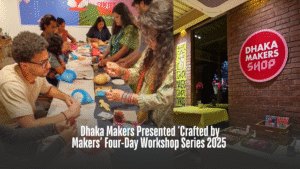
Dhaka Makers Presented ‘Crafted by Makers’ Four-Day Workshop Series 2025
Dhaka Makers presented ‘Crafted by Makers’ – a four-day workshop series held from November 13 to November 16, 2025, at Shala Neighbourhood Art Space, Aloki. A total of 14 creative workshops were hosted that celebrated art, craft, and design in all their forms. Each day of the workshop series featured engaging and distinctive session led by skilled artisans for participants. The four-day event hosted various sessions: terracotta jewelry workshop, robotics workshop, candle-making workshop, miniature model-making workshop, origami workshop, and many more. The curated sessions aimed to showcase Bangladesh’s vibrant arts and craft culture while promoting learning, play, and mindful creation for all ages, especially, children and teenagers. Every instructor paced the activities carefully so participants could follow along comfortably and absorb the making process. There were also some sessions designed for older children and adults such as the ‘Hand-Knotting Tapestry with Boho’, facilitated by Nazneen Nahar Smrity. This workshop blended craftsmanship and creativity. The workshop was perfect for anyone who loves tactile art and wants to experience the meditative rhythm of weaving, and learn the skills of a century-old tradition. Other captivating session included the ‘Putli Puraan: Doll Making Workshop’, facilitated by Mita Muni. The workshop led participants to step into the enchanting world of traditional doll making. By the end of this workshop, participants acknowledged the process, skill, and the cultural value behind this underappreciated art form in Bangladesh, discovering its deep heritage and future potential for creative revival. One other fascinating session was ‘Candēla by Newton’s Archive’ facilitated by Rahnuma Ahsan Raima and team. Candēla was a hands-on candle-making workshop that celebrated Bangladeshi culture and craftsmanship, and the art of making. Inspired by the country’s natural palette – from monsoon earth tones to the aromas of native blooms – the edition blended local motifs, materials, and scents. Dhaka Makers remains committed to fostering creative growth in children and young minds, offering workshops that encourage experimentation, and introduce a vibrant world of new ideas and possibilities. Written by Tasmia Chowdhury
Read More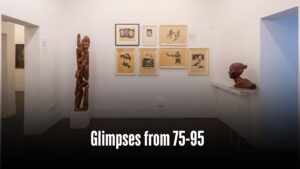
Glimpses from 75-95
Titled “Phire Dekha/Re See,” the ongoing exhibition at the capital’s Kalakendra is comprised of the most heavyweight line-up of artists in a single group show in this gallery’s journey so far. Although a young gallery run by the veteran Wakilur Rahman, Kalakendra has already cemented its place as a hub for regular exhibition-goers of Dhaka, and its latest exhibition is another beautiful stroke in its canvas. Kazi Rakib, Deepa Haq, Dhali Al Mamoon, Dilara Begum Jolly, Nisar Hossain, and Shishir Bhattacharjee, Saidul Haque Juise, Fareha Zeba, Ratan Mojumdar, Habibur Rahman, Ruhul Amin Kajol, Lala Rukh Selim, Towfiqur Rahman, and Wakilur Rahman—if you are an enthusiast of the Bangladeshi art scene, you are at least familiar with a few of these names from this stellar list of Bangladeshi artists. These names, whether as a promising back-in-the-day or established artist, as a respected teacher for generations of art students, or as a curator, are all notable in their own ways in a detailed history of the Bangladeshi art scene. Growing up in a country where there is a mass tendency of collective amnesia towards the importance of archives and still no organized/proper practice of museum and gallery culture, if you have ever wondered what the art of some notable names looked like when they were at your and your Charukola friends’ age, “Phire Dekha” provides you a glimpse. The show gathers these fourteen artists, whose works once characterized the visual rhythm of postwar Bangladesh. The display, which runs from 1975 to 1995—an era marked by instability, transformation, and fragile hope—does not attempt to rebuild history but rather to reflect on it through the lens of art. Those two decades were more than just years on a timeline; they were a line of reckoning. Bangladesh, yet learning the lexicon of its freedom, was seeing seismic worldwide shifts—the demise of socialism, the growth of neoliberal dreams, and the gradual disintegration of collective idealism. These factors undoubtedly influenced how artists thought, created, and responded to their surroundings. The show makes no conclusive statements about that age; rather, it creates a contemplative space between history and present, memory and method, inviting visitors to rediscover what art previously possessed and what it continues to disclose. “Re See” is curated without the weight of theory or curatorial rigor, instead assembling pieces of real experience rather than a predefined theme. All of the participating artists were young art students in the years following the Liberation War. Some were members of collectives such as Dhaka Painters or the Somoy Group, while others forged their own paths of discovery. Their works together provide a mosaic of artistic and emotional progress, a portrait of a generation that used color, form, and gesture to express its times. The exhibition features paintings, sculptures, prints, sketches, and mixed-media pieces, the majority of which are from the artists’ personal archives. The mix of mediums—etchings, acrylics, watercolor, and assemblage—reflects the restless search for words that marked Bangladeshi art throughout those decades. “We seldom get to see the works that shaped our contemporary practice,” he observed. “Between 1970 and 1990, the political and cultural landscapes of our country changed dramatically, and those changes inevitably entered art. The young artists of that period absorbed both global and local influences, reinterpreting them through their own materials, symbols, and languages. Many have since matured into leading figures, guiding the next generations of creators,” said art historian and critic Professor Abul Mansur. These words capture the essence of “Re See”; it is not nostalgia but an act of rediscovery, an artistic archaeology of thought and feeling. The exhibition runs daily from 4 p.m. to 8 p.m. until November 15 at Kalakendra. Written by Shahbaz Nahian
Read More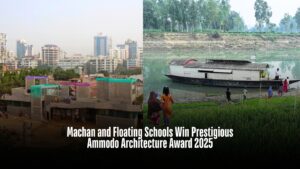
Machan and Floating Schools Win Prestigious Ammodo Architecture Award 2025
Two Projects from Bangladesh – Machan: Korail Community Platform in Dhaka by Paraa and the Floating Schools for Community Resilience by Shidhulai Swanirvar Sangstha in Pabna district, —have been named among the 26 global recipients of the 2025 Ammodo Architecture Award for their contributions to socially and ecologically responsible design. From the Ammodo, this year’s selection spans six regions: Africa, Asia, Europe, North & Central America, South America, and Southeast Asia & Oceania. The chosen projects address diverse urban and rural contexts, tackling issues such as housing, education, ecological restoration, and collective living. Awardees were selected by an international advisory committee consisting of six renowned architects and cultural professionals from around the globe: Joumana El Zein Khoury, Andrés Jaque, Anupama Kundoo, Floris Alkemade, Mariam Issoufou and Loreta Castro Reguera. Machan: Korail Community Platform, Dhaka The name – Machan, meaning ‘platform’ in Bangla, is Dhaka’s first community-driven permanent cultural and creative hub located in the Korail low-income settlement. It emerged from the “Korail: City of Culture” initiative, a sustainable urban development project led by architecture studio Paraa. Built collaboratively with Korail residents, youth groups, and community leaders, Machan transforms a former dumping ground into a vibrant cultural centre. The platform hosts a variety of social, cultural, and creative activities including: architectural design exhibitions, artwork displays, photography showcases, installation art, and performing arts. The platform collaborates with other organizations facilitating workshops on participatory planning, community mapping, and arts like indigo dyeing. The project establishes a much-needed, multifunctional open space that enables residents to gather, and participate in shared activities, effectively converting a former waste ground into a dynamic community hub. The project supports local cultural practitioners and connects their knowledge to global discussions on sustainability and the rights of marginalized communities. Floating Schools for Community Resilience by Shidhulai Swanirvar Sangstha, Pabna The “Floating Schools for Community Resilience” project by Shidhulai Swanirvar Sangstha primarily operates along the Gumani River in the Faridpur and Bhangura subdistricts of Pabna. The initiative brings schools to students in villages along the Gumani River, using a flexible fleet of boats for classrooms, health clinics, and training centers to ensure continuity of services during seasonal flooding. The floating schools lead consistent access to education. The initiative eliminates the need for students to travel to schools that may be inaccessible due to flooding, ensuring continued learning. The boats use solar energy to power onboard computers and other equipment, allowing for interactive learning. The boats can also be used as shelters during severe floods, ensuring continuous community support. Due to this initiative, over 22,500 students have graduated from the program so far, and it provides access to education for children who would otherwise have dropped out due to floods or economic hardship. The initiative ensures access to healthcare and training, even during crises, and has been replicated in other countries. The project has empowered women and girls through microloans and income-generating opportunities. The Ammodo Architecture Awards is an annual international prize presented to “advance socially and ecologically responsible architecture worldwide.” The Ammodo Architecture Awards was launched in 2024 by Stichting Ammodo, a Dutch foundation that supports art, science and architecture. The awards aim to “recognize and support architects and projects that address contemporary social and environmental challenges through innovative design and community engagement. Each recipient of Ammodo Architecture Award 2025 receives a grant to further develop their work. The complete list of 2025 awardees can be viewed on the Ammodo Architecture Award website. Written by Tasmiah Chowdhury photo courtesy: City Syntax, Shidhulai Swanirvar Sangstha
Read More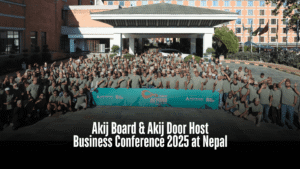
Akij Board & Akij Door Host Business Conference 2025 at Nepal
Akij Board and Akij Door, two leading brands of AkijBashir Group, made history by successfully hosting the Evolve Beyond Business Conference 2025 on November 11, 2025, at the iconic Soaltee Hotel in Kathmandu, Nepal – marking the first time in Bangladesh’s board industry that a dealers conference was held beyond national borders. The event brought together more than 370 business associates, dealers, and representatives from across the country, creating an atmosphere of unity, pride, and celebration. Amid the breathtaking Himalayan landscape and Nepal’s serene charm, participants experienced an unforgettable blend of strategic discussions, cultural exploration, and joyous moments. The cool mountain air, picturesque surroundings, and warm Nepali hospitality made the event not only a milestone in business history but also a lifetime memory for everyone who attended. Continuing the legacy of last year’s “Evolve Beyond” theme, the 2025 edition inspired participants to push boundaries, embrace innovation, and envision greater growth. The conference served as a dynamic platform to align future business goals, strengthen partnerships, and celebrate the collective achievements of Akij Board and Akij Door’s nationwide network. The event was graced by the presence of Chief Operating Officer Khourshed Alam, Accounts and Finance Director Mohammad Zahid Hossain, Head of Sales Md. Nazrul Islam, Head of Production Sk. Zakaria Nashim, along with senior officials from various departments of the organization. Their inspiring addresses motivated participants to continue striving for excellence and to take pride in being part of Akij Board & Akij Door’s promises. A key highlight of the event was the unveiling of three groundbreaking products – SYNCHRO, FiberCem, and Ultimatt. Synchro is a premium textured board with perfectly matched designs that mimic natural materials called Synchronized Melamine Board. FiberCem is a high-performance fiber cement board offering exceptional strength and versatility for interior and exterior use. And Ultimatt is a revolutionary super-matt, silky-touch, anti-fingerprint surface ensuring superior durability, scratch resistance, and colour stability. Together, these innovations reaffirm Akij Board’s leadership in advanced, design-driven surface solutions. The conference concluded with a spectacular cultural gala night filled with music, laughter, and celebration, a fitting finale to an event that perfectly blended business vision with unforgettable experiences. As Akij Board and Akij Door Evolve Beyond Business Conference 2025, Nepal Edition came to an end, it reaffirmed that Akij Board and Akij Door stand stronger than ever – ready to evolve, lead, and shape the future of the industry with innovation, partnership, and passion.
Read More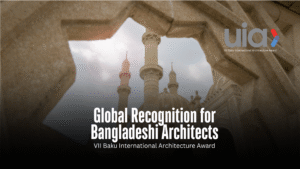
Global Recognition for Bangladeshi Architects
Bangladeshi architects have once again demonstrated their creative strength on the global stage, securing multiple honours at the prestigious VII Baku International Architecture Award. Organised by the Ministry of Culture of the Republic of Azerbaijan and the Union of Architects of Azerbaijan, with the endorsement of the International Union of Architects (UIA), the biennial competition has become a landmark event in the architectural calendar. This year’s edition attracted 270 applications from 38 countries, underscoring its reputation as a truly international platform for design excellence. The award is open to all qualified architects worldwide, offering opportunities for recognition across diverse categories. Against this competitive backdrop, five projects from Bangladesh stood out, earning accolades that highlight the country’s growing influence in contemporary architecture. BANGLADESHI WINNERS ACROSS CATEGORIES In Category B – Best Implemented Project of Residential Architecture, Architect Zishan Fuad Chowdhury won second prize for Neer – Vacation House, a project that blends modern design with contextual sensitivity. In the same category, Architect Mohammad Masud secured third prize for Meghrod – Sun and Cloud, a residential concept that celebrates light and openness. Bangladeshi architects also excelled in Category C – Best Implemented Interior. The Coca-Cola Office Interior by Architect Sharif Uddin Ahammed won second prize, recognised for its innovative approach to workplace design. Architect Shams Sanjida earned third prize in the same category for the Mak Design House, a project praised for its aesthetic coherence and functional elegance. In Category D – Best Non-Realised Project, Architect Sarawat Iqbal won second prize for Masjid Al Luqman, a design that reimagines sacred space with contemporary architectural language. These achievements reflect the breadth of Bangladeshi talent, spanning residential, interior, and conceptual design. STRUCTURE OF THE AWARDS The competition is divided into seven categories: A – Best implemented project of public architecture B – Best implemented project of residential architecture C – Best implemented interiors D – Best non-realised project E – Best implemented project in landscape architecture F – Best implemented project in rehabilitation and reconstruction of historic buildings G – Best publication in the field of architecture Each category recognises excellence in both realised and conceptual projects, ensuring that innovation at every stage of design is celebrated. PRIZES AND RECOGNITION The awards carry significant recognition and financial rewards. First prize winners receive 4,000 AZN (€2,240), a first-degree diploma, and a symbolic cup. Second prize winners are awarded 2,500 AZN (€1,400) and a second-degree diploma, while third prize winners receive 1,000 AZN (~€560) and a third-degree diploma. Beyond monetary value, the awards provide international visibility, positioning winners within a global network of architects and institutions. JURY AND CEREMONY The jury for the 2025 edition comprised distinguished architects from around the world: • Antonio Riverso (Italy), Professor, International Academy of Architecture • Michel Barmaki (Lebanon), Chairman of Barka Sarl • Nikos Fintikakis (Greece), UIA Jury Representative • Young-Keun Han (South Korea), President of the Korean Institute of Architects • Elbay Gasim-zada (Azerbaijan), Representative of the Organisers The results were announced at a ceremony on October 2 this year at the Four Seasons Hotel in Baku, Azerbaijan. The event reinforced Baku’s role as a hub for architectural dialogue, bringing together professionals from across continents. LEGACY AND GLOBAL REACH Since its inception in 2013, the Baku International Architecture Award has attracted architects from 53 countries, with more than 1,200 projects submitted between 2013 and 2023. Winners have hailed from Portugal, France, USA, Slovenia, Georgia, Japan, Russia, Morocco, Croatia, Italy, Bangladesh, Spain, Ukraine, Germany, Vietnam, Singapore, Kyrgyzstan, Greece, Malaysia, South Africa, Egypt, China, Iran, Kenya, UAE, Mexico, Romania, Poland, India, Brazil, and Azerbaijan. A unique tradition of the award is the symbolic gesture of sending a cup identical to that awarded to first-prize winners to France, where it is safeguarded at the headquarters of the International Union of Architects. This act underscores the award’s international spirit and its commitment to architectural heritage. Written by Nibir Ayaan
Read More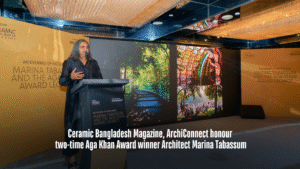
Ceramic Bangladesh Magazine, ArchiConnect honour two-time Aga Khan Award winner Architect Marina Tabassum
Ceramic Bangladesh Magazine, a publication of the Ceramic Manufacturers and Exporters Association (BCMEA), and ArchiConnect, a buildtech platform, honoured Architect Marina Tabassum on Saturday evening, November 8, 2025, Bangladesh’s only two-time winner of the Aga Khan Award for Architecture—one of the most prestigious awards in the world for architects. At the programme, held at the Renaissance Dhaka Gulshan Hotel, the globally acclaimed architect delivered a keynote speech titled “Between Erosion and Emergence”, highlighting different aspects of the projects that brought her international recognition. Before her keynote, Architect Jalal Ahmed, founder and CEO of ArchiConnect, explained why Marina Tabassum’s achievement should be celebrated and how significant it is. He said the Aga Khan Award for Architecture is considered the “Oscar for Architects,” and winning it twice is a phenomenal success for any architect in the world. Later, Marina presented details of her various projects worldwide. Bait Ur Rouf Mosque, completed in 2012 on the outskirts of Dhaka, was the project that earned her the prestigious Aga Khan Award for Architecture in 2016. “Built with locally sourced brick and devoid of traditional Islamic iconography, it offers a contemplative space where worshippers are bathed in natural light,” she said at the event. “The structure is not just a place of prayer—it’s a refuge for a dense, underserved neighbourhood.” She also shed light on one of her most celebrated recent projects, Khudi Bari, a modular, lightweight shelter designed for ultra-low-income populations. The structure, made of bamboo and corrugated metal, can be assembled quickly and relocated as needed. Earlier, Chief Adviser Professor Muhammad Yunus, in a public congratulatory message, echoed this sentiment: “We fondly recall your first Aga Khan Award in 2016 for the Bait Ur Rouf Mosque in Dhaka, a milestone that celebrated the timeless values of spirituality, community, and simplicity in architecture.” “That recognition marked the rise of a Bangladeshi voice of global significance, and your latest achievement further strengthens that legacy.” In 2025, Khudi Bari earned Tabassum her second Aga Khan Award for Architecture, making her the only Bangladeshi architect to win the honour twice. That same year, she was commissioned to design the Serpentine Pavilion in London—an international recognition of her ability to merge local wisdom with global relevance. Later, at the day, an engaging panel discussion was organised on “Marina Tabassum and the Aga Khan Award Legacy”. The session was moderated by Architect Mahmudul Anwar Riyaad, principal designer and director of DWM4 Architects. Distinguished panelists included Architect Professor Fuad Hassan Mallick, dean of the School of Architecture and Design (SoAD) at BRAC University; Architect Professor Zainab Faruqui Ali, chairperson of the Department of Architecture at BRAC University; and Architect Nahas Ahmed Khalil, principal designer at ARC Architectural Consultants. The event concluded with closing remarks by Moynul Islam, president of BCMEA. “We always look forward to creative minds like architects and the brilliance of Architect Marina Tabassum deserves to be celebrated.” Following the panel discussion, mementos were presented to the distinguished panelists and to Architect Moushumi Ahmed, the gracious host of the evening. The honorees—Architect Marina Tabassum, Architect Jalal Ahmed, and Moynul Islam, President of BCMEA—received exquisite woodprint artworks created by renowned artist Professor Anisuzzaman Anis of the Department of Printmaking, Faculty of Fine Art, University of Dhaka Written by CBM Desk
Read More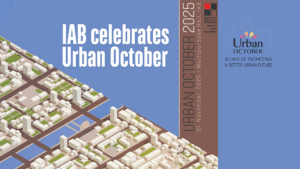
Urban October 2025: IAB Organises Daylong Event, Three-Day Exhibition
The Institute of Architects Bangladesh (IAB) on November marked Urban October 2025 with a day-long celebration at its Multipurpose Hall, bringing together students, professionals, and policymakers to reflect on the future of urban design in Bangladesh. Timed to coincide with World Architecture Day, World Habitat Day, and World Cities Day, the event began at 10:30 am with the opening of a three-day exhibition showcasing student urban design studio projects from architecture departments across IAB-accredited universities. Participating institutions include Bangladesh University of Engineering and Technology (BUET), Bangladesh University (BU), BRAC University (BRACU), Chittagong University of Engineering and Technology (CUET), North South University (NSU), American International University-Bangladesh (AIUB), Ahsanullah University of Science and Technology (AUST), Khulna University (KU), Shahjalal University of Science and Technology (SUST), Dhaka University of Engineering and Technology (DUET), Daffodil Institute of IT (DIT), Southeast University (SEU), Stamford University, State University, and the University of Asia Pacific (UAP). There was a roundtable discussion on “Shaping Cities: The Role and Future of the Urban Design Profession in Bangladesh” led by academicians. The exhibition offers a glimpse into the next generation’s vision for Bangladesh’s urban future, with models and visualisations of cityscapes, transport corridors, and public spaces. At 4:00 pm, the main programme commenced with a roundtable discussion titled “Interference to Planning: DAP”, led by Team Environment & Urbanisation from IAB’s 26th Executive Council. The session addressed concerns surrounding the Detailed Area Plan (DAP) and its implications for sustainable development, zoning, and citizen engagement. The theme for this year’s World Cities Day — “People-centred Smart Cities” —guided the evening’s discussions. A documentary presentation highlighted month-long Urban October activities, including editorial seminars and conventions. Experts and stakeholders then joined a panel discussion, followed by speeches from the chairperson, the chief guest. The event concluded with a vote of thanks. Held under the banner of Urban October, the celebration reaffirms IAB’s commitment to shaping inclusive, resilient, and well-planned cities. As Bangladesh continues to urbanise rapidly, today’s gathering serves as both a showcase and a call to action — urging architects to lead with vision, integrity, and public purpose. The World Cities Day 2025 event ended with the distribution of certificates. Programme Schedule: Location: IAB Office Date: November 1, 2025 Time: Exhibition: 10:30 am Main programme: 4:00 pm Written by Nibir Ayaan
Read More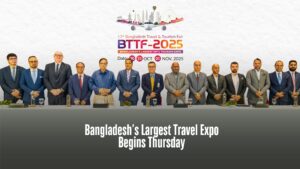
Bangladesh’s Largest Travel Expo Begins Thursday
The 13th edition of the Biman Bangladesh Travel & Tourism Fair (BTTF) 2025 opened Thursday morning at the Bangladesh-China Friendship Conference Center (BCFCC) in Dhaka, marking the return of the country’s largest international tourism expo. Organised by the Tour Operators Association of Bangladesh (TOAB), the three-day event runs from October 30 to November 1 and is expected to draw tens of thousands of visitors, including over 2,000 trade professionals. The fair is open daily from 10:00 AM to 8:00 PM, with an entry fee of Tk 50 per person. Students, freedom fighters, and July war heroes are granted free entry, ensuring inclusive access to the event. This year’s fair features participation from more than 120 local and international organisations, showcasing their products and services through around 220 stalls and 20 pavilions. Among the international participants are national tourism boards, airlines, tour operators, hotels, resorts, travel agencies, financial institutions, and healthcare providers. Twenty international hospitals are promoting medical and wellness tourism, reflecting the growing interest in cross-border healthcare travel. Biman Bangladesh Airlines is the title sponsor of BTTF 2025, joined by IHG Hotels & Resorts as the gold partner and bKash as the payment partner, with cashback offers available for visitors purchasing entry tickets via bKash. Spanning 60,000 square feet, the exhibition is divided into four themed halls—Celebrity, Carnival, Harmony, and Milky Way—designed to facilitate targeted engagement between exhibitors and attendees. The layout includes dedicated spaces for B2B sessions, seminars, country presentations, cultural performances, and documentary screenings on Bangladesh’s tourist attractions, offering a comprehensive platform for both commercial exchange and public interaction. The opening ceremony on Thursday was presided over by Md. Rafeuzzaman, president of TOAB, and formally inaugurated by Lutfe Siddiqi, special envoy to the chief adviser on international affairs, who served as chief guest. Md. Taslim Amin Shovon, director (trade & fair) at TOAB, delivered the welcome address, while Mohammad Yunus, director (media & publications), conducted the programme. Friday’s programme includes a B2B networking session, multiple seminars, and a roundtable discussion, while Saturday will feature a grand raffle draw and the closing ceremony. Daily cultural shows and sideline events are expected to enhance visitor engagement. TOAB, which has been organising BTTF annually since 2007, aims to position Bangladesh as a competitive player in the global tourism market. With 751 active members, the association regularly participates in international fairs such as ITB Berlin, WTM London, and FITUR Madrid, and collaborates with the Ministry of Civil Aviation and Tourism, Bangladesh Tourism Board, and Bangladesh Parjatan Corporation. According to organisers, BTTF 2025 is designed to promote both inbound and outbound tourism, with a special focus on niche segments including culinary, cultural, leisure, cruise, and adventure travel. Business and corporate travel also feature prominently, alongside medical tourism, which has seen increased demand in recent years. Distinguished guests at the inauguration included Saima Shahin Sultana, chairman of Bangladesh Parjatan Corporation; Naila Ahmed, joint secretary (tourism-1 branch) of the Ministry of Civil Aviation and Tourism; Dr. Md. Shafiqur Rahman, managing director and CEO of Biman Bangladesh Airlines; Md. Mainul Hasan, additional IGP of Bangladesh Tourist Police, and Nuzhat Yasmin, CEO of Bangladesh Tourism Board, alongside TOAB advisors, directors, and steering committee members. Written by Nibir Ayaan
Read More
CUET to Host 3rd International Conference on Green Architecture
The Chittagong University of Engineering and Technology (CUET) will host the third International Conference on Green Architecture (ICGrA 2025) from December 4-5 this year, bringing together more than 100 scholars and thousands of professionals to explore sustainable design and community-scale environmental responsibility. The conference will be jointly organised by the Green Architecture Cell (GrACe) and the Department of Architecture (DoA) of Bangladesh University of Engineering and Technology (BUET) and Chittagong University of Engineering and Technology (CUET). Themed “Healthy Buildings on the Path to nearly Zero Emission Communities (neZECom),” the event will examine the relationship between building-level well-being and broader sustainability goals. The Bengali interpretation of neZECom, “Reduce self-need,” reflects the conference’s ethos: a low-emission future begins with mindful consumption and responsible environmental behaviour. Building on the success of its earlier editions in 2017 and 2018, ICGrA 2025 continues a legacy of fostering awareness and collaboration on sustainability in the built environment. The conference venue, CUET’s Department of Architecture, lies between the Bay of Bengal and the Chittagong Hill Tracts, offering a scenic setting for dialogue and discovery. The conference is supported by a wide network of collaborators, including the Institute of Architects Bangladesh (IAB), Bangladesh Institute of Planners (BIP), the ZEMCH Network at the University of Melbourne, and architecture departments from DUET, KUET, RUET, KU, SUST, MIST, and Dhaka University, alongside institutional partners such as the Bangladesh House Building Finance Corporation (BHBFC) and alumni associations from BUET and CUET. Prof. Dr. Md Ashikur Rahman Joarder of BUET is chairing the ICGrA 2025 and Prof. Dr. Sajal Chowdhury of CUET is the conference secretary. The 2025 edition will feature keynote addresses, paper and poster presentations, exhibitions, cultural events, and the publication of proceedings. Selected papers will be considered for publication in indexed journals. Five parallel workshops will be organised on separate topics as part of the third ICGrA 2025. Each workshop will be led by distinguished faculty members from BUET and CUET, offering participants the opportunity to engage directly with experts in the field. Workshop Topics and Leaders • Thermal Comfort Led by: Prof. Dr. Khandakar Sabbir Ahmed, BUET Focus: This workshop will delve into strategies for achieving optimal thermal conditions in buildings, addressing passive cooling, material selection, and climate-responsive design to enhance occupant comfort and energy efficiency. • Acoustics Led by: Prof. Dr. S. M. Najmul Imam, BUET Focus: Participants will explore acoustic performance in architectural spaces, including noise control, sound insulation, and design techniques for creating healthy auditory environments in residential and public buildings. • Daylighting Led by: Prof. Dr. Md. Ashikur Rahman Joarder, BUET Focus: This session will examine the role of natural light in building design, covering daylight simulation, visual comfort, energy savings, and integration of daylighting strategies into architectural planning. • Environmental Experience Design (EXD) Led by: Prof. Dr. Sajal Chowdhury, CUET Focus: The workshop will introduce participants to user-centred environmental design, focusing on sensory experience, spatial perception, and psychological well-being in built environments. • Computational Building Information Modeling (BIM) Led by: Md Mizanur Rahman of BUET Registration Details Date: December 5, 2025 Time: 10:00 AM – 4:00 PM Venue: CUET, Chattogram, Bangladesh Early Bird Registration (per topic): Tk 5,000 (by October 31, 2025) Regular Registration (per topic): Tk 7,000 (by November 15, 2025) Seats are limited, and participants must complete a separate registration for each workshop they wish to attend. Individual registration is allowed for any of the four topics. Awards will be presented for Best Paper, Best Presentation, and Best Poster. Topics for submission span health and well-being, green buildings, zero energy and emissions, community and lifestyle, user-centred design, climate resilience, decarbonisation, circularity, life cycle assessment, energy efficiency, vernacular architecture, retrofitting, conservation, innovation, policy, materials, methods, water and waste management, safety, and pedagogy. Organisers say ICGrA 2025 aims to drive practical action, inform policy, and strengthen academic and professional collaboration across disciplines. Written by Nibir Ayaan
Read More
Architect Irteza Ameen to Deliver Fall 2025 Lecture
The Department of Architecture at Bangladesh University is set to host the third lecture of its Fall 2025 series, spotlighting the power of visual storytelling in design. Titled “From Concept to Composition: Building Visual Narratives,” the session will feature Architect Irteza Ameen, founder of the multidisciplinary studio Design Commune. This lecture marks the 14th instalment of Chorcha, the department’s signature platform for architectural discourse. Ameen will guide audiences through the evolution of design thinking—from the spark of abstract ideas to their transformation into spatial compositions where form, material, and graphic language converge to express identity and intent. Drawing from a rich and varied portfolio, Ameen will demonstrate how visual storytelling functions not only as a design tool but as a communicative language—shaping how we interpret, inhabit, and emotionally connect with space. Ameen, a Bangladeshi architect and designer, is known for his seamless integration of architecture, graphic design, and user experience. His studio, Design Commune, operates at the intersection of built form and cultural narrative, crafting works that are both contextually grounded and visually articulate. His notable collaborations include archival and publication projects on three of Bangladesh’s architectural luminaries—Architect Muzharul Islam, Architect Bashirul Haq, and Professor Shamsul Wares—as well as a wide array of architectural, interior, and exhibition design ventures. Through his practice, Ameen exemplifies a rare synthesis of architectural rigour and graphic precision, producing designs that resonate with character, clarity, and cultural depth. Event Schedule: Date: Saturday, November 1, 2025 Time: 3:30 pm Venue: Room 101, Department of Architecture, Bangladesh University. Written by Nibir Ayaan
Read More
FORM.3 Architects Wins Holcim Foundation Awards 2025
FORM.3 Architects and team have been honored with a Regional Award in the Asia Pacific category at the Holcim Foundation Awards 2025. The firm has won the prestigious award for their project: ‘Conservation of Old Dhaka Central Jail History, Historical Buildings & Development of Surroundings Area’. The project reimagines a historic jail site in Old Dhaka as a vibrant public realm, merging adaptive reuse, passive design, and local craft to create a culturally rooted and economically viable model for sustainable urban renewal. From the team of Form.3 Architects, the historical site served as a fort from 𝐩𝐫𝐞-𝐌𝐮𝐠𝐡𝐚𝐥 𝐞𝐫𝐚 before it turned into a jail in 𝟏𝟕𝟖𝟖 (and Lunatic asylum later) by the Britishers, and continued to serve as jail till 2016 after 𝟐𝟐𝟖 𝐲𝐞𝐚𝐫𝐬. Every brick in the compound whispers the tale of Dhaka’s origin — echoing the rise and fall of a region etched in time. The new developments around the historical conservation area are intended to create 𝐩𝐮𝐛𝐥𝐢𝐜 𝐨𝐩𝐞𝐧 𝐬𝐩𝐚𝐜𝐞𝐬 𝐰𝐢𝐭𝐡 𝐜𝐢𝐯𝐢𝐜 𝐚𝐦𝐞𝐧𝐢𝐭𝐢𝐞𝐬 such as car parking, wider roads with footpaths, proposed new roads, parks, children’s parks, conserved waterbodies, experiential waterfront walkways, mosques, playgrounds, food courts and restaurants, traditional shops, a gymnasium, a swimming pool, a cineplex, and multipurpose spaces — all within one of the most densely populated neighborhoods in the world. The Holcim Foundation Awards are the world’s most significant competition celebrating sustainable design and construction — spotlighting projects that are reshaping the built environment and driving transformation across the construction sector. Founded in 2003, the Holcim Foundation has led the global movement for sustainable design and construction, guiding the global building industry with its visionary initiatives. “This year’s 20 winners use the right materials in the right places, bring communities into the process from day one, and design with nature as an ally. The projects are inspiring because the solutions they offer are replicable and implementable – they set a credible path forward for industry,” says Laura Viscovich, Executive Director, Holcim Foundation. The Holcim Foundation for Sustainable Construction has announced twenty winning projects for the 2025 Holcim Foundation Awards, spanning Asia Pacific, Europe, Latin America, the Middle East and Africa, and North America with a prize pool of USD 1 million. An event will be held in Venice on November 20, 2025, to showcase all the winners, with a global live stream for the worldwide audience. Photo Credit City Syntax
Read More
Rezwan’s floating school wins Unesco Confucius prize
Bangladeshi architect Mohammed Rezwan’s solar-powered floating schools have received the Unesco Confucius Prize for Literacy 2025, one of the world’s highest honours for advancing education and lifelong learning. The Chinese government sponsors this award, said a press release. Among hundreds of nominations worldwide, Unesco selected three winners: Bangladesh’s Shidhulai Floating Schools, Ireland’s Learn with NALA eLearning, and Morocco’s Second Chance School and Inclusive Education Program. The 20th award ceremony was held on September 27 in Qufu, Shandong Province, China, the birthplace of Confucius. Rezwan accepted the trophy and certificate on behalf of his organisation, Shidhulai Swanirvar Sangstha, which launched the world’s first floating school in 2002. Growing up in Chalanbeel, he saw how annual floods forced schools to close for months. His simple yet transformative solution was to take schools to the water. Today, solar-powered boats serve as classrooms, libraries, and training centres that keep learning alive even when villages are submerged. Unesco praised the initiative for “delivering literacy education to marginalised learners in flood-prone regions through locally rooted innovation.” The Shidhulai floating school programme has now been replicated across Bangladesh by other NGOs and inspired similar projects throughout Asia, Africa, and Latin America. The Bangladesh government has incorporated Rezwan’s floating schools into the National Adaptation Plan 2050. “Education is not only about reading and writing,” Rezwan said. “It is about fostering peace, equality, and resilience. With literacy and knowledge, our youth can build a future where no disaster prevents children from learning.” A photo series titled “Boat Schools of Bangladesh — Future That Floats” is on display at the French National Museum of Immigration History’s Migrations and Climate exhibit in Paris through April 5, 2026. The TRT World documentary “Bangladesh Turns Tide on Climate Change with Floating Schools” is a finalist for the Save the Children Global Media Awards 2025. Rezwan’s work is also featured in Julia Watson’s book Lo–TEK: Water, which highlights 22 contemporary TEK-based innovations worldwide. Source: The Daily Star
Read More
Cubeinside Design bags DNA Paris Design Awards 2025
Cubeinside Design Ltd, a prominent Bangladeshi architectural and interior design firm, has earned international acclaim after being named one of the winners at the DNA Paris Design Awards 2025—an internationally sought-after recognition for architects and creative people. The award-winning project, Bait Ur Rayyan, is a small-scale mosque designed by Cubeinside, located near the banks of the mighty Arial Kha River in Bangladesh’s Madaripur. The Bangladeshi firm was the consultant for the project, built for the Rokeya Feroza Foundation on a land area of 7,346 square metres. Cubeinside says: “This particular design is an exercise of abstract interpretation of basic symbolism of Islamic architecture. Geometry has been the principal tool for this abstraction in terms of transforming both the form and spatial quality.” The DNA Paris listed Khandaker Ashifuzzaman and Shakhawat Hossain Rocky as the lead designers of Bait Ur Rayyan, which won the award in the Public Architecture category. The annual awards also mentioned Mehri Farnaz, Anis Khan Shanto and Abdullah Al Jaber as members of the mosque’s design team. About the mosque, it was noted on the DNA Paris website: “A human-centric approach created a space for community, keeping the scale sacred yet intimate, using local materials like red bricks, while lights played the most vital role to uplift the spiritual entity of this mosque.” “The concept of ‘Abstract Semiotics’ was applied in measurable mass and space, and other immeasurable aspects with a deeper perceptual level.” DNA Paris, which celebrates the best in global design from over 70 countries, recognises excellence in Architecture, Landscape, Interior, Product and Graphic Design, with entries divided into ‘Professional’ and ‘Emerging’ categories. The latter is reserved for outstanding student work. Farmani Group, a global authority in architecture, design and photography curation, in partnership with In Between, a Paris-based collective of creatives and thinkers, jointly organise the DNA Paris Design Awards. In addition to typology-based subcategories, the most distinguished entries across all five disciplines and both sections are awarded the Grand Prix—the highest honour of the programme. Recipients of the Grand Prix receive a trophy created by Studio Briand & Berthereau, designed to strike a balance between form and function, while addressing the financial and environmental constraints faced by every project. All submissions are evaluated by an expert jury of design luminaries. The jury committee is comprised of designers, editors and creatives who are devoted to true excellence in design. The juries come from different countries, including the UK, the USA, Spain, Argentina, Japan, Sweden, France, Kenya, Thailand, Brazil, Italy, South Korea, Hong Kong, Mexico, Greece and Saudi Arabia. The evaluation of entries is based on a range of criteria that are constantly adapted to current standards. DNA Paris has already announced all winners across different categories for this year, who will be honoured at an event in Paris on October 24. Written by Nibir Ayaan
Read More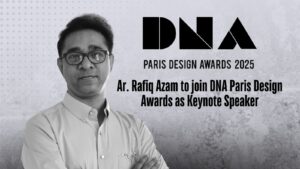
Prof Rafiq Azam to Headline DNA Paris Design Awards 2025
Prominent Bangladeshi architect Professor Rafiq Azam is all set to join the 2025 edition of the DNA Paris Design Awards—one of the most important design awards worldwide—as a keynote speaker. The internationally renowned architect, born in Old Dhaka, Bangladesh, is scheduled to participate in the show beginning on October 24 this year. He is widely recognised for his unique approach to green architecture, which weaves together tradition, nature and mysticism. Rafiq Azam, founder of SHATOTTO—an architecture firm dedicated to green living—draws inspiration from Bengali poets and mystics, while incorporating artistic influences from global masters. His designs place particular emphasis on light, shadow, water and air. With more than 30 years of experience, Professor Azam has received a number of international accolades, including the 2025 ULI Asia Pacific Awards for Excellence, the CAA Robert Mathew Lifetime Achievement Award in 2022, the ARCASIA Gold Medal, the LEAF Awards, and the UIA & UN-HABITAT Awards in 2022. His work and perspectives have appeared in leading publications such as TIME Magazine, The New York Times and CASA Vogue. As a visiting professor at BRAC University, Professor Azam supports emerging architects through the Rafiq Azam Travel Bursary programme. The DNA Paris Design Awards, where the renowned Bangladeshi architect will deliver a keynote speech, celebrate the best in global design from over 70 countries. The annual awards recognise excellence in Architecture, Landscape, Interior, Product and Graphic Design, with entries divided into ‘Professional’ and ‘Emerging’ categories. The latter is reserved for outstanding student work. The DNA Paris Design Awards are organised by the Farmani Group, a global authority in architecture, design and photography curation, in partnership with In Between, a Paris-based collective of creatives and thinkers. In addition to typology-based subcategories, the most distinguished entries across all five disciplines and both sections are awarded the Grand Prix—the highest honour of the programme. Recipients of the Grand Prix receive a trophy created by Studio Briand & Berthereau, designed to strike a balance between form and function, while addressing the financial and environmental constraints faced by every project. All submissions are evaluated by an expert jury of design luminaries. The jury committee is comprised of designers, editors and creatives who are devoted to true excellence in design. The juries come from different countries, including the UK, the USA, Spain, Argentina, Japan, Sweden, France, Kenya, Thailand, Brazil, Italy, South Korea, Hong Kong, Mexico, Greece and Saudi Arabia. The evaluation of entries is based on a range of criteria that are constantly adapted to current standards. The 2025 edition’s project submission early bird deadline began on December 13, 2024, while the regular deadline ended on May 9 this year. However, the late final deadline was extended until May 23 of the current year. The entry fee for professional project submissions in the architecture, interior, landscape and product categories was 350 British pounds, while it was 100 British pounds for the graphic category. For students, the entry fee for every category was set at 75 British pounds. DNA Paris has already announced the winners for this year, who will be honoured at an event in Paris on October 24. This year, Bait Ur Rayyan—a project by Cubeinside Design Limited, a Bangladeshi architecture firm—has emerged as one of the winners of the DNA Paris Design Awards in the Public Architecture category. On the DNA Paris website, Khandaker Ashifuzzaman and Shakhawat Hossain Rocky are listed as the lead designers of Bait Ur Rayyan, with Mehri Farnaz, Anis Khan Shanto and Abdullah Al Jaber named as members of the design team. Written by Nibir Ayaan
Read More
AkijBashir Group has entered into a strategic partnership with the Infrastructure Development Company Limited (IDCOL)
In a major step toward sustainable industrial growth, AkijBashir Group has entered into a strategic partnership with the Infrastructure Development Company Limited (IDCOL) to promote energy efficiency and renewable energy across its operations. The collaboration, formalized at an event held at Sheraton Dhaka, marks a significant milestone in advancing green industrial practices in Bangladesh. AkijBashir Group has been funding several sustainability projects in the last couple of years through its Energy Efficiency and Rooftop Solar financing programs funded by IDCOL. These projects have enabled the deployment of industrial rooftop solar capacity of more than 90MWp, of which over 60MWp has been deployed and has become one of the largest solar portfolios in the private sector in Bangladesh. One of the highlights of the joint venture is a pioneer project of Janata Jute Mills Ltd. in Boalmari, Faridpur, that will become the first in the world to be a fully operational jute mill using renewable energy by the first quarter of 2026. In the long-term sustainability, the Group targets to produce a renewable energy of 1,000 MWh every day by 2027. During the event, AkijBashir Group Managing Director, Mr. Taslim Md. Khan, and IDCOL Executive Director and CEO, Mr. Alamgir Morshed, emphasized the role of collaboration in the development of the future of the low-carbon industry. AkijBashir Group is determined to be 100% renewable in all its manufacturing plants by the year 2030, which is in line with its vision Beyond Tomorrow- impetus on sustainability, innovation, and industrial perfection.
Read More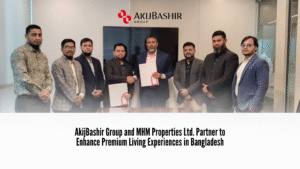
AkijBashir Group and MHM Properties Ltd. Partner to Enhance Premium Living Experiences in Bangladesh
AkijBashir Group has signed a strategic partnership with MHM Properties Ltd. to strengthen collaboration in providing premium building material solutions and enhancing customer value in Bangladesh’s real estate and construction sectors. The Memorandum of Understanding (MoU) was signed on October 14, 2025, marking a significant step toward integrating design excellence, innovation, and quality in modern living spaces. In the deal, MHM Properties Ltd. will promote and sell the top brands of AkijBashir, namely, Akij Ceramics, ROSA Sanitaryware, Akij Particle Board Mills Ltd., Akij Door, Akij Bathware, and AkijBashir Glass using its own network and outlets. The partnership is expected to provide the tiles, sanitaryware, bathware, boards, doors and glasses, as a one-stop solution in the world-class quality and design of their products, with the aim of having a trusted partner. Directors of MHM Properties Ltd. Mr. Mahmudul Hasan Tonmoy, Director, Akij Ceramics Ltd. Mr. Mohammed Ashraful Haque, General Manager, Sales, and AkijBashir Group Chief Operating Officer were the signatories of the MoU. At the signing, Mr. Khourshed Alam remarked that we are happy to collaborate with MHM Properties Ltd. in order to increase the outlets of the various product lines of AkijBashir. This alliance is indicative of our mission to combine design, innovation, and quality to augment living standards in the contemporary setting in Bangladesh. Mr. Mahmudul Hasan Tonmoy also added that this is a joint venture that we want to add more value and ease to our customers as we provide a broad spectrum of high-end building materials and finishes that are both fashionable and timeless. The partnership brings a fresh start, and combining expertise and innovation, the coalition will define exquisite, sustainable, and inspirational homes throughout Bangladesh.
Read More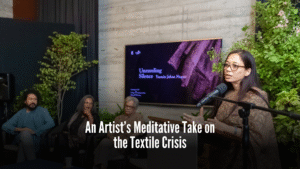
An Artist’s Meditative Take on the Textile Crisis
On 10th October, Bengal Shilpalay’s Quamrul Hassan Hall made room for Yasmin Jahan Nupur’s solo exhibition to breathe in silence. Silence that carries the weight of unspoken resistance, forged over decades. Each corner is equipped with different kinds of soft sculptures and artworks, woven and drawn with bare hands. These sculptures will urge you to zoom in, squint, and at times, resist touching and feeling their texture. The space is surrounded by a variety of installations, including tapestry, jamdani woven in a grid-like matrix, a golden net made of zari threads, Bangla phrases stitched in muslin fabric, and hand-drawn textures and patterns. The sculptures, made from gentle materials like thread and wool, celebrate their natural malleability and softness. Her meticulously executed works on paper using only pen and watercolor draw viewers into their quiet depths. In contrast, Nupur’s brass sculptures defy expectation, transforming rigid metal into forms that appear almost supple. As one takes a closer look, they can find the artist’s sheer brilliance of witty and powerful juxtaposition of delicate threads and robust objects. One of the guests at the opening, globally famous architect Marina Tabassum, who won Aga Khan Award twice, reflected on the powerful presence of silence—describing it as an equally vital element in architecture, a space everyone strives to reach, yet few truly achieve in the process of creation. She observed that Nupur’s works embody that very quality, carrying a quiet strength despite being crafted from simple materials like strand and wool. The softness of Nupur’s sculptures and the intricacies of her work, in fact, carry a more concrete and unsettling truth—illuminating the fading textile legacy of Bengal. Behind these delicate forms lie the stories of countless artisans unable to continue their craft, disrupted not only by economic pressures but also by colonial legacies and ecological changes. A powerful installation in the exhibition was a dazzling hanging burqa. While the traditional burqa symbolizes modesty and concealment, Nupur reimagined it as a three-dimensional form embroidered with gold and silver zari threads—not as a symbol of elegance, but as a testament to distressed endurance. Nupur’s professor, Abul Monsur, recalls how her gentle demeanor during her time at the Fine Arts Institute, CU, fooled him into perceiving her as rather fragile. Her quiet resilience and unwavering devotion to her craft beneath that delicate surface only proved him wrong over time. Yasmin Jahan Nupur not only hails a heavy portfolio of glorious works but also became a household name in the international galleries. This second solo exhibition is Nupur’s careful documentation and a commitment to preserving the vanishing heritage of Bangladesh’s textiles. As visitors walk through the gallery, they are compelled to stop, gaze, and ultimately begin to unravel the silences behind each piece. “Even though the voice may be muted or just a soft whisper (mridu shor), the visitors must take the time to truly listen,” quotes curator Tanzim Wahab. “Unravelling Silence” is on view until November 22, every day from 4 to 8 PM, except Sundays, at Bengal Shilpalay. Written by- Fariha Hossain
Read More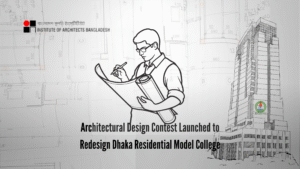
Architectural Design Contest Launched to Redesign Dhaka Residential Model College
A nationwide architectural design competition has been launched to transform the campus of Dhaka Residential Model College (DRMC), one of Bangladesh’s most prestigious educational institutions. The initiative, jointly organised by the Institute of Architects Bangladesh (IAB) and DRMC, calls for proposals to design a ten-storied academic building that will serve as a modern educational hub for over 3,000 students. The competition aims to address long-standing infrastructural challenges at DRMC, which currently operates in two shifts due to a shortage of classroom space. With most of its buildings dating back to the 1960s, the college’s facilities are no longer adequate to meet the demands of its growing student body and evolving academic programs. A Legacy in Transition Established in 1960, DRMC spans 52 acres in Mohammadpur and accommodates approximately 6,000 students across various academic levels. Initially governed by the Central Government of Pakistan, the institution underwent several administrative transitions before being placed under the Ministry of Education in 1972. Despite its autonomous status and historical significance, the college’s infrastructure has aged considerably, prompting the Board of Governors (BOG) to approve a major upgrade during its 162nd meeting on June 26, 2025. The new academic building will be constructed on a 3,000 sq.m site currently occupied by a grassy football field. According to the competition brief, the structure will be a reinforced concrete (RCC) building with pile foundation, designed to accommodate students from classes 9 to 12. Facilities will include a cafeteria, exam halls with 800 seats, modern toilets, and parking provisions. Competition Details and Design Vision The competition, launched on October 5, 2025, is a single-stage open call for Bangladeshi architects. It seeks innovative, sustainable, and contextually responsive designs that integrate seamlessly with the existing campus. Architects are encouraged to use local materials and environmentally friendly technologies, with an emphasis on rapid construction techniques and low future maintenance costs. Design considerations outlined in the brief include: climate responsiveness and passive cooling, universal accessibility, integration of landscape and open spaces, cultural and contextual relevance, interconnectivity with existing academic buildings, energy efficiency and future-readiness The building’s shape may follow an I, U, hollow box, or full box configuration, with each floor serving distinct academic and administrative functions. The ground floor will house parking and essential services, while upper floors will include classrooms, laboratories, faculty offices, and student amenities. Organisers and Eligibility The competition is jointly organised by IAB and DRMC. Eligible participants must be regular IAB members with at least eight years of professional experience and compliance with the Dhaka Mohanagar Imarat Nirman Bidhimala, 2008. Registration, which requires a Tk 2,000 fee, is open from October 5 to October 11, 2025, at the IAB office in Sher-E-Bangla Nagar, Dhaka. Each participant will receive a unique registration code and may submit only one proposal. All submissions must maintain strict anonymity, with documents marked only by a blank square box and the registration number. Any breach of anonymity or direct contact with jury members will result in disqualification. The design competition is going to be launched on October 5,2025, inviting participants to register by October 12. A query session will open on October 13, and all inquiries will be addressed by October 15. Participants must submit by November 20. Jury Deliberation will take place in November 22 to December 9, followed by an exhibition scheduled for December 9 to December 10, 2025. Submissions must include conceptual sketches, detailed plans, elevations, sections, renderings, and a physical model. Reports on design concepts and estimated construction costs are required in sealed envelopes. Digital copies must be submitted via DVD or pen drive. The brief also requires labelling with the 14-digit registration number and a blank square box. The jury panel comprises five distinguished members: Brigadier General Mohammed Zaber Hossain, PhD – Principal, DRMC, Moshiur Rahman – Acting President, Old Remians Welfare Association, Ar Jalal Ahmed – Principal Architect, JAARCHITECTS, Ar Patrick D’ Rozario – Principal Architect, Synthesis Architects Limited, and Ar S.M. Nazimuddin Payel – Associate Professor, Architecture Discipline, Khulna University. The jury will evaluate entries based on innovation, contextual relevance, sustainability, and feasibility. Their decisions are final and binding, with results to be announced during the exhibition. Awards and Future Engagement The competition offers substantial monetary rewards and professional recognition: First Prize: Tk 2,50,000 and a certificate, Second Prize: Tk 1,75,000 and a certificate, Third Prize: Tk 1,00,000 and a certificate, Special Mentions (3): Tk 25,000 each and certificates, if awarded by the jury. The first-prize winner will be formally appointed as the design architect for the project, subject to compliance with IAB’s Code of Ethics and Professional Conduct. The appointment will follow Rule 111 of the Public Procurement Rules 2008, with consultancy fees set at 6% of the total construction cost (inclusive of AIT, exclusive of VAT). If the first-prize winner is disqualified, the second or third-place winners may be considered. A New Master Plan for DRMC The competition is part of a broader master plan revision for DRMC’s campus. The existing master plan, which did not account for new academic buildings, is being restructured to accommodate future growth and integration with existing facilities. Key components of the revised master plan include: vertical extension of Academic Building-3, extension and renovation of Kudrot-E-Khuda and Joynul Abedin Houses, construction of a duplex principal residence, a G+6 vice-principal residence, renovation of the boundary wall, upgradation of the water distribution system, and installation of a 500 KVA electric substation These developments aim to modernise the campus while preserving its legacy and enhancing operational efficiency. Legal and Ethical Framework Participants must adhere to the competition’s legal and regulatory principles. The organiser reserves the right to cancel the competition, in which case entries will be evaluated and prizes awarded. However, none of the submitted designs may be executed without the architect’s consent. In such cases, the first-prize winner will receive three times the prize money as compensation. DRMC will retain ownership of submitted documents until results are published. Entrants will retain copyright but grant DRMC a perpetual, royalty-free licence
Read More
Akij Ceramics Opens Exclusive Showroom in Savar’s Hemayetpur
Leading tiles brand Akij Ceramics has opened a new exclusive showroom in Savar’s Hemayetpur, bringing its signature craftsmanship and contemporary designs closer to customers. Located on Singair Road, the new outlet — Usha Sanitary & Tiles House — offers an enhanced retail experience with immersive displays, modern layouts, and a curated selection of Akij Ceramics’ finest collections. Mohammad Khourshed Alam, Chief Operating Officer of Akij Bashir Group; Mohammed Ashraful Haque, General Manager (Sales) of Akij Ceramics Ltd; and Md Abul Khayer, proprietor of the showroom, attended the inauguration ceremony on October 12 alongside senior officials of the group. A six-time Best Brand Award and two-time Superbrands Award winner, Akij Ceramics continues to champion innovation, design excellence, and customer trust — staying true to its timeless promise, “Promise of Perfection.” With this expansion, Akij Ceramics reinforces its vision of transforming everyday spaces into expressions of elegance, quality, and modern living. Written By Nibir Ayaan
Read More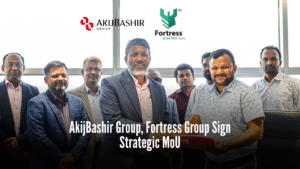
Fortress Group to Feature Leading Product Lines of AkijBashir Group
AkijBashir Group has recently teamed up with Fortress Group to expand the reach of high-quality building materials and improve the standard of premium living in Bangladesh. The two companies signed a strategic Memorandum of Understanding (MoU) at a programme on October 9. The MoU outlines plans for enhanced cooperation between the two companies, with Fortress Group set to feature AkijBashir’s leading product lines. Products from Akij Ceramics, ROSA Sanitaryware, Akij Board, Akij Door, and Akij Glass will be featured by Fortress. As part of the collaboration, customers will gain access to a complete range of tiles, sanitaryware, bathware, boards, doors, and glass products. Both companies said the partnership is aimed at providing an integrated offering for modern construction and interior design needs. AkijBashir Group Chief Operating Officer Mohammod Khourshed Alam and Fortress Group Chairman Lutfur Rahman signed the MoU in the presence of senior officials from both organisations. “We are delighted to collaborate with Fortress Group in expanding the reach of AkijBashir’s premium product portfolio to a broader customer base,” said Alam. Rahman said the partnership would allow Fortress Group to introduce a wider selection of quality products to customers, enhancing convenience and lifestyle. The two companies said the agreement marks the beginning of a new chapter in their efforts to support the creation of elegant, sustainable, and modern living spaces across the country. Written by Nibir Ayaan
Read More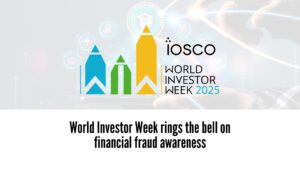
World Investor Week rings the bell on financial fraud awareness
A global initiative to promote investor education and protection is underway as World Investor Week 2025 runs from October 6 to 12, led by the International Organization of Securities Commissions (IOSCO). Now in its latest edition, the campaign aims to raise awareness about the importance of financial literacy, responsible investing, and the protection of investors in an increasingly digital and complex financial landscape. The global campaign features participation from securities regulators, exchanges, financial organisations, and educators across six continents, with events tailored to national and regional contexts. Activities include public awareness drives, webinars, training sessions, and outreach campaigns designed to help investors make informed decisions and guard against fraud. A flagship feature of the campaign is the “Ring the Bell for Financial Literacy” initiative, held in collaboration with the World Federation of Exchanges (WFE). Stock exchanges around the world symbolically “ring the bell” to demonstrate their commitment to investor education and market transparency. Focus on Fraud, Digital Threats, and Investor Awareness This year’s programme includes a strong emphasis on the emerging threat of digital fraud, particularly those involving artificial intelligence and online scams. On October 7, U.S. regulators including the National Futures Association (NFA), FINRA, and the Commodity Futures Trading Commission (CFTC) hosted a webinar titled “Deconstructing to Disrupt Fraud”, which was a two-part event featuring Dr. Arda Akartuna. The session explored how AI technologies are being weaponised by fraudsters, and how regulators and investors can respond with vigilance and education. In Indonesia, the national financial regulator Otoritas Jasa Keuangan (OJK) is hosting a regional webinar on October 9 titled “Empowering Investors: Invest Wisely and Stay Safe from Fraud and Scams.” The event features speakers from IOSCO’s Committee on Retail Investors and will discuss practical strategies to improve retail investor protection. Investor education for older adults is also a priority in this year’s campaign. In the United States, the CFTC, FBI, and AARP have partnered on outreach aimed at Americans aged 50 and older, focusing on helping them identify and avoid scams. The organisers report that over 250 participants registered for this dedicated session. Global Backing and Institutional Support World Investor Week is supported by a wide range of international partners, including: The World Bank OECD G20 Sustainable Stock Exchanges (SSE) Initiative International Financial Reporting Standards (IFRS) Foundation European Fund and Asset Management Association (EFAMA) These partnerships reinforce IOSCO’s broader mission to promote not only awareness, but also long-term behavioural change among investors and institutions globally. As the global standard-setter for securities regulation, IOSCO collaborates closely with the Financial Stability Board (FSB) and the G20 to ensure that investor protection remains a key pillar of global financial integrity and stability. Building Resilience in a Complex Investment Landscape With financial markets rapidly evolving due to digitisation, AI technologies, and cross-border investment platforms, retail investors are exposed to new complexities and risks. World Investor Week serves as a timely reminder of the need for robust financial education, stronger regulatory safeguards, and proactive public engagement. As the campaign continues through October 12, organisers hope to empower individuals with the knowledge to navigate risks, detect fraud, and contribute to more resilient financial markets across all levels of society. Written By Nibir Ayaan
Read More
Bangkok to host ASEAN Ceramics & Stone 2025 expo
Over 200 international companies and brands from the ceramics and natural stone sectors are set to convene at the ASEAN Ceramics & ASEAN Stone 2025 exhibition, scheduled to take place from October 15-17 this year at the IMPACT Exhibition and Convention Centre in Bangkok. Organised by MMI Asia, the regional arm of Messe München, in partnership with Asian Exhibition Services (AES) Ltd., the event is expected to attract more than 4,000 trade visitors. It will also facilitate over 400 buyer-seller connections, aiming to generate meaningful connections and commercial opportunities for companies across the region and beyond. Industry professionals can register for free, making the exhibition highly accessible to businesses of all sizes. The 2025 edition also marks a significant milestone with the official debut of ASEAN Stone in Thailand. This dedicated segment is being launched with the backing of Confindustria Marmomacchine, the Italian association representing the stone machinery and natural stone industry, and the Mining Council Industry Thailand (MICT), which is expected to bring an influx of global exhibitors to the Thai capital. Running alongside ASEAN Ceramics, which celebrates its ninth edition this year, the co-located exhibitions position themselves as Southeast Asia’s leading trade platform for sourcing the latest innovations, materials, machinery, and services in both the ceramics and natural stone industries. While ASEAN Ceramics covers the full spectrum of white-ware, heavy clay, and advanced ceramics manufacturing, ASEAN Stone will focus on cutting-edge tools, technologies, chemicals, and raw stone materials shaping the natural stone industry. The dual event enjoys strong backing from a wide network of industry associations and government bodies, reinforcing its status as a cornerstone trade fair for the region. Notable supporters include the Department of Industrial Promotion (DIPROM), Federation of Thai Industries, Ceramic Industry Club of Thailand (FTI-CICT), and the Thai Ceramic Society (TCS). Additional international support comes from ACIMAC (Italy), CCPIT – Building Materials Sub-Council (China), Vietnam Building Ceramic Association (VIBCA), and the Bangladesh Ceramic Manufacturers & Exporters Association (BCMEA). Conferences, Knowledge Sharing, and Cultural Elements The exhibition will commence with the ASEAN Ceramics & ASEAN Stone Conference, themed “Pioneering a Sustainable & Innovative Future for Ceramics & Stone in Southeast Asia.” The conference will bring together over 30 experts, speakers, and panelists to explore the future trajectory of these industries. Sessions will address themes such as sustainable production, digital transformation, regional competitiveness, and the role of advanced materials in future-ready infrastructure. Adding depth to the programme, exclusive pre-event factory tours will be hosted by leading Thai manufacturers Crown Ceramics and The Siam Refractory Industry Co., Ltd. These tours are designed to give attendees an insider’s look at state-of-the-art manufacturing processes, innovations in energy efficiency, and the real-world application of materials and automation in ceramic production. A key feature of this year’s event is the ASEAN Ceramics & Stone Talents Hub, an initiative aimed at bridging the gap between academia and industry. The Talents Hub will offer an important platform for companies to engage with emerging professionals, recent graduates, and technical specialists. It’s also a response to the growing need for skilled talent across materials science, design, and engineering within Southeast Asia’s fast-growing ceramics and stone sectors. Celebrating the region’s cultural roots, the event will also showcase live pottery-making demonstrations led by expert artisans from Bangkok and Nakornratchasima. These demonstrations, which use locally sourced clay, aim to highlight Thailand’s long-standing ceramic heritage, blending tradition with the creative possibilities of contemporary design. Science, Academia and Industry Collaboration Running concurrently with the trade exhibition is the International Conference for Traditional and Advanced Ceramics (ICTA). Organised by the Thai Ceramic Society (TCS) in partnership with the National Metal and Materials Technology Center (MTEC) and Chulalongkorn University’s Department of Materials Science, the ICTA conference will bring together over 15 universities and top regional researchers. The conference is expected to serve as a platform for sharing cutting-edge scientific research, university–industry collaboration models, and the latest advancements in materials technology, ceramics chemistry, and industrial sustainability. With academic and industrial stakeholders under one roof, the ICTA underscores the exhibition’s role as more than just a trade event — it is a convergence point for innovation and intellectual exchange. International Participation and Technology Highlights The 2025 edition will host an impressive range of global exhibitors, reaffirming the event’s international appeal. From the ceramics sector, major players include Siam Cement Group (SCG), ECT-KEMA, MCS Portugal, AKW (Amberger Kaolinwerke), Saint-Gobain Formula, Izawa Pigment, Guzman Minerals, Sedlecký Kaolin, Siam Technical Ceramics (STC), and MUNGYO, Gilfair, and Rajasthan Mining & Minerals. In the natural stone sector, some of the most recognised names confirmed for the show include AKEMI, Breton, Pedrini, Tenax, Italdiamant, Diabu, Chim-Italia, and Abra Iride. The natural stone industry will be equally well-represented by top-tier names including AKEMI, Midwest, Diabu, Simec, Breton, Pedrini, Tenax, Abra Iride, Chim-Italia, Italdiamant and many more — showcasing cutting-edge technologies, materials, and solutions that are shaping the future of the industry. Together, these companies represent the cutting edge of product development, fabrication technologies, surface treatments, and sustainability in materials sourcing. The event will also spotlight national pavilions from Italy (Confindustria Marmomacchine), China (CCPIT), and Thailand (TCS), as well as a dedicated EU Pavilion, which will feature the best of European ceramics and stone innovation. Attendees can expect to see a wide array of breakthrough technologies, including: 3PowerFlow Centrifugal Pump – a compact, high-efficiency pump designed for spray-drying in ceramic manufacturing, presented by Certech Group. HiCAST – a high-performance gypsum mould system for industrial-scale ceramic casting, showcased by MUNGYO. LK LAB Store – a pioneering mobile robotic warehouse system for managing slab-shaped products, developed by LK Lab. BT Master – an advanced modular system for inspecting and controlling the quality of bricks and tiles, from Ibea GmbH. Quartz Powder – high-purity silica powder with exceptional thermal stability and smooth surface finish, offered by Puresil India. Arabescato Corchia – a
Read More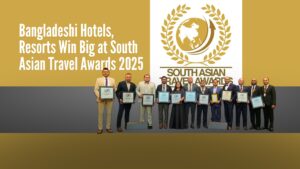
Bangladeshi Hotels, Resorts Win Big at South Asian Travel Awards 2025
Bangladesh’s hospitality sector received a resounding endorsement on the international stage as several leading local hotels, resorts, and tour operators were honoured at the South Asian Travel Awards (SATA) 2025, held at the Cinnamon Grand in Colombo. The glittering ceremony, widely regarded as one of the region’s most prestigious events in the travel and tourism calendar, brought together top-tier organisations from Sri Lanka, India, the Maldives, Nepal, Bhutan, and Bangladesh. A total of 53 Gold Awards and 113 Silver Awards were presented across a range of categories, recognising excellence in service, innovation, and guest experience. Bangladeshi winners spanned multiple categories, reflecting the country’s growing reputation as a destination of choice for regional and international travellers. Award Winners from Bangladesh Baywatch: South Asia’s Best New Hotel and South Asia’s Leading Beach Resort HANSA – A Premium Residence: Leading Designer Hotel/Resort Holiday Inn Dhaka City Centre: Leading City Hotel Intercontinental Dhaka: Leading Luxury Hotel Momo Inn: Leading Family Hotel & Resort and Leading Convention Center Award Platinum Grand: Leading Boutique Hotel Platinum Residence: Leading City Hotel and Leading Budget Hotel Radisson Blu Chattogram Bay View: Best Eco-Friendly Hotel Radisson Blu Dhaka: Leading Airport Hotel and Leading Meeting & Events Sayeman Beach Resort: Leading Wedding Hotel/Resort Sayeman Heritage: Leading Heritage Hotel/Resort The Palace Luxury Resort: Leading Palace Hotel The Peninsula Chittagong: Best CSR Program, Leading F&B Hotel, and Leading Business Hotel The Westin Dhaka: Leading Wellness and Spa Hotel/Resort Bangladesh Tour Group (BTG): South Asia’s Leading Inbound Travel Agent and Best Promotion Campaign in South Asia Travel Classic (Pvt.) Limited: Leading Travel Agent – Outbound Winning awards in different categories was no easy feat. Each submission underwent a rigorous selection and evaluation process. The SATA 2025 Awards were presented to organisations that embody excellence in service delivery, innovation, sustainability, leadership, and overall industry impact. During the evaluation stage, 60 percent of the marks came from the professional judges’ report cards, with the remaining 40 percent from online public voting. Judges scored submissions based on multiple criteria: service excellence, innovation and improvement, customer satisfaction, sustainability and responsibility, operational excellence and safety, sales and revenue performance, leadership and team development, and industry contribution. This year, SATA placed particular emphasis on sustainability, cultural authenticity, and digital innovation. “SATA brings together over 300 delegates from across the South Asian region to celebrate the best of South Asian hospitality brands,” said SATA President Ismail Hameed at a press conference held during the event. He added that international establishments such as the Taj Mahal Palace, as well as brands from Nepal and Bhutan, which are unique in their own right, took part in this year’s show. “From travel agents’ associations to hotel associations to tourism boards — all are part of SATA,” Hameed said. He noted that South Asian destinations hold great tourism potential, offering everything from cool weather and beaches to mountains, heritage, history, culture, food, and delicacies. Md Mohsin Hoq Himel, Secretary of the Bangladesh International Hotel Association (BIHA), who attended the event, said: “BIHA has been working with the South Asian Travel Awards in Bangladesh.” Under the overall guidance of Hakim Ali, founder of BIHA, the association has participated in the prestigious event every year, he said. Through this platform, BIHA aims to highlight the service standards of Bangladesh’s local hotels and resorts, showcasing their uniqueness and distinctiveness alongside other regional hotels, Himel added. “This year, every Bangladeshi hotel and resort has achieved remarkable positions. We extend our heartfelt congratulations to all the award winners.” According to representatives of Bangladesh’s hospitality sector, this international recognition will further advance the country’s tourism and hotel industry in the global market and strengthen Bangladesh’s brand image worldwide, he said. The first edition of the South Asian Travel Awards began in 2016 and has been organised by Highrise every year since, with the support of multiple associations and tourism bodies from across the South Asian region, according to the SATA website. The annual search for South Asia’s most outstanding travel organisations spans a month each year from March to April, calling upon industry professionals to name their preferred travel suppliers in the region who have risen above the competition and surpassed expectations, it read. “The awards programme continues to serve as a platform for nations to come together, not in competition, but in celebration of shared triumphs and brilliance.” Written by Nibir Ayaan
Read More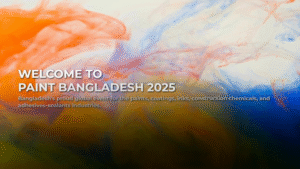
Paint Bangladesh 2025, an expo on paint industry, set to begin on September 25
Paint Bangladesh 2025, an exhibition on paint industry, is set to take place from September 25-27 this year at the International Convention City Bashundhara (ICCB), Dhaka. Organised by Rainbow Exhibition & Event Management Services Ltd., the expo is positioned as the largest and most specialized platform in South Asia for surface technology, chemical engineering, and material innovation. Paint Bangladesh 2025 is not just an exhibition; it is a technology transfer platform, the organisers said. Global leaders and local manufacturers will showcase cutting-edge solutions in: Resins, pigments, and additives engineered for higher durability, colour stability, and environmental performance. Advanced laboratory, production, and packaging equipment designed to optimise efficiency, reduce wastage, and enhance precision in coating applications. Testing and measuring instruments that ensure quality assurance and compliance with international standards. High-performance adhesives and sealants, crucial for construction, ceramics, and industrial applications where strength and longevity matter. Sustainable chemical innovations, including low-VOC (volatile organic compound) and eco-friendly formulations aligning with global green building requirements. These technologies are directly relevant for industries beyond paint, where surface coating, glaze chemistry, and bonding materials are integral to product quality. The event goes beyond exhibits. A series of seminars, technical sessions, and product demonstrations will highlight: Breakthroughs in nanotechnology for coatings. Innovations in chemical engineering for durability and performance. Market insights on Bangladesh’s rapidly expanding construction and real estate sectors. These sessions are designed to create direct dialogues between manufacturers, researchers, engineers, architects, and buyers, enabling collaboration across the entire value chain. In addition, a dedicated space called the ‘Future Paint Corner’ will facilitate the exchange of ideas on future paint systems, integrated manufacturing technologies, and innovative paint experiences of the future. Key Information Venue: International Convention City Bashundhara (ICCB), Dhaka Dates & Time: September 25 & 26 – 10 am to 7 pm September 27 – 10 am to 6:30 pm Organisers: Rainbow Exhibition & Event Management Services Ltd. and Bangladesh Paint Manufacturers’ Association (BPMA) The exhibition is open to trade and business visitors only. For the ceramic industry, this event represents an unmissable opportunity to integrate advanced coating solutions, eco-friendly materials, and high-performance adhesives into their production lines. Ceramic Bangladesh strongly encourages all stakeholders — from manufacturers to designers — to attend this landmark event and witness firsthand the future of paints, coatings, and chemicals in Bangladesh. Written by Arefin Murad
Read More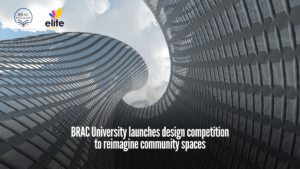
Brac University launches design competition to reimagine community spaces
Brac University’s Department of Architecture, in collaboration with Elite Paint Bangladesh Limited, has announced a student design competition titled Architecture for Unity: Redesigning Community Spaces. The initiative invites architecture students to reimagine public spaces as inclusive environments that celebrate cultural diversity and foster meaningful interaction. The competition is exclusive to students enrolled in Brac University’s Department of Architecture and aims to empower future architects to design with empathy, inclusivity, and sustainability at the forefront. Designing for Diversity and Dialogue According to the official brief, participants are tasked with redesigning a community space—either real or hypothetical—that encourages cross-cultural engagement. The goal is to transform such spaces into vibrant hubs where people from different backgrounds can connect, collaborate, and celebrate shared humanity. The design criteria are both ambitious and socially grounded. Proposals must reflect the cultural richness of the community they serve, integrating elements that honour various traditions while promoting inclusivity. Spatial flow is a key consideration, with layouts expected to guide visitors through the space in ways that encourage movement and exchange. Functional diversity is also central to the brief. The redesigned spaces should accommodate a range of activities—from social gatherings and collaborative projects to quiet reflection—allowing individuals to engage in meaningful ways. Aesthetic appeal, while not the sole focus, remains important. Organisers are looking for innovative architectural techniques and visual storytelling that inspire curiosity and wonder. Sustainability is a non-negotiable component. Students must embrace environmentally responsible design principles that minimise ecological impact, including thoughtful choices in materials, lighting, and energy use. Submission Requirements and Format Participants must submit a comprehensive design proposal that includes conceptual sketches, spatial layouts, and explanatory notes. The drawing submission must be formatted as one A0 portrait sheet in PDF, with a resolution of 300 dpi and a maximum file size of 15 MB. In addition to the visual material, students are required to submit a text document—also in PDF format—describing the idea behind the project, its inspiration, tentative outcomes, and materiality. The written component must not exceed 500 words. All submissions must be in English. File names should follow a strict format: Student’s Name_Student’s ID_Enrolled Semester (e.g., Akibur Rahman_16208023_Fall 2023). Both the drawing and the text document must be uploaded via the designated online submission link before the deadline. Key Dates and Deadlines Registration Deadline: September 1, 2025 Submission Date: October 11, 2025 (by 5.00pm) Jury Date: October 26, 2025 Results Announcement: November 10, 2025 Students can register via the official link: https://forms.gle/ecZtUpRBmVo1jC7M7 Final submissions must be uploaded to: https://forms.gle/z5zhNK88uvH5ncU49 Awards and Recognition The competition offers substantial incentives. The first prize winner will receive BDT 50,000 and a certificate. The second and third place winners will be awarded BDT 25,000 and BDT 15,000 respectively, along with certificates. However, organisers stress that the real reward lies in the opportunity to contribute to a broader conversation about architecture’s role in social cohesion. “This is an ideas competition,” said a faculty member from Brac University’s Department of Architecture. “We’re not asking students to build anything physically. Instead, we want them to think critically and creatively about how architecture can serve as a tool for unity.” Industry Collaboration and Real-World Impact Elite Paint Bangladesh Limited’s involvement adds a layer of industry relevance to the competition. Known for its commitment to sustainable and community-focused projects, the company’s collaboration with Brac University signals a shared vision for inclusive urban development. “This is not just about buildings or parks,” said a spokesperson from Elite Paint. “It’s about creating spaces where people from different backgrounds can come together, share experiences, and build a sense of unity. We believe architecture has the power to shape social behaviour, and this competition is a step towards that vision.” Student Response and Anticipation As the submission window opens, anticipation is building across the Brac University campus. For many students, this competition represents a chance to showcase their design philosophy, engage with pressing social issues, and contribute to a vision of Bangladesh where public spaces reflect the country’s rich cultural mosaic. “We often talk about unity in abstract terms,” said one third-year architecture student. “This competition challenges us to make it tangible—to design spaces where unity is not just an idea, but an experience.” Architecture as a Bridge Between Cultures With its emphasis on cultural celebration, spatial intelligence, and environmental stewardship, Architecture for Unity is more than a student competition. It is a call to action for the next generation of architects to build not just structures, but bridges—between communities, cultures, and futures. Written by Nibir Ayaan
Read MoreBangladeshi Talents Shine at Global Undergraduate Awards 2025
The Global Undergraduate Awards (GUA) 2025, the most recognised pan-disciplinary undergraduate awards programme in the world, honoured outstanding undergraduate research and innovation at its yearly award ceremony in Dublin, Ireland. The event united some of the finest students and aspiring academicians from 48 different countries who made original contributions to solving real-world problems. This year, Bangladesh achieved a remarkable milestone as Ridwan Noor Nafis won the Global Award in the architecture and design category. He won with his work, Urban Tune-Up: Architectural Packages of Block-based Rooftop Spaces as Containers of Public Life, which re-visualises the rooftops of Dhaka city as repurposed public spaces where people can meet and socialise and, more crucially, engage with the city and its urban nature. He is a graduate of BUET and was hired as one of the lead illustrators in a local newspaper during his university years—an experience that immensely impacted his design thinking. Nafis does not see architecture as a tool for converting shared stories into space but as a means to fix forms. His design philosophy draws on empathy and inclusiveness to make cities more functional and joyful. In the future, he wishes to investigate the overlap between urban design, the city, and environmental performance, and to be part of building a sustainable and socially presentable city. Bangladesh had another significant achievement in the 2025 Highly Commended segments. Out of 11 nominated individuals, 5 are from Bangladesh, nominated in the architecture and design category: 4 from the Department of Architecture, BUET, and 1 from the Department of Architecture, CUET. Jahra Jarin Jemi, a Lecturer at Shanto-Mariam University of Creative Technology, was nominated for her project, Life Between the Tides – Building Resilience for Manta Community in Transition. Nusrat Nasrin Ananna, a graduate of CUET, was nominated for her undergraduate thesis project titled “Unveiling Biodiversity: A Natural History Museum Complex for Discovering the Treasures of Bangladesh”. The project serves as an innovative and comprehensive hub for the exploration and preservation of the region’s rich biodiversity. Maisha Tasnim was nominated for her work “Beyond Shelters: Weaving Resilience, Livelihood, and Identity in Mongla, Bagerhat”. Sakib Nasir Khan, currently working as a part-time lecturer at BUET, was nominated for his work “The Transition: Adaptive Post-Disaster Shelters for Dense Urban Community Recovery”, marking his second consecutive commendation. Aniqa Ibnat was nominated for her thesis “Cyclic Home: Rethinking Roof as Floating Structure in Flood-Pronounced Bangladesh”. The Global Undergraduate Awards is a non-profit organisation in Dublin, established in 2008 and presided over by Michael D. Higgins, president of Ireland. Top undergraduate work is identified through impartial and collaborative consideration across 25 categories by international academics and industry practitioners. Today, the top 10 percent of entries are named Highly Commended, and each category also declares one paper as the Global Winner—highlighting the dynamic, diverse, and transformative nature of student research. Written by Afroza Mamtaz
Read More
Akij Ceramics Clinches Superbrands Title for Second Time
Akij Ceramics has once again been named one of Bangladesh’s most trusted and influential brands for 2025-2026 by Superbrands, the world’s largest independent arbiter of branding. The announcement was made at a glittering ceremony held at Le Meridien Dhaka, celebrating excellence across industries. This marks the second time Akij Ceramics has received the coveted Superbrands recognition, reinforcing its stature as a leader in the ceramics industry. The company, in a statement, credited the award to its unwavering commitment to innovation, quality, and consumer trust. But beyond the accolades, Akij Ceramics has quietly shaped the way Bangladesh lives. Since its founding in 2012, the brand has evolved from a tile manufacturer into a lifestyle visionary. Its collections are not just about surfaces — they’re about stories. Each design reflects a blend of global aesthetics and local sensibilities, transforming homes, offices, and public spaces into expressions of identity and aspiration. The company’s six-year streak as winner of the “Best Brand Award” from Bangladesh Brand Forum (2019-2024) speaks volumes about its consistency and consumer loyalty. Yet, it’s the brand’s philosophy — to create beauty with purpose — that truly sets it apart. Whether it’s a minimalist matte finish for a Dhaka apartment or a bold geometric pattern for a boutique hotel in Cox’s Bazar, Akij Ceramics continues to push boundaries in design, sustainability, and lifestyle integration. With this latest milestone, the brand renews its promise: to inspire, to elevate, and to remain a trusted companion in the art of living well. Written By Nibir Ayaan
Read More
Shishir Bhattacharjee Returns with Rekhachitro
With Rekhachitro/Drawing, the ongoing exhibition at the capital’s Kalakendra, the prominent artist Shishir Bhattacharjee is returning after a hiatus of more than a decade. Open to all, the exhibition will run daily from 4:00pm to 8:00pm until September 27. Shishir Bhattacharjee is a familiar name in Bangladesh’s visual arts scene. He was among the first artists to bring cartoons to the front pages of major newspapers, giving satire a fresh voice. Over the years, his works have not only entertained but also documented Bangladesh’s living history. Alongside his artistic practice, Bhattacharjee has also made his mark as a teacher, mentoring countless students at the Faculty of Fine Arts, University of Dhaka. Despite his long journey, he has often been hesitant to place his own creations at the forefront. That is why, for admirers of his work, this latest solo show is more than just an occasion—it is a celebration. His last solo exhibition, Daag-Tamasha, was held in 2013 at the Dhaka Art Center. The current exhibition features 95 line drawings created over three decades, from the early 1990s to 2023-25. The collection is uniquely Bhattacharjee: restless, fluid, and brimming with rhythmic lines. If his earlier cartoons captured the fleeting realities of society and politics with razor-sharp humour, the works here probe something deeper—mental landscapes. He employs his compositional skills to turn inner visions into imagery. The artworks adhere to the practice of automatic drawing, a method originating in Surrealism in the 1920s, where the artist allows the unconscious to direct the hand without rational control. “What I see, or perceive, emerges through my hand. It is spontaneous, often beyond conscious control. I can think and see countless things at once—perhaps science may never reach that point,” said Bhattacharjee. The pieces demonstrate his mastery of line-making. Each mark travels eagerly across the surface yet finds harmony with the others, forming an organic rhythm. To the viewer, the drawings serve as a doorway into surreal realms where the limits of reality crumble. Fish glide through the heavens, trees sprout from hands, eyes bloom like flowers, and lips open unexpectedly. Humour and uneasiness coexist in these works, expressing the contradictions of human existence. The drawings are rendered on sheets of varying colours—white, grey, and brown—each evoking a distinct atmosphere. The style is minimalist in technique yet rich in imagery, with symbols proliferating and interweaving to create pulsing compositions. Bhattacharjee’s use of local cultural motifs is particularly striking. Birds from folklore, fish from riverine traditions, floral patterns from alpana, and suns from folk art all appear in his work. These themes reflect the traditional while conversing with modern surrealism, resulting in interpretations that feel both timeless and contemporary. His compositions repeatedly feature human traits, eyes, hands, animals, and natural objects. The eye motif appears in diverse forms—sometimes vacant, sometimes erupting from other figures—signifying both surveillance and introspection. Faces, too, shift continually, whether smiling, skeletal, or fragmented, mirroring the complexities of the mind. Birds, fish, and trees merge seamlessly with human figures, reminding us that we are not separate from nature but inextricably bound to it. Alongside vitality, signs of disintegration also surface. Severed limbs, hollow eyes, and lifeless animals evoke apocalyptic undertones, suggesting war, environmental disaster, or human crisis. Yet, odd humour prevails, with grotesque movements and unsettling smiles that recall his incisive wit as a cartoonist. Though he no longer produces newspaper cartoons, sarcasm still infuses his work. Ultimately, Bhattacharjee’s art transcends mere aesthetics. His lines explore the delicate balance between humanity and nature, joy and fear, life and death. With lyrical spontaneity, symbolic richness, and surreal imagination, the ninety-five drawings in this exhibition bring dreams, nightmares, and realities into coexistence. Written by Shahbaz Nahian
Read More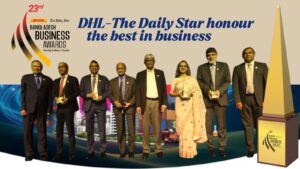
DHL–The Daily Star honour five entrepreneurs, businesses
Global logistics service provider DHL Express Bangladesh and Bangladesh’s largest-circulated English newspaper, The Daily Star, honoured five outstanding entrepreneurs and enterprises with the Bangladesh Business Awards on 23 September. The awards were given in five categories: Business Person of the Year, Best Financial Institution of the Year, Best Enterprise of the Year, Outstanding Woman in Business, and Lifetime Achievement Award. Business icon M Anis Ud Dowla, chairman of ACI Ltd, was bestowed with the Lifetime Achievement Award for his contribution to the Bangladesh economy. His story, like many others celebrated at the event, is a testament to the power of unwavering dedication. Dowla transformed an SME into ACI, one of Bangladesh’s largest conglomerates, employing more than 15,000 people. After a 27-year career in multinationals, he pioneered the local industry and continues to promote ethics, continuous learning, and youth entrepreneurship, seeing Bangladesh’s large population and rising middle class as the foundation of future growth. Ahsan Khan Chowdhury, chairman and CEO of Pran-RFL Group, was named Business Person of the Year for 2024. Under his leadership, a modest family-run agro venture grew into one of Bangladesh’s most diversified conglomerates, spanning more than 6,000 product lines and employing 167,000 people, with annual revenues exceeding $3 billion—a transformation that mirrors the country’s own economic rise. The Enterprise of the Year award went to Walton Hi-Tech Industries PLC, which has reshaped Bangladesh’s electronics market, moving from import dependence to global competitiveness. Founded in the early 2000s, Walton now produces refrigerators, televisions, and smartphones, employs thousands, exports to more than 50 countries, and symbolises the nation’s industrial diversification. City Bank was named Best Financial Institution of the Year 2024. Once considered troubled, City has emerged as one of the country’s leading lenders. Established in 1983, it now records strong asset growth, operates a vast agent banking network, runs gender-focused initiatives, and posts profits of over Tk 1,000 crore—underscoring its financial resilience and governance reforms. Sadia Haque received the Outstanding Woman in Business award for 2024. After leaving a thriving corporate career, Sadia co-founded ShareTrip, Bangladesh’s leading travel-tech startup. She turned her passion into innovation, pioneering digital booking, loyalty programmes, and fintech services. As a female founder, she champions entrepreneurship and breaks barriers in a male-dominated industry while redefining how Bangladesh travels. Finance Adviser Salehuddin Ahmed presented the awards to the winners at the Radisson Blu Water Garden Hotel in Dhaka, where Commerce Adviser Sk Bashir Uddin was also present. Congratulating the winners, Adviser Salehuddin said Bangladesh’s businesses had shown “remarkable dynamism” in expanding their reach beyond national borders. He recalled being “pleasantly surprised” to find Pran Chanachur on shop shelves as far as Fiji. “This is how Bangladesh goes far away,” he said. Ahmed called on the country’s private sector to prepare for a more competitive global environment after graduation from the Least Developed Country (LDC) bracket. “You have to be competitive, you’ll have to look at the global situation and of course the local. We definitely try to facilitate all kinds of support through policy reforms, through process simplifications and through other support instruments,” he said. “Bangladesh is on a transformation journey, and its private sector continues to be the engine of growth.” At the event, Md Miarul Haque, managing director of DHL Express Bangladesh, said Bangladesh’s private sector must evolve with agility, innovation, and collaboration to remain competitive in a fast-changing global economy. “At DHL, we are proud to celebrate the leadership that drives this progress. Tonight’s awardees are not only shaping industries but also contributing to the nation’s economic advancement and global competitiveness.” Mahfuz Anam, editor and publisher of The Daily Star, also lauded the past winners of the Bangladesh Business Awards. “These individuals represent the best of Bangladesh’s private sector—those who have built with integrity, broken barriers, and moved the nation forward.” Anam underscored that Bangladesh is nearing its graduation from LDC status, yet concerns remain about readiness. He argued that part of the answer lies in the state’s inconsistent support for the private sector. “We must distinguish between honest and dishonest businessmen,” he said. Receiving the Lifetime Achievement Award, Anis Ud Dowla said, “I am honoured and humbled by this recognition. It is truly an inspiration to strive for even greater excellence.” “This is the third time I feel honoured at this platform. In 2011 and 2017, I had the privilege of receiving awards on behalf of ACI and myself. But this Lifetime Achievement Award is profoundly moving,” he said. He ended his speech with a powerful quote: “Be punctual. Time is valuable. Not just yours, but everyone’s.” Pran-RFL Chairman and CEO Chowdhury said, “I must say, I didn’t have to do much in the beginning. It was the people behind Pran-RFL who made it happen. It’s our customers who have carried us forward.” ShareTrip CEO Haque said, “Tourism is not often seen as a key contributor to the GDP or economic growth. I hope this recognition, both for myself and for ShareTrip, marks a turning point for the industry.” Walton MD Alam called the award timely ahead of LDC graduation. He urged continued backing for local industries, saying, “Just as others say ‘Make in India’ or ‘America First’, we say: ‘Bangladesh on Top’.” City Bank CEO Arefin reflected on the bank’s transformation journey. “This was a long-anticipated recognition,” he said. “City Bank’s transformation began in 2007, from what was then considered a problem bank, with two central bank observers on its board, to now being one of the country’s leading financial institutions.” The event was attended by Sarah Cooke, British high commissioner to Bangladesh; Tapan Chowdhury, managing director of Square Pharmaceuticals; Simeen Rahman, group CEO of Transcom Group; AK Azad, chairman and CEO of Ha-Meem Group; Abdul Muktadir, chairman and managing director of Incepta Pharmaceuticals; Zaved Akhtar, president of The Foreign Investors’ Chamber of Commerce & Industry; Naser Ezaz Bijoy, CEO of Standard Chartered Bangladesh; and Syed Mohammad Kamal, country manager of Mastercard. Shaheen Anam, executive director
Read More
9th Bangladesh Buildcon International Expo Begins in Dhaka Sep 25
The stage is all set for the ninth edition of the Bangladesh Buildcon International Expo, a trade show dedicated exclusively to the building and construction industry. The three-day event, which will begin on September 25 at Dhaka’s International Convention City Bashundhara (ICCB), will integrate the construction industry into a professional meeting, investment, and dissemination of ideas and information. The Buildcon Expo, launched in 2015, has continuously emerged as one of the most anticipated business events in the construction sector. It has, over the years, become a complete hub of industry meeting points by attracting architects, builders, contractors, engineers, manufacturers, fabricators, interior decorators, importers, dealers, distributors, traders, and government departments. Expected to attract more than 5,000 trade visitors, the event has drawn a wide range of people who are keen on learning about new developments in the industry. With over 200 esteemed exhibitors across an area of more than 1,500 square feet, the expo offers a great opportunity for individuals to network, share ideas, and broker business. Organised by The Buildcon Expo 2025 is organised by Futurex Trade Fair and Events Pvt. Ltd. and ASK Trade & Exhibitions Pvt. Ltd. Futurex Trade Fair and Events Pvt. Ltd. aims to provide an ideal business platform through exhibitions, seminars, corporate events, and get-togethers. ASK Trade & Exhibitions Pvt. Ltd., which is based in Chennai, Bangalore, Kolkata, and Delhi in India, also has branches in countries such as Brazil, China, and Bangladesh. International and Domestic Participation Both international companies as well as domestic exhibitors will be present at the expo. The organisers ensure that leading firms in the construction sector—specialised in machinery, equipment, and vehicles; mechanical, electrical, and plumbing services; interiors and finishes; building tools and materials; dedicated construction technologies; and special construction solutions—will be present on the exhibition floor. The visitor profile is equally diversified, including but not limited to architects, designers, builders, contractors, engineers, project managers, government officials, investors, real estate developers, hoteliers, and sourcing professionals. Authorities from airports, seaports, retail malls, and amusement parks, as well as facility managers, industry associations, and consultants, will also participate, ensuring a good cross-sectional representation. Industry Outlook The present valuation of the Bangladesh construction industry at Tk 2,329 billion is expected to increase at a compound annual growth rate of 10 percent up to 2026, when the industry is projected to be worth Tk 3,415.1 billion. Such growth, owing to rapid urbanisation in Dhaka and other urban regions, highlights the future of Buildcon 2025 as an investment and networking hub, besides being a platform for knowledge sharing. The organisers emphasised that the Bangladesh Buildcon International Expo 2025 is meant to be seen and felt: more than the works on exhibit at the fair, it is a forum of partnership where Bangladesh emerges as the most relevant centre in the building and infrastructure sector in South Asia. Written by Afroza Mamtaz
Read More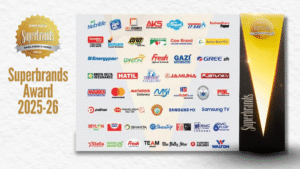
49 Brands Earn Superbrands Status for 2025-26
A Night of Prestige On the evening of September 20, 2025, Dhaka’s Le Meridien hotel became the epicentre of brand celebration. Superbrands Bangladesh hosted a gala to honour 49 companies that have earned the coveted Superbrands status for 2025–26. Bangladesh’s Most Trusted Brands The event brought together Bangladesh’s top corporate minds—executives, marketers, and brand custodians—who gathered to applaud the country’s most trusted and influential names. It was a night of recognition, prestige, and storytelling. Unveiling the Fifth Superbrands Volume A key moment of the evening was the unveiling of the cover for the upcoming Superbrands Bangladesh publication. This edition will profile the selected brands and serve as a reference for professionals in marketing, media, academia, and advertising. Global Legacy of Superbrands Superbrands began in the UK in 1994 and has grown into the world’s largest independent arbiter of branding. Its mission is to spotlight brands that offer both emotional and functional advantages over competitors. What Defines a Superbrand To be named a Superbrand is to be recognised for excellence, reliability, and consumer trust. These brands don’t just sell—they inspire loyalty and command premium value through their reputation. Rigorous Selection and Evaluation The selection process in Bangladesh was rigorous. A multidisciplinary Brand Council evaluated each contender across five key metrics: brand heritage, relevance, perceived quality, performance, and top-of-mind awareness. Each brand was scored out of 20. Only those with the highest marks and full compliance were invited to join the Superbrands list. The process ensures that only the most consistent and credible brands are recognised. Insights from the Brand Council Ashraf Bin Taj, managing director of International Distributions Company Bangladesh, elaborated on the jury’s approach. He emphasised that Bangladesh’s evaluation mirrors the global standards upheld by Superbrands worldwide. He noted that only brands demonstrating sustained relevance and trustworthiness make the cut. The multi-stage process filters out anything less than exceptional. Shariful Islam, managing director of Superbrands Bangladesh, addressed the gathering with a message of pride. He described Superbrands as names that people trust, respect, and feel proud to associate with. He added that these brands stand apart by honouring their values and promises. Their ability to inspire confidence and set industry benchmarks makes them worthy of celebration. Global Reach and Local Impact Globally, Superbrands has recognised over 45,000 brands across 90 countries. More than 645 publications have documented the journeys of these leading names since the programme’s inception. In Bangladesh, the fifth volume of Superbrands continues this legacy. It highlights brands that go beyond competition to represent quality, trust, and distinction in the marketplace. Meet the 2025-26 Superbrands The 49 honoured brands span industries from consumer goods and electronics to education and media. Each has carved a unique identity in the Bangladeshi landscape. Among the winners are ACI Nutrilife, Akij Ceramics, Bashundhara LP Gas, Berger Paints, BRB Cable, Channel i, and Eastern Bank PLC. These names are synonymous with reliability and innovation. Others include Energypac, Epyllion Group, Gree Air Conditioner, Hatil Furniture, Igloo Ice Cream, Jamuna TV, Mastercard, Matador Stationery, and Meghna Group of Industries. Tech and education leaders like North South University, Pathao, Samsung Mobile, and Walton were also recognised. Their impact on modern Bangladesh is both deep and wide. Retail and FMCG giants such as Shwapno, PRAN-RFL Group, Rupchanda, and SMC Condoms earned their place through consistent performance and consumer trust. The full list also features Turkish Airlines, The Daily Star, Shah Cement, Shanta Holdings, and ShareTrip. These brands reflect the diversity and dynamism of Bangladesh’s corporate ecosystem. Each brand profiled in the Superbrands publication represents a journey of excellence. Their recognition sets a benchmark for others aspiring to similar heights. Wtitten by Nibir Nahiyan
Read More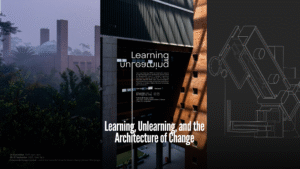
Learning, Unlearning, and the Architecture of Change
In a world where design often races ahead of reflection, CubeInside Design Ltd. is inviting architects, students, and thinkers to pause—and reconsider. Their upcoming three-day event, Learning & Unlearning, promises not just a series of lectures but a journey into the core of architectural consciousness. Set to unfold from September 25 to 27, the event will be hosted at CubeInside Design Ltd. in Dhaka. It’s not a typical seminar. It’s an exploration—into the craft, the culture, and the contradictions of architecture today. CubeInside, known for its thoughtful design practice, has curated this event with a clear intention: to challenge assumptions, provoke dialogue, and open up new ways of seeing. The title itself—Learning & Unlearning—signals a dual movement. It’s about acquiring knowledge, yes, but also about shedding the habits and biases that no longer serve. The programme is structured around lectures, discussions, and exhibitions, each designed to engage participants in critical reflection. Over three days, attendees will encounter ideas that stretch beyond blueprints and facades. They’ll be asked to consider architecture not just as a profession but as a cultural act—one that shapes and is shaped by society. The event is open to students, professionals, and enthusiasts alike. It’s a rare opportunity to engage with architectural discourse in a setting that encourages both curiosity and critique. CubeInside’s invitation is clear: come with questions, leave with more. CubeInside’s announcement, shared via its official Facebook page, carries a tone of quiet urgency. “CubeInside invites you to Learning & Unlearning,” it reads. The event’s visual identity, as seen in the post, is minimal yet evocative. It reflects CubeInside’s design ethos: clarity, restraint, and meaning. There’s no excess—just an invitation to think. What makes Learning & Unlearning stand out is its refusal to be didactic. It doesn’t claim to have answers. Instead, it offers a space where answers can be questioned. In a field often dominated by trends and technicalities, this is a refreshing shift. CubeInside’s initiative is timely. As Bangladesh grapples with rapid urbanisation, climate challenges, and shifting cultural landscapes, architecture must evolve. Events like this help ensure that evolution is thoughtful, inclusive, and grounded. For those attending, the three days will likely be more than an academic exercise. They’ll be a chance to connect—with ideas, with peers, and with the deeper purpose of design. And for CubeInside, it’s another step in its ongoing commitment to architecture that matters. In the end, Learning & Unlearning is not just about buildings. It’s about building understanding. And in that, CubeInside is offering something rare: a space to think, together. Written by Nibir Ayaan
Read More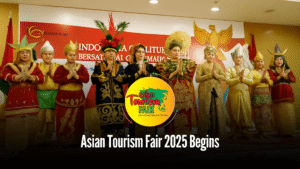
Asian Tourism Fair begins in Dhaka today
The 12th Asian Tourism Fair (ATF) officially commenced today at the International Convention City Bashundhara (ICCB), marking the largest tourism exhibition ever held in Bangladesh. The three-day event, running from September 18 to 20, features over 200 exhibitors from 20 countries. The ATF Dhaka is organised by Bangladeshi travel and tourism magazine The Parjatan Bichitra. The event is endorsed by Ministry of Civil Aviation and Tourism and government of Bangladesh, and supported by Bangladesh Parjatan Corporation (BPC), Bangladesh Tourism Board (BTB) and tourism trade association at home and abroad. This year’s expo’s tagline “Connecting Regional Tourism,” aims to strengthen cross-border collaboration and promote sustainable travel across Asia. Countries which took part in earlier editions of the fair include: Bangladesh, India, Nepal, Bhutan, Thailand, Malaysia, Sri Lanka, Indonesia, China, Korea, Sri Lanka, Japan, Jordan, Iran, Qatar, Philippine, Singapore, Lithuania and Maldives. Malaysia returns as a feature country, showcasing its tourism offerings through immersive displays. Mutual Trust Bank is the title sponsor of the fair, where national tourism organisations, airlines, tour operators, and hospitality groups will be the key exhibitors. Bangladesh’s tourism sector is prominently represented, with local operators promoting destinations such as the Sundarbans mangrove forest, Cox’s Bazar—the world’s longest sea beach—tea gardens in Sylhet, and Buddhist heritage sites in the Chittagong Hill Tracts. Bangladesh was recently named one of the best-value destinations by Lonely Planet, and organizers are leveraging this recognition to boost inbound and outbound travel. The fair includes a series of side events designed to engage both industry professionals and the general public. These include seminars, workshops, skill conventions, cultural programmes, and a dedicated Bangladesh Tourism Night. An award ceremony is scheduled to recognise contributions to the tourism sector. Four tiers are offered: Standard, Semi Pavilion, Pavilion, and Prime Pavilion. Logistical support is available only through nominated agents and for exhibitors with early bird registration. The event also facilitates B2B and B2C networking sessions to encourage commercial partnerships and tourism development. Visitor demographics span leisure travellers, corporate buyers, travel media, and academic researchers. Organisers expect significant footfall over the three days, with the ICCB venue prepared to accommodate large crowds. Bangladesh’s outbound tourism market is expanding rapidly, driven by increased flight connectivity and a growing middle class. The fair aims to capitalise on this trend by promoting regional travel packages and enhancing visibility for participating destinations. The ATF has been held regularly since its inception, with some exceptions. It is considered a key platform for regional tourism stakeholders to exchange ideas, showcase products, and foster economic cooperation. The fair will conclude on September 20 with closing remarks from organisers and government representatives. Written by Nibir Ayaan
Read More
South Asia Trade Fair 2025 Kicks Off in Dhaka Today
The South Asia Trade Fair 2025 opens its doors in Dhaka today, drawing together businesses from across the region for a four-day showcase of trade and commerce. This year’s edition will feature an extensive display of products from South Asian countries, covering categories as diverse as readymade garments, textiles, gems and jewellery, cosmetics, footwear and leather items, home and kitchen appliances, processed food, and electronics. Organisers said the wide range is meant to highlight both the industrial strengths and the cultural traditions of the region. Over a hundred companies are expected to take part, representing a strong presence of entrepreneurs and firms from multiple SAARC member nations. Their participation is aimed at deepening economic ties and opening new trade opportunities among neighbouring countries. The fair is being hosted under the initiative of the SAARC Chamber of Commerce and Industry (SCCI). The Federation of Bangladesh Chambers of Commerce and Industry (FBCCI), the Ministry of Commerce, and the Export Promotion Bureau (EPB) are providing support to make the event successful. An inaugural ceremony marked the start of the fair and Commerce Adviser Sk. Bashir Uddin formally opened the exhibition at the International Convention City, Bashundhara. The event is being positioned as one of the year’s most important trade gatherings in the capital. Details of the programme were shared earlier this week at a press conference organised at the FBCCI headquarters in Dhaka’s Motijheel. Speaking at the briefing, Zulfiqar Ali Bhatt, secretary general of the SAARC Chamber of Commerce and Industry, explained the scope of the upcoming fair and outlined its objectives. According to Bhatt, the event will include business-to-business matchmaking sessions and dedicated networking opportunities designed to foster trust between entrepreneurs of SAARC nations. He added that the platform would also enable the exchange of ideas and experiences in business practices, paving the way for a stronger foundation of regional cooperation. “This will play a vital role in promoting regional trade,” Bhatt remarked, underlining the importance of strengthening intra-regional links. He noted, however, that despite significant potential, South Asian economies have not yet managed to expand their trade with each other to the levels seen in other parts of the world. The fair, he stressed, can serve as a step toward correcting this imbalance. The exhibition will bring together companies from Bangladesh, Pakistan, Sri Lanka, and Afghanistan, among others. With more than a hundred firms participating, organisers are confident the event will serve as an effective platform for businesses looking to establish or expand their footprint in South Asia’s growing markets. Md. Alamgir, secretary general of FBCCI, also spoke at the press conference, focusing on the broader vision of the Saarc Chamber. He emphasised that the institution was created to boost the region’s trade capacity and to promote collaboration across a variety of sectors. Through the fair, Alamgir said, regional potential in industries such as textiles, pharmaceuticals, processed food and agriculture, and electronics will come to the forefront. At the same time, the exhibition will not only highlight economic strengths but also showcase the rich traditions and cultural identities of the SAARC member countries, creating a more holistic view of South Asia’s shared possibilities. The stakeholders hope the four-day event will set the stage for stronger commercial ties, a more connected region, and a renewed commitment to expanding trade among neighbouring economies. Written by Nibir Ayaan
Read More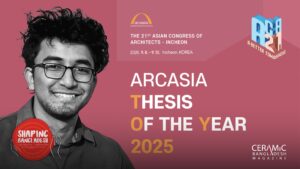
Ridwan Noor Nafis Wins Gold at TOY ARCASIA 2025
BUET graduate bags Asia’s top architecture award In a defining moment for Bangladesh’s architectural community, Ridwan Noor Nafis—a recent graduate of Bangladesh University of Engineering and Technology (BUET)—has been awarded the Gold Prize at “Thesis of the Year” (TOY ARCASIA 2025), one of Asia’s most prestigious platforms for emerging architects. Held in Incheon, South Korea, the competition drew submissions from leading architecture schools across the continent. Nafis’s winning thesis, “Urban Tune-Up: Architectural Packages for Block-Based Rooftop Spaces as Containers of Public Life”, offers a bold reimagining of Dhaka’s skyline. His vision transforms the city’s fragmented rooftop spaces into vibrant, interconnected zones of public engagement—integrating green infrastructure, social interaction, and urban resilience into the heart of one of Asia’s densest capitals. Guided by supervisors Dr Khandaker Shabbir Ahmed and Maherul Kader Prince, Nafis’s work stood out among submissions from top architecture schools across Asia. His proposal offers a visionary response to Dhaka’s spatial constraints and social fragmentation, positioning rooftops as platforms for civic life—breathing space in a city that often feels choked by its own growth. TOY ARCASIA, one of Asia’s most respected platforms for architectural students, celebrates innovation, social relevance, and global orientation. The objective of TOY 2025 is to provide an arena for architecture schools in ARCASIA member countries and their undergraduate students to showcase fresh ideas and academic potential on an international stage. It aims to elevate architectural education across Asia by fostering creativity and cross-cultural exchange. This year’s entries were held to a rigorous standard. Submissions were required to demonstrate high social relevance, originality, and a strong global outlook. A key criterion was alignment with the United Nations’ 17 Sustainable Development Goals—or their future roadmap—ensuring that each thesis contributed meaningfully to global challenges. Nafis’s project met these demands with clarity and conviction, offering a model for sustainable urban transformation rooted in community and ecological awareness. Now a lecturer at BUET, Nafis’s achievement is more than personal—it is emblematic of BUET’s growing influence in architectural thought and research across the region. His win reinforces the university’s reputation for producing graduates who combine academic rigour with visionary thinking. TOY ARCASIA’s mission is to elevate architectural education in Asia by showcasing final-year student work that pushes boundaries and opens pathways for knowledge exchange. In a world where cities are rapidly evolving, Nafis’s rooftop revolution reminds us that innovation does not always require new land—it can begin above our heads. His work is a call to rethink the spaces we overlook, and to design with both imagination and empathy. Written by Nibir Ayaan
Read More
The Quiet Majesty of Sultan: Through the Eyes of Nasir Ali Mamun
For a long time, Nasir Ali Mamun, who slowly catapulted portrait photography in Bangladesh, photographed S. M. Sultan, one of the finest artistic minds from this soil. To honor the centennial of the legendary S. M. Sultan (1924-1994), the Bengal Foundation, in collaboration with HSBC Bangladesh, presents “Shotoborshe Sultan,” a unique photographic exhibition by Nasir Ali Mamun. The exhibition began on Friday, August 22, 2025, at 6:00 PM, in the Quamrul Hassan show hall, Bengal Shilpalay, Dhaka, and would run every day (excluding Sundays) from 4:00 to 8:00 PM till September 27, 2025. The show features rare images of S. M. Sultan by Mamun, as well as original negatives, handwritten letters, and souvenirs, many of which are being displayed for the first time in public, presenting an intimate visual journey from Sultan’s rural home in Narail until his latter years. Portraits of artists are merely portraits of individuals; they are also historical landscapes. What Mamun began decades ago as a photographic testament to a single person is now unfolding as part of a centennial constellation in which Sultan’s photographs, letters, and pieces of existence are made visible again. Sultan’s paintings are counter-historical. He gave peasants colossal stature, men and women with torsos whose muscles bore the silt of millennia. In his works, the agrarian body is not a scenic or colonial decoration, but rather the reality of subsistence. It is a subaltern vision turned myth: peasants are the measure of Bangladesh itself. Seeing them on his painting reminds us that history belongs not only to the financially privileged class but also to people who tilled, carried, and endured. But what does it mean to shoot the man who immortalized others and created counter-histories? The answer, I believe, is to reintegrate him into the life-world he exalted. This is exactly what Mamun did. His black-and-white photographs of Sultan do not elevate him to the artist’s abstract figure status. They instill in him the texture of daily austerity. Beyond the artist at work, the studio, and the brush, there are subtleties that encompass Sultan sitting on a mat in a broken zamindar’s house (where he lived), painting in the light that spills in through an open door, eating with cats as companions, bent under the weak flame of a hurricane lamp, the shadow of a child at the door, the cat staring as he eats, and the cracked floor that bears his weight. These elements make it impossible for Sultan to be just classified as an eccentric artist. Thus, Mamun’s photographs of Sultan are not just photographic intrusions into his private life. They reject glamor. They reject transforming Sultan into a star divorced from the reality he lived in. Instead, they depict him in frail light, in humble space, and in the rhythms of daily life, and much would have been lost if these images had not existed. Without Mamun, Sultan would only exist as a myth, with his huge peasants in museums and his name perpetuated in art history. But the eccentric man himself would vanish into rumor. These pictures resist the erasing. They claim the artist was here. Written by Shahbaz Nahian
Read More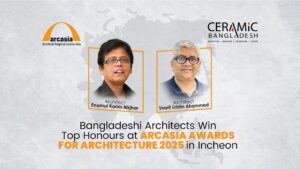
Bangladesh’s Double Honour at ARCASIA 2025
Enamul Karim and Sharif Uddin Ahammed Redefine Regional Architecture In a week that celebrated architectural ingenuity across Asia, two Bangladeshi architects—Enamul Karim and Sharif Uddin Ahammed—stood out among more than 300 submissions at the ARCASIA Awards for Architecture 2025, held in Incheon from September 7 to 14. Their winning projects, though vastly different in scale and typology, share a common ethos: architecture as a medium of emotional depth and social responsibility. Karim was awarded the Gold in Category A1 for CHAABI, a single-family residence that transforms domestic space into a poetic landscape of memory and light. Ahammed, meanwhile, received the Special Award for Socially Responsible Architecture for From Industrial Wasteland to Ecological Oasis Bangladesh, a low-budget landscape intervention that reclaims degraded land for biodiversity and community equity. Their recognition marks a significant moment for Bangladeshi architecture, where personal narrative and civic consciousness are increasingly shaping the built environment. A House That Remembers: Enamul Karim’s CHAABI Located in Berabo, Rupganj, near the river Shitalakha, CHAABI is more than a residence—it is a spatial memoir. Completed in 2023, the 1,035-square-metre home was designed for a family seeking peace, introspection, and connection to nature. Karim’s design orchestrates a series of transitions: from enclosed rooms to open courtyards, from filtered daylight to open skies, from private memory to shared experience. The house features a water body that runs alongside the living room, open to the south wind and sky. A narrow walkway along its edge leads to a large open field, evoking a sense of spatial release. Inside, the programme includes bedrooms, a home theatre, gymnasium, swimming pool, and a unique “address-desk”—a raised wooden platform with microphones for family speeches. Material choices are deliberate: exposed concrete for structure, mahogany for doors and windows, matte tiles for floors, and grill-less glass for uninterrupted light. Memory traps embedded in the ground hold family memorabilia, turning the home into a quiet archive of generational love. Karim’s CHAABI was praised by the jury—led by ARCASIA President Ar. Saifuddin Ahmad—for its emotional clarity and architectural restraint, a rare balance in residential design. A Landscape of Equity: Sharif Uddin Ahammed’s Ecological Oasis In contrast to the intimacy of CHAABI, Sharif Uddin Ahammed’s award-winning project operates at the scale of landscape and labour. From Industrial Wasteland to Ecological Oasis Bangladesh reclaims a neglected site through passive hydrological solutions, wildlife habitat creation, and democratic spatial planning. Developed between 2022 and 2023, the project challenges conventional landscape design by addressing class divisions between corporate officials and labourers. Using existing materials and a minimal budget, Ahammed and his team at Sthapotik crafted a space that serves both ecological and human needs. The jury, which also included Prof. Ken Nah, Ar. Shahid Abdulla, Ar. Anna Kwong, and Ar. Beverly Frank, recognised the project’s layered complexity and its commitment to environmental justice. Convened by Ar. Chun Gyu Shin, the panel awarded Ahammed the Special Award for Socially Responsible Architecture on 10 September. For Ahammed, the recognition affirms a long-held belief: that architecture must respond to its environment—not just physically, but socially and emotionally. His practice, rooted in the philosophy of “responsive environments,” continues to challenge the boundaries of what architecture can do. A Shared Stage, Divergent Legacies Though Karim and Ahammed work in different registers—one in the quiet intimacy of home, the other in the public urgency of landscape—their projects converge in their refusal to treat architecture as mere form. Instead, they offer it as a language of care, memory, and justice. Their dual recognition at ARCASIA 2025 is not just a win for Bangladesh—it is a signal that architecture in the region is evolving, embracing both the personal and the political, the poetic and the pragmatic. Written by Afroza Mamataz
Read More
Dhara: A New Bi-Monthly Talk Series for Architectural Dialogue
Dhara aims to create a platform where alumni, students, and practising architects can share knowledge The Department of Architecture at Ahsanullah University of Science and Technology (AUST) launched its new bi-monthly talk series, Dhara, organised in collaboration with the Alumni of AUST Architects, on August 26 this year. The inaugural session, held at the Jury and Exhibition Space of the department, began with a lecture by Swiss architect Niklaus Graber. Dhara aims to create a platform where alumni, students, and practising architects can share knowledge, ideas, and experiences. By opening up discussions on contemporary architectural practice, the series seeks to broaden perspectives, foster collaboration, and strengthen the link between academia and the profession. As its tagline suggests, Dhara is envisioned as a place “where ideas flow, and architecture speaks”. Niklaus Graber delivered the opening lecture under the title “Enabling Structures: Reflections between Rivers and Mountains”. Drawing on his practice in Switzerland and his long-standing engagement with Bangladesh, Graber spoke about the relationship between architecture and structure, and how this connection shapes meaningful spaces. He reflected on the contrasts between the landscapes of Bangladesh and Switzerland, while also noting their similarities: in both countries, distinctive geographical conditions have influenced settlement patterns and fostered a shared awareness of caring for scarce resources. For Graber, sustainable and inclusive architecture is most successful when rooted in “enabling structures” that form welcoming environments and encourage vibrant social interaction. Niklaus Graber studied architecture at ETH Zurich and at the Graduate School of Architecture, Planning and Preservation (GSAPP), Columbia University, New York. The event at AUST began with a welcome address by Architect Shafiul Azam Shamim, General Secretary of the Alumni of AUST Architects. AUST Vice-Chancellor, Professor Dr Md Ashraful Hoque, attended the occasion, along with faculty members, alumni, and students. Following Graber’s engaging presentation, the vice-chancellor expressed his gratitude and presented him with a crest. Reflecting on the event, Asif Salman, an architectural designer and photographer, explained: “This workshop will be held every two months to generate in-depth ideas and get students more involved, as Niklaus Graber suggested that architecture needs to be less romanticised and more focused on safety and security.” He also stressed that the way architecture is perceived must evolve: “Sustainability must be the focus. Architecture has changed from the 20th century to the 21st century, and it will keep changing. The focus of this workshop is to bring new spokespersons, bring architects together, and start a discourse.” With such a vision, Dhara aspires to continue as a living platform where architectural ideas flow freely and dialogue between generations of architects enriches new visions. Written by Tanisha Kabir
Read More
Marina Tabassum Wins Prestigious ‘Aga Khan Award for Architecture’—Again
Marina Tabassum, one of South Asia’s most distinguished architects, has once again earned global recognition by winning the 2025 Aga Khan Award for Architecture. This marks her second time receiving the honour, a rare achievement that places her among an elite group of architects celebrated for their contributions to socially impactful design. Tabassum’s winning project, Khudi Bari—meaning “tiny house” in Bengali—is a modular, portable shelter designed for communities displaced by river erosion and climate-related disasters in Bangladesh. Constructed from bamboo and metal joints, the structure is lightweight, affordable, and easy to assemble. Each unit costs less than $300, making it accessible to low-income families living in flood-prone regions. The design reflects a deep understanding of local materials and environmental challenges, offering a dignified solution to one of the country’s most pressing humanitarian issues. The Aga Khan Award for Architecture, established in 1977 by His Highness the Aga Khan, is one of the most prestigious honours in the field. It is awarded every three years to projects that not only demonstrate architectural excellence but also improve the quality of life in Muslim societies. The award carries a total prize of $1 million, distributed among selected winners. This year’s winners include projects from China, Egypt, Pakistan, Palestine, and two from Iran, each chosen for their cultural relevance, sustainability, and social impact. Tabassum’s Khudi Bari stood out for its simplicity and transformative potential. The project was praised by the award jury for embodying architecture that uplifts and empowers, especially in the face of climate displacement. It offers a scalable model for humanitarian housing, rooted in empathy and resilience. This is not Tabassum’s first time in the spotlight. She previously won the Aga Khan Award in 2016 for the Bait ur Rouf Mosque in Dhaka, a minimalist structure that redefined religious architecture through its use of natural light and brickwork. Located in a low-income neighborhood, the mosque was celebrated for its spiritual ambience and community-centred design. That recognition marked the rise of a Bangladeshi voice of global significance, and her latest achievement further strengthens that legacy. Among those who celebrated her achievement was Nobel Laureate Professor Muhammad Yunus, Chief Adviser to the Government of Bangladesh. In a public statement, Yunus expressed heartfelt congratulations, calling the award “a source of great pride for Bangladesh.” The chief adviser commended Tabassum’s work on Khudi Bari as “brilliantly demonstrating how architecture can serve humanity with compassion and vision.” He emphasised that her design goes beyond aesthetics, highlighting dignity, resilience, and the power of human ingenuity to address the greatest challenges of our time. Yunus also reflected on her earlier triumph with the Bait ur Rouf Mosque, describing it as “a milestone that celebrated the timeless values of spirituality, community, and simplicity in architecture”. He acknowledged Tabassum’s ongoing service to the nation, including her role as Chairperson of the Bangladesh National Museum Governing Council and her consultancy on the July Uprising Memorial Museum. A photograph accompanying the message shows Professor Yunus speaking with Tabassum during a recent visit to the July Uprising Memorial Museum in Dhaka this year—a moment that underscores her continued engagement with projects of national significance. Through Khudi Bari, Tabassum has once again placed Bangladesh on the global stage of creativity and social innovation. Her work transforms adversity into opportunity, offering hope and practical solutions to those most affected by climate change. With two Aga Khan Awards and a growing portfolio of socially driven projects, Marina Tabassum continues to redefine architecture—not just in Bangladesh, but globally—as a force for equity, resilience, and human dignity. Written by Nibir Ayaan
Read More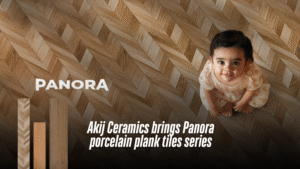
Experience the Art of Perfect Flooring
Akij Ceramics has introduced the Panora series—a stunning collection of porcelain plank tiles designed for both residential and commercial environments. Panora offers streamlined proportions suited to contemporary interiors, with three sleek sizes: 20 × 80 cm, 20 × 120 cm, and 30 × 120 cm. These tiles feature designs influenced by the textures and elegance of natural wood and incorporate an anti-slip surface achieved through advanced Micro CID technology. The subtle porcelain matte finish adds refined elegance, making them ideal for living areas, bedrooms, lobbies, kitchens, and exterior spaces. Panora’s design ensures visual harmony, complementing modern décor and architectural elements with clean, linear patterns. Beyond their refined appearance and quality, Panora tiles offer remarkable design flexibility. The sleek tiles can be arranged in a variety of captivating layouts, including: Offset (Brick Pattern): Rows of plank tiles are laid parallel but slightly staggered, creating a brick-like rhythm across the floor. Herringbone: Tiles are laid at 45° angles in a zigzag pattern, creating dynamic visual movement. Double Herringbone: An enhanced version of herringbone, where tiles are arranged in two-by-two blocks, offering a bold, textured effect. Chevron: Tiles are cut at an angle to form continuous V-shaped patterns, giving a sleek, modern appeal. This versatility allows homeowners and designers to create unique flooring designs or feature areas that reflect individual style and creativity. Whether used for expansive floors or detailed accent areas, Panora stands out as a perfect fusion of function and artistry, transforming interiors into spaces that reflect both modern elegance and thoughtful design. With Panora, Akij Ceramics delivers porcelain plank tiles that combine versatility, sophistication, and contemporary style, making them a compelling choice for a variety of settings.
Read More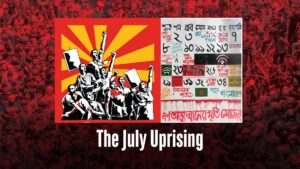
A Litmus Test for Bangladesh Economy
It began with a verdict. Not a speech, not a scandal—just a quiet ruling from Bangladesh’s judiciary. On June 5, 2024, the High Court reinstated a quota system for government jobs, reserving 56 percent of positions for specific groups, including descendants of freedom fighters. For many students, it felt like a door slamming shut. Within days, campuses across the country stirred with frustration. The movement that followed—Students Against Discrimination—was born not in fury, but in resolve. Their rallies were orderly, their chants measured. But beneath the surface, tension simmered. By early July, that tension boiled over. The protests evolved into the “Bangla Blockade,” a sweeping shutdown of roads and highways that paralysed the nation’s arteries. Buses vanished. Containers stacked up at ports. Supply trucks idled outside factories. Dhaka’s markets emptied as perishables spoiled in the heat. Exporters missed deadlines. Small traders watched their earnings evaporate. What began as a student movement had metastasized into an economic crisis. DEFINING MOMENTS June 5 | 2024 High Court reinstates quotas June 7-15 | 2024 Students begin peaceful rally, social media activism July 01 | 2024 Nationwide Bangla Blockade begins July 16 | 2024 Violent crackdown, leaving dozens killed Late July | 2024 FDI approvals drop 40%; export delays, gas shortages August 5 | 2024 Interim Government formed Sep–Dec | 2024 Interest hits 10%; ADP spending 49-year low Jan–Mar | 2025 Remittances peak; inflation eases; current account surplus Apr–Jul | 2025 Recovery phase: DSEX up 12.5%; exports rebound; MFS grows 64% August 5 | 2025 One-Year Anniversary A Nation on Edge On July 16 of 2024, the calm shattered. Security forces moved in with batons, tear gas, and live ammunition. The clashes were brutal. Ambulances raced through smoke-filled streets. Students lay bloodied on stretchers. Families camped outside police stations, desperate for news. Independent monitors reported hundreds injured and dozens dead. The government disputed the numbers. But the images—broadcast across television screens and social media—left little room for doubt. The shockwaves were immediate. Investor confidence collapsed. The Dhaka Stock Exchange saw its sharpest single-day drop in five years. Foreign direct investment approvals fell nearly 40 percent in the second half of 2024, according to the Dhaka Chamber of Commerce and Industry. The city, once buzzing with commerce, fell into a hush. Three weeks later on August 5, an interim government was announced, led by Nobel laureate Muhammad Yunus along with a panel of technocrats and civil society leaders. Their mandate: restore stability, rebuild trust, and prevent further economic unraveling. The Economic Aftershocks The July Uprising, as it came to be known, left no sector untouched. While the garment and ceramic sectors bore the immediate brunt, the ripple effects extended far wider. The banking system, already strained by years of financial irregularities, teetered on collapse. A post-uprising asset quality review revealed widespread non-performing loans and misappropriated funds, prompting the interim government to initiate recovery drives and liquidity injections. The Bangladesh Bank raised the policy rate to 10 percent to tame inflation and stabilise the exchange rate. Net foreign direct investment (FDI) dropped to a five-year low in 2024, as global investors cited political instability and opaque regulatory frameworks. The World Bank flagged Bangladesh’s deteriorating investment climate, while local chambers warned that the budget lacked a clear roadmap for restoring investor confidence. The energy sector faced dual shocks: gas shortages crippled industrial output, while privatisation efforts triggered an 18 percent hike in urban electricity tariffs, sparking fresh protests. The mental health toll was staggering. A Bangladesh Medical University seminar revealed that 82.5% of injured protesters suffered from depression, and 64% showed signs of post-traumatic stress disorder, underscoring the long-term human cost of the crisis. In the ceramic industry, 70 factories struggled to stay afloat. The Bangladesh Ceramic Manufacturers and Exporters Association (BCMEA) reported that gas pressure—critical for kiln operations—dropped to as low as 2 PSI in some zones, far below the required 15. Production stalled. Costs soared. Their demands were precise: uninterrupted gas supply, priority allocation, compressor permissions, a five-year tariff freeze, and duty-free solar imports. None were met. The garment sector fared no better. The Bangladesh Garment Manufacturers and Exporters Association (BGMEA) confirmed shipment delays averaging two weeks during the unrest. Export Promotion Bureau (EPB) data showed a 7.8% decline in garment exports in Q3 of 2024. Buyers in Europe and North America have shifted orders to Vietnam and India. Smaller exporters faced penalties and lost contracts, according to the Bangladesh Knitwear Manufacturers and Exporters Association (BKMEA). The Foreign Investors’ Chamber of Commerce and Industry (FICCI) called for stronger rule of law, faster customs clearance, and smoother approvals. The Bangladesh Chamber of Industries (BCI) highlighted the plight of agro-processors, many of whom faced wastage and layoffs. Their appeal: concessional loans and tax relief. Even real estate, long seen as a safe haven, stumbled. The Real Estate and Housing Association of Bangladesh (REHAB) reported a sharp drop in property transactions, citing high registration fees, interest rates, and uncertainty over the Detailed Area Plan (DAP) revisions. Across industries, the message converged: without urgent reform, Bangladesh’s hard-earned gains risked slipping away. The Numbers Behind the Crisis The numbers told a sobering story. By late 2024, exports faltered, imports shrank, and growth slowed to its weakest pace in years. The disruptions that began with student protests soon seeped into every corner of the economy, from factories to food markets. Inflation surged through the summer, eroding wages and squeezing households already under strain. Though the pace of price rises eased the following year, the scars remained. Construction sites went quiet, housing demand collapsed, and long-promised infrastructure projects were postponed. The slowdown was no longer abstract—it showed in half-finished bridges and shuttered shops. Private investment also lost its footing. Business registrations dwindled, banks groaned under bad loans, and confidence withered. Even as revenue collection improved, it could not
Read More
The Spatial Journey of Architect Naimul Ahsan
Architecture begins with a dream, but its true value lies in design—making buildings easy to construct, comfortable to inhabit, and meaningful for those who live in them. This is the guiding principle of Naimul Ahsan Khan, founder of Spatial Architects, who spoke about his philosophy on a calm evening in his studio. For Khan, architecture exists for the people. Simplicity is not just aesthetic but ethical—a way to make spaces accessible, functional, and enduring. His career, marked by both imagination and pragmatism, reflects this belief. After graduating from BUET in 2006, Khan began his professional journey at VITTI Sthapati Brinda Ltd., while teaching at the University of Asia Pacific, later joining S. Islam Consultants to gain formative experience. Yet even before these formal beginnings, in 2005, he co-founded Matra Architects with three friends, working from a small room at Sher-e-Bangla Hall before moving to Kalabagan. Though the firm dissolved in 2009, it set Khan on the path to independent practice. That same year, he and his wife, architect Farzana Rahman, established Spatial Architects, which has since delivered over 200 projects across Bangladesh. Khan’s design philosophy is rooted in modernist minimalism, inspired by Mies van der Rohe’s dictum “less is more.” But he translates this principle into a distinctly Bangladeshi context, using simple forms, local materials, and designs that respond to everyday life. Tagore’s words— “simple words are not easy to say”—resonate with him; simplicity in architecture is often the hardest to achieve. Influenced also by Arundhati Roy, who abandoned architecture because of its alienating language, Khan strives to make his work understandable to ordinary people. This approach is evident in his most celebrated project, Shikor. More than a farmhouse, it is a journey back to rural roots, connecting four generations of the family it was designed for. The design process was deceptively simple: reinterpret elements of rural architecture in a universal, contemporary language. The project transformed the surrounding village, too—muddy roads were paved, solar lights brightened the nights, and a community library was built. “A city family reconnecting with their village changed the village itself,” Khan reflects. In Chattogram, his Chandrapuray Kichukhon project challenges the dominance of isolated urban apartments. The nine-storey residence, designed for an extended family, revolves around courtyards, gardens, and communal spaces, reviving collective living in a dense city. “We won’t be here forever, but the memories will remain,” the clients told Spatial Architects—a vision the design honours. Even religious projects follow Khan’s principle of restraint. In Narsingdi, the Baitul Mamur Mosque occupies a modest 55 by 25 feet plot. “It’s such a small piece of land—nothing conventional could be built, so we decided not to force anything,” he explains. Instead, perforated brick walls breathe, and a lightweight metal roof allows air and sunlight to flow freely, creating a spiritual space that feels open and alive. Khan’s influence extends into education architecture. Working with the Education Engineering Department, he is reshaping rigid, prison-like school layouts into environments that foster joy, safety, and learning—a quiet revolution in the country’s classrooms. His work has earned international acclaim: First Prize in the Fael Khair Programme International Competition (2009), the Gold Diploma at the Eurasian Prize (2021, Russia), Best of Best at the Architecture Master Prize (2021, California), and First Prize in the NESCO Head Office Complex Competition (2024). Yet for Khan, success is measured not in awards but in client satisfaction. “I want to put my clients first. Their satisfaction is my real achievement,” he says. Sustainability, for him, is local. “Being local is sustainable,” he asserts, advocating for indigenous materials and designs that respond to climate, context, and community. Initially skeptical contractors come to appreciate the clarity of his solutions, and over time, he has built trusted teams of masons and builders who “understand his language”. Khan is equally outspoken about urban planning in Bangladesh. “We’ve done master plans and detailed area plans, but what we need is urban design,” he insists, warning against overburdening Dhaka and urging development in other cities. He is critical of RAJUK, which he sees as prioritizing promotion over development, emphasizing that regulations must be transparent and serve the public. Deeply influenced by Bashirul Haque and Mazharul Islam, Khan consults their work when in doubt. He admires contemporaries like Kashef Mahbub Chowdhury and Marina Tabassum, while following global figures such as Tadao Ando. He also champions architectural publications, asking, “A hundred years from now, how will people know what Bangladeshi architecture was like?” For him, publications bridge architects and the wider public. Optimistic about the younger generation, he says, “They’re smarter than us. They don’t need our advice.” Yet he encourages students to study more about Bangladesh if they intend to practice locally. Khan’s buildings do not compete for attention—they settle into their surroundings, listening to the land, the people, and the passage of time. For him, architecture is a lived experience, not an abstract statement. By making it easy to build, easy to inhabit, and easy to love, he has created a practice that resonates deeply with the essence of Bangladesh itself. Written By Arefin Murad
Read More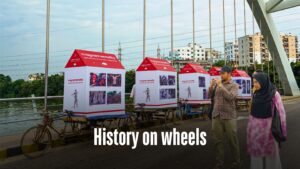
Dhaka’s Moving Tribute to July Revolution
Pedestrians paused in silence, bus conductors gazed from their windows—some recognising familiar faces, others lost in painful memories. A powerful street exhibition in Dhaka displayed haunting images from Bangladesh’s July 2024 Mass Uprising, bringing the city’s recent trauma into public view. “While traditional galleries in Dhaka often cater to only a certain class of people, a floating street exhibition was envisioned as a way to bring art into public spaces—making it accessible to people from all walks of life,” says Taslima Akhter, the acclaimed photojournalist and activist who organised the event alongside Pathshala South Asian Media Institute. On August 11-12 of 2025, five exhibition vans set out from the Raju Memorial Sculpture at Dhaka University, bringing the story of the July Uprising to the streets of Dhaka, covering most of the significant spots where the revolution took place. The key aspects of this floating exhibition were to demonstrate the participation of students, professionals, everyday people—especially women—and the significance of D-Day, August 5. Creatively set up on vans, photographs and artworks were mounted on temporary house-like structures with striking red roofs, drawing the attention of day labourers, students, office workers, chauffeurs, and people from all walks of life—just as they once came together to free the country from the 15-year authoritarian regime under Sheikh Hasina’s government. The vans stopped at key sites of the uprising, letting visitors engage with the images. Organisers admitted the street exhibition was challenging—but they were committed to reaching as many people as possible. Originally planned to honour the martyrs on the uprising’s first anniversary, the exhibition was postponed due to logistical challenges. “What you see now is a collection of the works we were able to gather, with consent from the participating photographers,” said Taslima. She further said how we’re not only fighting the effects of fascist ideology in our society, but also confronting it within our own thought processes. In the past, many artists and photographers hesitated to share their work—uncertain whether to publish without captions, or anxious about choosing the right words. But now, we’re seeing more and more artists overcome that fear, driven by a collective urge to tell the truth through their work. When asked about the downside of everyone having a camera in their hands today, Taslima shared a different perspective. On the contrary, she explained how portable devices have empowered not just photographers but everyday people to document history like never before. If it weren’t for ordinary citizens, much of the horror of the July revolution across the country would have gone unseen. What was once a tool for personal use has now become a powerful instrument for capturing and sharing the truth. Exhibitions like this mark a crucial shift in the power dynamics of information. They democratise memory, ensuring the story of the revolution belongs to everyone—not just a privileged few. They also remind us that art and photography are powerful tools of resistance and collective remembrance. Written by Fariha Hossain Photo: Md. Rasel Ahmed
Read More
Meghna Ceramic’s Fresh brand redefining Bangladesh’s ceramic industry
Sustainability, innovation, and design leadership define Meghna Ceramic Industries Ltd. (MCIL), a concern of Meghna Group of Industries (MGI). Since its establishment in 2021 under the brand Fresh Ceramics, the company has rapidly grown into one of Bangladesh’s leading tile manufacturers while setting new benchmarks in responsible ceramic production. Nestled in Ashariar Char of Meghnaghat, Sonargaon, Narayanganj — nearly 39 kilometres from the capital Dhaka — MCIL boasts the highest tile production capacity in Bangladesh at 51,000 square metres per day. With cutting-edge machinery from the USA, Germany, Italy, and China, and Bangladesh’s longest kiln (261 metres) under a single shade, MCIL reflects both scale and vision. But what truly distinguishes it is a deep commitment to sustainability and environmental stewardship, ensuring growth aligns with ecological responsibility and worker wellbeing. Sustainability at the Core AKM Ziaul Islam, chief operating officer at Meghna Ceramic, explained how Fresh Ceramics is working to remain true to its promise of “A Fresh Start to an Aesthetic Life.” “We have designed our factory to minimise environmental impact while maximising efficiency.” MCIL has taken six core initiatives: Zero Groundwater Dependency: Surface water treated in-house through a Water Treatment Plant (WTP). Wastewater is purified in an Effluent Treatment Plant (ETP) and safely discharged — ensuring a closed-loop water cycle. Emission-Free Operations: Kilns release only clean white vapour, with no carbon emissions or black smoke. Advanced Heat Management: Controlled heat systems eliminate external heat emissions, ensuring worker-friendly indoor conditions. Dust-Free Environment: A dust management system ensures minimal discharge, protecting workers and the community. Renewable Energy Integration: Solar panels feed into the company’s grid, reducing fossil fuel dependence. Daylight Optimisation: Architectural features reduce the need for artificial lighting, lowering electricity use. Together, these initiatives underscore MCIL’s leadership in sustainable manufacturing and its role as a responsible industry pioneer. “We designed the factory not only to protect the environment but also to ensure a safe, healthy, and efficient workplace for our employees,” Islam added. Vision and Growth “The vision behind MCIL was to redefine aesthetic living in Bangladesh by offering high-quality ceramic tile solutions that combine durability, functionality, and design,” Islam said. Fresh Ceramics started with small-sized tiles before expanding across all ranges and surfaces. Known for glossy tiles with exceptional smoothness, it became the first in Bangladesh to introduce a full line of double charge tiles in three market-winning sizes. Building on that success, MCIL now offers matt and matt-carving tiles, with its R&D team pushing innovation to match modern lifestyles. Nationwide, the brand has built a robust distribution network through dealers, retailers, and exclusive showrooms. Its flagship display centre, “House of Aesthetics,” opened in Dhaka’s Hatirpool, with another underway in Chattogram. Innovation and Technology Meghna Ceramic has invested heavily in advanced laboratories and modern systems, ensuring precision, durability, and design superiority. Its laboratory is currently the most advanced in Bangladesh, capable of analysing raw materials and finished products with extreme precision. Social Responsibility “Our parent company, Meghna Group of Industries, is actively engaged in a wide range of CSR initiatives, contributing significantly to community development across Bangladesh,” said the COO. “Uniquely, we have introduced an insurance policy — the first of its kind in Bangladesh’s tile industry — for over 3,000 tile fitters, recognising their essential role in the sector.” Along with this, every year the “Eid Express” campaign is organised, through which the group ensures safe travel for lower-income tile labourers, workers, fitters, and store assistants at dealer showrooms. MCIL also takes pride in other efforts that the group undertakes to contribute to society. “We have currently employed over 1,500 people across our factory, sales, distribution, and support departments. Women are working side by side with men, ensuring an inclusive and diverse workplace,” Islam added. Meghna Ceramic also maintains a clean, safe, and climate-controlled work environment, where skilled and semi-/non-skilled individuals are hired and provided with on-the-job training to help them gain industry-relevant skills. Challenges and Resilience The ceramic industry faces hurdles such as raw material dependency, volatile energy prices, and high taxation. “Over 90 percent of essential raw materials are imported, making manufacturers vulnerable to global fluctuations,” said Islam. MCIL tackles these challenges by running efficient production lines, sourcing through diversified suppliers, adopting renewable energy, and advocating for supportive policies. Market Leadership and Future Outlook Domestically, Fresh Ceramics has become the highest-selling tiles brand in Bangladesh. MCIL is confident of entering global markets soon, backed by international-standard production and competitive pricing. Meghna Ceramic is preparing to expand into sanitaryware alongside new surface technologies and tile sizes. Its strategy balances nationwide reach with a growing focus on metropolitan and cluster markets. “We actively gather market insights and conduct R&D to drive innovation. Our future expansion is designed to make Fresh Ceramics a complete lifestyle solution for customers,” Islam said. Ready for the Global Market MCIL is not just building for the local market — it’s thinking globally. Its advanced production lines, strict quality control, and trend-driven designs make it a strong candidate for international success. “From the ground up, we built MCIL with a global mindset. Our plant layout, automation level, lab testing capabilities, and product design are all geared toward international markets. We’ve already received interest from buyers in the Middle East and Europe,” said Ziaul. He emphasised the brand’s international readiness and commitment to excellence. “Fresh Ceramics is not just a local brand — it’s designed for global demand. Whether it’s product innovation or packaging, we’ve benchmarked ourselves against top-tier global producers. Our leadership believes that only those companies that combine innovation with responsibility will survive in the global arena.” Leading with Purpose With sustainability at its core, innovation driving its growth, and responsibility guiding its social impact, Meghna Ceramic Industries Ltd. is not just producing tiles — it is shaping the
Read More
Driving Tile Innovation in Bangladesh
Introduction: Bangladesh’s Ceramic Industry on the Rise Over the past decade, Bangladesh has witnessed remarkable growth in its ceramic industry, particularly in the field of ceramic tiles. What was once a modest segment catering primarily to domestic demand has now evolved into a thriving sector, contributing significantly to the country’s industrial output, employment, and exports. With rapid urbanization, rising consumer aspirations, and infrastructural development across the nation, ceramic tiles have become a symbol of both practicality and modern living. At the heart of this growth story lies a crucial but often less visible factor: the availability of high-quality raw materials, advanced technology, and reliable technical support. Without a steady supply of consistent, innovative, and globally benchmarked inputs, manufacturers would find it challenging to compete on quality, efficiency, and design. This is where Xphere Global has played a pivotal role through its flagship company, Vidres India Ceramics, driving innovation and providing dependable solutions that have reshaped Bangladesh’s ceramic landscape. Equally important is the role of technology, where Kerajet, Spain, has emerged as a new alternative for world-class digital printing solutions. These advanced technologies are now being introduced to Bangladesh through Trans India Ceramics, the authorized distributor of Kerajet and another group company of Xphere Global. Together, this integrated approach ensures that manufacturers have access to not only the finest raw materials but also cutting-edge printing technology — empowering the industry to deliver tiles and tableware that meet global standards of design and performance. Our Flagship Presence in Bangladesh: Building Trust Over 5 Years A key milestone in the evolution of Bangladesh’s ceramic tile industry has been the entry of Xphere Global and Vidres India Ceramics, which forayed into this market five years ago. Since then, the company has established itself as one of the trusted brands in the sector, delivering reliable solutions that empower manufacturers to enhance quality, innovate with confidence, and stay aligned with global trends. Through a blend of high-quality raw materials, consistency, and innovation-driven partnerships, Xphere Global and Vidres India Ceramics have contributed significantly to raising benchmarks in the Bangladeshi ceramic industry. Our efforts are not just about supplying materials — they are about nurturing long-term relationships and enabling manufacturers to bring world-class surfaces and finishes to both domestic and export markets. Beyond Supply: Technical Support as a Differentiator In the competitive world of ceramics, having access to raw materials is not enough. The real edge comes from knowing how to use those materials effectively to produce innovative, market-ready products. This is where our superior technical support sets us apart. Collaborative Development: Our technical teams work closely with Bangladeshi tile manufacturers, helping them fine-tune formulations, experiment with new surfaces, and troubleshoot production challenges. This collaborative approach ensures that our partners are not just keeping up with trends but setting them. Training & Knowledge Sharing: We conduct technical workshops, training sessions, and joint development programs to upskill local teams. By transferring knowledge and expertise, we empower manufacturers to push boundaries and explore new market opportunities. Problem-Solving Expertise: From glaze application issues to kiln performance, our experts provide hands-on guidance, reducing downtime and ensuring smoother operations. For many manufacturers, this level of support is the difference between staying competitive and falling behind. Technology Partnerships Driving Innovation Alongside raw material excellence, technology plays a transformative role in defining the competitiveness of the ceramic industry. Here, Trans India Ceramics has emerged as a crucial partner, serving as the official distributor for Kerajet S.A., Spain. Kerajet is recognized globally as a pioneer in digital printing technology, delivering highly effective printing solutions that cater to both the ceramic tile and tableware industries. By bringing this cutting-edge technology to Bangladesh through Trans India Ceramics, manufacturers are now empowered to produce tiles and tableware with superior design precision, versatility, and efficiency, ensuring they meet the evolving demands of both domestic and international consumers. This synergy of world-class raw materials, robust technical support, and state-of-the-art printing technology positions Bangladesh’s ceramic sector to compete confidently on the global stage. Leveraging Global Trends for Local Growth Ceramics is a truly global industry, with trends often originating in Europe, the Middle East, or Asia before spreading worldwide. Our presence in multiple international markets gives us a unique vantage point to bring global insights into the Bangladeshi context. Some of the key global trends we have been helping Bangladeshi manufacturers embrace include: Large-Format Tiles: Growing popularity of slabs and large surfaces for modern architecture and interiors. Eco-Friendly Production: Increased demand for sustainable, low-carbon processes and recyclable materials. Digital Printing & Advanced Surfaces: Innovative printing technologies creating wood, stone, and marble-like finishes. Functional Surfaces: Anti-slip, antibacterial, and easy-to-clean finishes gaining traction with health-conscious consumers. By aligning our raw materials and technical services with these trends, we enable Bangladeshi producers to compete not only in domestic markets but also internationally, enhancing the reputation of “Made in Bangladesh” ceramics.
Read More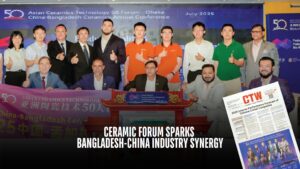
CERAMIC FORUM SPARKS BANGLADESH-CHINA INDUSTRY SYNERGY
In mid-July, Dhaka hosted the Asian Ceramics Technology 50 Forum at Hotel Amari’s Eden Grand Ballroom, marking a pivotal moment for Bangladesh’s ceramic industry. The event gathered leaders from Bangladesh and China to explore innovation, efficiency, and cross-border collaboration under the theme “Product Quality & Production Efficiency Enhancement and Investment Opportunities in Bangladesh – Win-Win Cooperation.” Delivering the welcome address, Irfan Uddin, general secretary of the Bangladesh Ceramic Manufacturers and Exporters Association (BCMEA), emphasised knowledge-sharing and sustainable growth. Praising China’s global leadership in ceramics, he said their participation reflected a shared commitment to regional cooperation. Chief guest Md Mamunur Rashid FCMA, acting BCMEA president and additional managing director of X Ceramic Group, highlighted the forum’s role in strengthening Bangladesh-China ties through joint ventures, technology transfer, and strategic investment. “Forums like this serve as a powerful platform for dialogue, innovation, and mutual growth,” he said, citing supportive government policies. The first technical session, chaired by Mohd Ziaul Hoque Zico, director of BCMEA and CEO of Hua Thai Ceramics, focused on quality and efficiency. Speakers included consultant Engr. Sadat H. Talukder and Luo Fei of Foshan Uniceramics Development. Discussants Saidur Rahman Khan of Akij Ceramics and Yang Shuilan of Foshan Lang Kun Electromechanical added insights. Yang noted rising consumer demand and costs, stressing that “quality and efficiency are not trade-offs but the double-helix genes of survival,” citing intelligent kiln control and AI visual inspection. Talukder pointed out Bangladesh’s low global market share—0.48% in tableware, 0.005% in sanitary ware, and 0.001% in tiles—despite resources, urging advanced kiln technologies, solar integration, and skill development. Khan said quality depends on customer satisfaction, warning that internal and external failures drive up costs, making productivity gains essential. The second session, chaired by Mahin Bin Mazher, adviser to BCMEA and MD of X Ceramic, explored cost reduction and tile performance. Mohammad Bayazed Bashar of DBL Ceramics proposed using locally sourced liquid sodium silicate to cut costs by 50%. He showcased DBL’s zero-waste strategy and cogeneration initiatives that saved 18.8 million standard cubic metre of gas—worth $1.2 million—with pilots targeting net-zero emissions by 2030. Liu Zhanjie of Foshan Uniceramics noted Bangladesh’s rising output. In 2023, the country produced 280 million square metre of tiles and 16 million sanitary ware pieces, with per capita tile consumption at 1.65 sqm—far below China’s 6.9 sqm in 2017 He projected tile output could reach 700–840 million sqm and sanitary ware 40–48 million pieces in a decade. AKM Ziaul Islam of Meghna Ceramic stressed lowering costs and boosting efficiency, citing the sector’s evolution since 1984 and labour advantages. Sun Bowen of Zibo Huayan detailed high-strength ceramic rollers and shuttle kiln technology, with 1.5 million-piece annual capacity. The final session, chaired by Dr Md Anwar Ullah FCMA, featured Md Mominul Haque of LankaBangla Investments, who cited GDP growth of 3.8–3.97%, inflation easing to 8.48%, and reserves rebounding to $31 billion. He noted Bangladesh’s emergence as the 9th largest consumer market by 2030. Muhammad Nazrul Islam of Sandhani Life Finance urged foreign investment, citing high dividend yields. Joanna Sun of Tangshan Hexiang highlighted sanitary ware expertise and 536 patents, including 37 inventions. The forum concluded with a shared vision: Bangladesh-China cooperation can drive innovation, reduce costs, and elevate Bangladesh’s ceramics industry to global prominence. Photo: Courtesy Written by Sajibur Rahman
Read More
Industry Leaders Unite for a Greener Bangladesh
A Call for Sustainable Transformation On January 30, 2025, the Sheraton Hotel in Dhaka hosted “Shaping Bangladesh: Designing Tomorrow, Building Today”, a landmark event organised by Ceramic Bangladesh Magazine. It brought together leaders from construction, real estate, and ceramics to champion sustainability and innovation in response to environmental challenges. Thought Leadership for a Greener Future As part of the series “Innovating for a Sustainable Future II”, the multi-panel format featured experts from ceramics, cement, and real estate. Moderated by Dr. Amir Ahmed of Daffodil International University, the panels included Muhammad Badrul Hassan (BBS Cables), Salehin Musfique Sadaf (GPH Ispat), Architect Faysal Ahmed (Concord Real Estate), AKM Ziaul Islam (Magna Ceramic), Mohammad Khorshed Alam (Akij Bashir Group), Asadul Haque Sufyani (Metro Cement), and Babor Hossain (Khadim Ceramics). Key Recommendations for Sustainability Panelists urged greater investment in R&D to reduce reliance on imports and foster local innovation. They called for collaboration across sectors to promote recycled materials and eco-friendly components. Suggestions included using fly ash and slag in cement, adopting hybrid or electric furnaces, and implementing energy-efficient manufacturing. Smart Materials and Policy Reform Experts advocated for smart glass technologies—low-E, solar, and self-cleaning—to boost building efficiency. They also recommended policy reforms to protect local manufacturers from zero-tariff imports and emphasized the need for government-run clay mines to secure raw materials for ceramic production. Bangladesh’s Tile Industry Comes of Age AKM Ziaul Islam highlighted the tile industry’s evolution since 1984. “We started with 100 mm tiles in one color. Now, we export to the USA,” he said. Despite high production costs, innovation has improved working conditions and sustainability, making the industry globally competitive. Real Estate and Domestic Innovation Architect Faysal Ahmed reflected on the sector’s overreliance on imports between 2000 and 2015. He stressed the importance of collaboration among architects, engineers, and academics to develop sustainable materials locally and reduce dependency on foreign technologies. Material Optimization for Environmental Impact Salehin Musfique Sadaf emphasized that optimized material use can reduce emissions and speed up construction. “Using 15,000 kg of cement instead of 20,000 kg without compromising strength means real sustainability,” he explained. Rethinking Cement and Energy Asadul Haque Sufyani discussed the carbon footprint of cement production and promoted fly ash and slag as eco-friendly alternatives. He stressed the need for affordable, sustainable materials and energy-efficient technologies. Energy Crisis and the Future of Glass Mohammad Khorshed Alam raised concerns about gas shortages affecting glass furnaces. He urged investment in hybrid furnaces and advanced technologies and called on architects to incorporate more locally produced glass to avoid overcapacity and unsold stock. Ceramic Bricks: A Smarter, Greener Choice Babor Hossain showcased ceramic bricks’ advantages over handmade red bricks—lower water absorption, higher strength, and reduced structural load. “They were used in national landmarks and can cut construction costs by 13 percent,” he said, advocating for government-run clay mines to sustain innovation. A Unified Path Forward The event concluded with a call for synergy among policymakers, industry, and academia. With rising climate risks and infrastructure demands, embracing innovation is not just strategic—it’s essential. Photo: Courtesy
Read More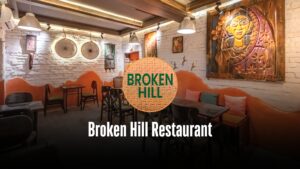
Create your story in the alley of Kalabagan
magine walking down a road in a residential area when suddenly an old brick gateway catches your attention. A softly lit alley leads you towards a small, cosy restaurant with a beautiful antique and warm ambience. Located right beside the popular “Tea & Tea” restaurant and owned by the same person, this place remains crowded most of the time. Youngsters keep the restaurant lively throughout the day, while in the evening and at night families usually come here to dine. The cosy environment, ambience, décor, and food, everything is bound to make your time memorable. Architect Hashim Reza Opu, principal architect of Arch_Station, is the designer of this beautiful restaurant. He shared with us the design journey, concept, theme, and challenges. Designing a restaurant in such a compact area, only 12 by 23 feet, or 550 square feet in total, while accommodating seating, a counter, a spacious kitchen, an attached toilet, and even a semi-outdoor smoking zone, was a huge challenge. The building was old, and the designer wanted to keep its essence intact. Creating an antique-themed restaurant within a limited budget and compact space was also demanding. To meet the challenge, he began with the layout plan. By removing partition walls, he created a free-flowing space for the main dining area. Ar. Opu said, “Creating a memory, creating a story was the main concept of the design. Stories can be of many types — rock story, sad story, soft story, museum story. But what I wanted to tell was an old story. Kalabagan is a nostalgic place for many. People have memories here. I wanted to preserve that memory.” The walls, with plaster falling off in many places, were preserved in their natural undulated patterns. A basic colour coat was applied to the brick portions, and the lower plastered layer was finished with a thick skim coat in the colour of old lime plaster. This undulation gives the walls the vibe of a broken hill. Seating was carefully designed with ergonomics in mind. Sofa heights were adjusted for comfortable dining, and circulation was kept clear. Multiple seating modules make the compact space versatile: couple seating, four-person arrangements, and cluster options where two four-person tables can easily host eight. There’s also a single chair tucked into a corner by a bookshelf, where someone can sip a drink and read; either a book, or simply the whole atmosphere of the place. The handcrafted, polished tables are beautiful enough to spark curiosity about their story. Every detail starting from the tables to the antiques on the wall, from the windows to the ceiling ribs is thoughtfully designed to capture attention. The window grills, repurposed from the upper floors, were painted in vintage green and white. The ceiling features wooden ribs reminiscent of old zamindar houses, with concealed lighting that creates a warm ambience. The lighting adapts to the crowd, with three different moods: concealed ceiling lights, hanging lamps above tables, and directional spotlights highlighting the exhibits. The walls act as canvases, displaying art and antiques: rickshaw wheels with strip lights, a striking wood carving of a woman, an antique clock, a heavy bell, and more. Solid doors were partially replaced with glass, creating curiosity and ensuring visibility of the place. On one wall, an “urban elevation” was designed with two doors and two windows, and even a vintage grill was placed on a closed wall to continue the elevation effect. The counter is particularly unique. Built from the bricks of the existing walls, it alternates layers of wood, brick, and lime plaster, with lighted glass voids in between. This experimental design turned out beautifully. Behind it, a compact 8-by-12-foot linear kitchen supports the operation. One highlight is the “Van Gogh Corner,” where a large Café Terrace at Night painting adorns the wall. This veranda-like space serves as a smoking zone and makes visitors feel as though they are inside the painting. The artwork extends into the seating area and lighting, with warm illumination falling on stone flooring below. Every small detail contributes to the crafted atmosphere. The walkway, handmade with brass concrete textured using nails, is designed like a landscaped path inside a city alley. From its entryway to its tiniest detail, the restaurant tells a story; a story of memory and nostalgia, enriched with antiques and thoughtful design. The alley of beautiful memories is waiting for you in Kalabagan. Written by Sadia Tarannum
Read More
A Legacy Written in Brick and Trust
In 1992, when Dhaka’s middle class was just beginning to dream beyond modest apartments, a quiet vision began to take root. It was not about towers or market share but something simpler: “We stand for more than just buildings. We stand for trust, quality, and long-term relationships,” said Wasif Shamsul Alamin, Executive Director of Shamsul Alamin Group. That ethos, inherited from his grandfather, has since grown into one of Bangladesh’s most enduring real estate legacies. From its official founding in 2003, Shamsul Alamin Real Estate Ltd. built its reputation project by project, with a principle as straightforward as it was profound—do what you promise. “Our reputation wasn’t built on advertising slogans; it was built on living up to our core principles of trust and quality, project after project,” Wasif explained. Today, with more than 50 completed projects across Dhaka, the company’s presence stretches from Gulshan and Banani to Uttara, carrying forward a legacy of care, not just construction. Resilience in a Changing Market The journey has not been without challenges. Financing remains a major obstacle, as higher bank rates strain both buyers and developers. Rising costs of steel, cement, and land add further pressure. Yet the company continues to innovate, exploring modern methods like steel-frame construction and embedding sustainability features such as rainwater harvesting and energy-efficient materials. “We’re not driven by volume or profit. We’re driven by purpose—to create high-standard, thoughtfully designed living spaces,” Wasif said, underscoring how the firm positions itself in a market projected to reach $3.53 trillion by 2028. Living Spaces with Soul In Baridhara’s diplomatic enclave, the company’s philosophy finds expression in Alamin Tonmoy, a residential project that feels more like a sanctuary than a structure. With its lush greenery and private, one-apartment-per-floor design. Tonmoy embodies what Wasif describes as “homes, not just properties”—spaces where life breathes and privacy thrives. Back in Gulshan 1, Alamin Angur offers another lens into the company’s vision. Its three-bedroom residences reflect tranquillity and family living, designed for those who value both space and community. Angur demonstrates the company’s sensitivity to everyday life in Dhaka, marrying functionality with understated elegance. Workspaces for a Modern City If Tonmoy and Angur show the company’s care for private living, its commercial ventures display equal attention to the rhythm of modern business. In Banani, A&A Alamin Business Bay reimagines what a workspace can be. With thermal glass façades and wellness- oriented design, it is less about corporate square footage and more about creating an environment where businesses flourish holistically. At Kakrail, Alamin Capital Square rises with quiet confidence. Its design balances aesthetics with longevity, providing corporate tenants not only modern facilities but also a sense of permanence. From prayer spaces to community floors, the tower reflects a corporate philosophy grounded in dignity and practicality. Further north, in Uttara, Plaza 15 stands as a landmark of accessibility and commerce. Along the wide Gareeb-E- Newaz Avenue, the development’s positioning makes it a hub where business meets community. Its scale and convenience are matched by a forward-looking approach to safety, offering Dhaka’s new commercial class both ambition and assurance. Problems that Demand Solutions Yet behind this skyline of promise lies a sector grappling with deep-rooted problems. Financing remains perhaps the most pressing. As Wasif explained, interest rates on home loans now hover between 9 and 18 percent, making mortgages unaffordable for many aspiring homeowners. Developers, too, feel the squeeze as project financing grows increasingly expensive. “We saw the positive impact when government pushed for single-digit housing loans,” he recalled. “Those initiatives truly stimulated demand. To keep this growth going, we need a similar approach.” Land scarcity in Dhaka adds another layer of complexity. Prices continue to soar, putting pressure on companies committed to affordability. Add to this the volatile costs of raw materials—cement, steel, glass—and the challenge of offering high-quality housing at reasonable prices becomes all the more daunting. For firms like Shamsul Alamin Real Estate, the task is not only to build but to do so within constraints that demand creativity and resilience. A Sector of Immense Potential Still, the potential of the sector is undeniable. With rapid urbanisation and a rising middle class, demand for housing remains resilient—even in the wake of global disruptions like COVID-19. Over the past 15 years, Bangladesh’s real estate market has witnessed remarkable growth, now valued at $2.68 trillion and projected to expand to $3.53 trillion by 2028. “Urbanisation and rising incomes are driving huge demand for homes. The numbers speak for themselves,” Wasif observed, framing real estate as not just an economic driver but a reflection of the nation’s transformation. Charting a Way Forward The solutions, according to Wasif, must come from both industry and policy. Innovation in design and construction can help lower costs and speed up delivery. Techniques like steel-frame building, once an experiment, are now becoming viable tools for efficiency. Sustainable features—energy-saving materials, green spaces, rainwater harvesting—are being embedded not just for environmental reasons, but because they reduce long- term living costs for homeowners. Policy, too, must evolve. Affordable, long-term mortgage schemes would unlock home ownership for middle-income families, while easier access to credit for developers could keep projects moving forward. Collaboration between state and private sector, Wasif argued, is the key to ensuring that the housing dream remains within reach for millions of Bangladeshis. Building More than Structures For Wasif, the mission is deeply personal. “Working in this company means being part of something bigger than just business—it’s about contributing to a legacy of honesty, care, and creating lasting value in people’s lives,” he said. In his words, real estate is not about concrete alone—it is about the dreams of families, the pride of ownership, and the future of a city that is still writing its skyline. Shamsul Alamin Real Estate
Read More
SACMI Continua+ Veloce: unmatched productivity
Available on all models, this new configuration delivers higher speeds and output rates up to 35,000 square meters per day. Further new features: it’s now possible to produce fired slabs up to 200 cm wide, with all the intrinsic advantages of a technology that sets the industry standard for productivity, versatility and low consumption. The number of solutions sold worldwide is now fast approaching 200. More productivity, less waste and lower consumption are the hallmarks of SACMI ceramic plants. Now, the Continua+ Veloce configuration takes those advantages to the next level. With this latest hyper-productive PCR version, the world-leading Continua+ slab and sub-size manufacturing technology now delivers higher speeds and a productivity up to 35,000 m2 per day for single machine. Now available on all PCR models, the Veloce configuration enhances the intrinsic advantages of this technology: for example, with the increased productivity, specific consumption at the compaction stage – already the world’s lowest – drops to just 0.04 kWh/m2. And there’s more. It’s also possible to combine the Veloce configuration with a broader compaction front to let manufacturers produce fired slabs up to 200 cm wide, vary thickness from 3 to 30 mm and obtain potentially infinite lengths. The increasingly popular Continua+ (the number of solutions sold worldwide is fast approaching 200) continues to be the leading ceramic slab and sub-size production technology. On Continua+, in fact, compacted scrap is always less than 1.5% regardless of the size, with all of it able to be recycled back into the process. Recipes and settings can be controlled flexibly via the operator panel, while motor-driven size changeovers maximize efficiency when handling complex, diversified production mixes. Quiet, easy to manage and with powerful results, Continua+ also reduces hydraulic oil requirements by over 90% compared to traditional or discontinuous presses. Slow, controlled de-airing ensures product uniformity and consistency, resulting in versatility with all body types and outstanding quality: a vital finishing touch to a solution that lies at the heart of the SACMI ceramic plant. More power, more control: alongside the latest Continua+ configurations, customers can also enjoy the advantages of new process control devices such as Optima+, part of the broad range of vision systems with which SACMI completes digitalization of the plant, simplifying its running while reducing the need for manual tasks.
Read More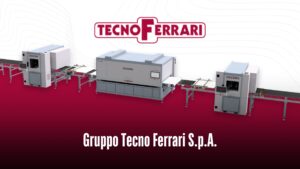
Gruppo Tecno Ferrari S.p.A.
Gruppo TecnoFerrari S.p.A. is a leading Italian company with over 55 years of experience in manufacturing and supplying industrial automation for ceramics. The company’s product range includes – Handling and storage systems – Intralogistics solutions – Digital printers – Vision, quality control, and end-of-line systems Thanks to the high-quality know-how, TecnoFerrari extends its service to all manufacturing sectors, with a focus on ceramics, automotive, glass, food and beverage, paper and tissue. TecnoFerrari guarantees maximum plant reliability and the efficiency of highly customized solutions. New Product Details TecnoFerrari introduces a new way of digital decoration and application. The Decora line-up includes super-rigid monocoque frames with configurations that can accommodate 2, 8 or 12 colour bars, offering flexibility to design an optimized decoration line. Decora 2 takes the concept of flexibility to the next level by allowing the enrichment of the ceramic surface through the use of functional inks. It offers a new way of digital glazing. Same layout, same raw materials, but different effects. Unique Features: Compact, Flexible and Movable. Uses: Ideal for creating special effects and functional surfaces. Benefits: No more static images: each product becomes a unique, personalized piece. This technique delivers outstanding performance, especially in the production of structured or functional surfaces, combining the mass of material with the definition of the printed design. It can synchronize with existing printing machines, enabling optical centering of the image on tile.
Read More
Stability at a Cost Monetary Discipline Tests Industrial Resilience
Businesses grappling with rising borrowing costs and surging energy prices are set to face additional pressure in the second half of this year, as the country’s central bank has decided to hold its policy rate steady at 10 percent for the July-December 2025 period. Bangladesh Bank has sent a clear message: the contractionary stance will remain in force until inflation falls below the 7 percent threshold. While the central bank frames this as a necessary measure to rein in stubbornly high prices and safeguard macroeconomic stability, the impact on businesses is already being felt. Key sectors such as ceramics, ready-made garments (RMG), and leather are contending with elevated borrowing costs and energy prices—pressures that threaten profitability and investment momentum. Prof Dr Mustafizur Rahman, distinguished fellow at the Centre for Policy Dialogue (CPD), warns that these rising costs are undermining business confidence and long-term growth prospects. He urges policymakers to focus on reducing non-borrowing expenses and to introduce targeted support measures. Without sustained reforms and a more balanced policy mix, he cautions, the trade-off between inflation control and economic vitality may become increasingly difficult to manage. Businesses Under Strain For Bangladesh’s industries, the continued high-interest environment presents a significant challenge. Sectors such as ceramics, RMG, and leather—cornerstones of the economy—are squeezed between rising input costs and shrinking access to affordable finance.\ “Maintaining a 10 percent policy rate is a cautious but necessary step in the present inflationary environment,” said Md Mamunur Rashid FCMA, senior vice president of the Bangladesh Ceramic Manufacturers and Exporters Association (BCMEA). “A disciplined monetary stance will help restore investor confidence, but it must be aligned with supportive fiscal policies,” he added. He highlighted the severe pressures facing manufacturers: “The ceramics sector relies heavily on a stable gas supply. Frequent gas shortages and substantial price hikes are pushing production costs up by 18–20 percent. This not only reduces profit margins but also makes debt servicing more difficult.” “Without stable exchange rates and smoother access to credit, businesses will struggle to remain competitive.” The RMG sector, already confronting new US tariffs, faces similar headwinds. Higher borrowing costs for working capital, coupled with uncertain global demand, threaten to dampen earnings and investment. Expert Analysis CPD’s Mustafizur Rahman said businesses such as RMG, ceramics, and leather are facing formidable challenges due to Bangladesh Bank’s contractionary policy, with its high policy rate of 10 percent. The elevated rate drives commercial bank lending rates upward, resulting in increased costs for businesses. He added that rising gas and electricity prices are further escalating operational costs, making it even more difficult for firms to sustain profitability. Prof Rahman suggested that Bangladesh Bank may consider reviewing the policy rate once inflation drops to 7 percent. In the meantime, policymakers should provide support to businesses by helping reduce non-borrowing costs. He noted that reducing inflation depends on multiple factors, including uncertainty reduction, law and order, political stability, fiscal policy, and market management. In Bangladesh, tightening monetary policy alone cannot produce the desired results. “The current contractionary monetary policy is being pursued at a time when the economy is experiencing investment stagnation,” he said. Prof Rahman argued that the rate should be revised once a sustained downward trend is observed. He also pointed out that while contractionary monetary policy aims to curb inflation, high borrowing costs undermine investment and raise the cost of doing business. Such pressures may weaken supply-side responses, which in turn could fuel inflation. Moreover, high inflation often triggers demands for higher wages, further pushing up prices. The trade-offs are therefore evident. According to Prof Rahman, reducing the cost of doing business and improving the overall business environment are particularly important when a contractionary monetary policy is in place. Otherwise, the very objective of such a policy could be undermined. BB Holds Firm Bangladesh Bank Governor Dr Ahsan H Mansur defended the decision, stating, “Until inflation comes below 7 percent, the policy repo rate will remain unchanged.” He argued that macroeconomic stability is a prerequisite for sustainable growth. Inflation has eased from a peak of 11.66 percent in July 2024 to 8.48 percent by June 2025. Gross foreign exchange reserves have inched up to $26.7 billion, and the adoption of a fully flexible, market-based exchange rate regime has brought a measure of stability to the currency market. The central bank cautioned that ongoing cost pressures from past currency depreciation and US tariff measures could hinder a sustained fall in inflation. Navigating the Road Ahead Experts emphasised that monetary tightening alone is not enough. Dr M Masrur Reaz, chairman and CEO of Policy Exchange Bangladesh, called the central bank’s stance “the right move in the current context” but warned it must be complemented by fiscal reforms, banking sector consolidation, and supply-side efficiency. Despite headwinds, growth is projected to rebound to between 5 and 5.5 percent in FY26. The central bank has signalled it may adjust the policy rate if businesses are severely affected by US tariffs, but only in a way that safeguards inflation objectives. For now, businesses must contend with tight credit, rising input costs, and global uncertainties. The resilience of firms and the pace of structural reforms will determine how well Bangladesh balances inflation control with economic growth. Written By Sajibur Rahman Photo: Courtesy
Read More
A Showcase That Brings Dreams to Living Rooms
At big housing expos, the noise is usually deafening — developers pitching, buyers bargaining, stalls glittering with scale models of shiny towers. This year, the spectacle has gone quiet. The DBL Ceramics Online Housing Fair, hosted by Prothom Alo Digital, opened on August 25 with only a small ceremony at Hotel Sonargaon, while most of the action unfolds on computer screens and phones. Over the next ten days, until September 3, prospective buyers can browse more than 256 projects from 38 housing companies on abashonmela.pro. The listings include 283,000 kathas of land, 5,230 flats, and 412,000 square feet of commercial space — all available to explore without leaving home. The fair’s slogan captures the idea simply: “The Opportunity Has Come Again. Find Your Dream Home from Home.” A Digital Market for a Stubborn Dream Bangladesh’s appetite for land and housing has never been small. In a country where urbanization runs ahead of infrastructure, the dream of owning a flat in Dhaka remains one of the most powerful middle-class aspirations. Families save for years, often with support from relatives abroad, only to find that prices have risen faster than their savings. With national elections due in February, many are waiting for signs of stability before taking the plunge. Against this backdrop, the launch of an online housing fair offers more than just marketing. It is, for many, a way to keep the dream alive. “Organising an online housing fair was a new idea in Bangladesh,” said Matiur Rahman, Editor and Publisher of Prothom Alo, at the inauguration ceremony in Dhaka. “Through it, we even gained international recognition.” He acknowledged the pressures the industry now faces. “The housing sector is going through a crisis, largely because of the political transition a year ago,” he said. “Every political change affects business. We hope that after the coming election, a new government will create the stability we need to move forward.” “The world is moving forward rapidly,” said MA Quader, Deputy Managing Director and Group CEO of DBL Group. “Whether in Dhaka or abroad, you can now search for flats and plots online. That opportunity is a gift.” For many, the gift is convenience. For developers, it is survival. With traditional sales slowing, the fair offers visibility at a time when foot traffic to offices and showrooms has dwindled. Shoppers browsing from London or Singapore can now weigh Dhaka apartments with the same ease as airline tickets. A growing diaspora, sending billions in remittances each year, is becoming a crucial customer base. “Earlier, you had to call an uncle or cousin to check on a property,” said one Dhaka-based banker. “Now you can compare projects in minutes. That changes everything.” “The online housing fair has brought a new wave of enthusiasm to the sector,” said Md Wahiduzzaman, President of REHAB. “Our members are eager to take part, and interest will only grow in the future as people can now search for their preferred flats from the comfort of home.” Cracks in the Foundations Yet the optimism is tempered. Executives across the sector point to one persistent obstacle: the Detailed Area Plan (DAP) for Dhaka, which limits the height of new buildings across 80 percent of the city. “Since the new DAP notification, the housing sector has been paralysed,” the REHAB president said. “Our members face restrictions that make new projects difficult.” A recent government meeting on potential revisions has raised hopes, but until decisions are finalised, developers remain cautious. “If the revisions are confirmed next month, businesses will be able to work again,” he added. The debate over DAP is not just technical. It touches on the core dilemma of Dhaka: a city bursting with people but running out of space. Environmentalists argue that unchecked vertical growth could worsen congestion and strain utilities. Developers counter that without high- rise flexibility, affordable housing will vanish. At the same time, bankers and financiers know the larger picture cannot be ignored. Loans are harder to secure, construction costs remain high, and global uncertainties feed into domestic anxieties. Still, the fair pushes ahead, offering a window into what is possible when policy, finance, and consumer demand align. A Ballroom of Deals and Dreams The launch night itself mixed hard economics with ceremony. Executives from IPDC Finance, Eastern Bank, Hatil, Angan Developments, Chhuti Resort, Haque Home and Builders, Onward Developers, and Shopnonibash Group took the stage. Their speeches circled back to the same themes: resilience, innovation, and the promise of stability. “I am very optimistic,” said Quader of DBL Group. “After every night comes the morning and sunrise. We are waiting for that day.” The fair’s format reflects this optimism in action. Visitors logging on to abashonmela.pro can sift through offerings ranging from compact apartments to sprawling land plots. They can compare financing packages from Eastern Bank and IPDC Finance. They can weigh furniture solutions from Hatil or imagine a holiday escape at Sea Pearl Beach Resort, a co-partner of the fair. It is part commerce, part imagination: the picture of a different life assembled from a grid of images and brochures. For some, that picture might mean a first family flat in Mirpur; for others, a gated community on the city’s northern edge. A Who’s Who of Builders The roster of participants this year reads like a directory of the sector’s leading names: Amin Mohammad Foundation, Rangs Properties, Edison Real Estate, Tropical Homes, Anwar Landmark, Asian Duplex Town, JBS Holdings, North South Group, Credence Housing, Swapnonibash Assets, Bhaiya Group, Concord Group, Nest Developments, Doyel Development Properties, Team Developers, Eminence Technologies, Unimass Holdings, Haque Home and Builders, and Pinaki Holdings. For them, the fair is not just a sales platform but a chance to signal staying power. In a fragile market, visibility matters, and buyers often look for reassurance as much as bargains. “We want to show that we’re still here,” said one developer privately. “That continuity matters in
Read More
Designing with Light Living with Heart Architecture of Ziaul Sharif
In the narrow lanes of early 1990s Dhaka, a young boy paused in front of construction sites and miniature models displayed on black-and-white television sets. These fragments of the city—raw, unfinished, full of potential—captured his imagination. For Ziaul Sharif, architecture began not in a classroom, but in the rhythm of passing buildings, the dance of light on brick, and a deep curiosity about how spaces are made. Now the founder and principal architect of Vuu-Maatra Consultants, Ziaul Sharif is shaping a quietly radical vision for contemporary architecture in Bangladesh—one where light, air, greenery, and local wisdom are not design options, but essentials. A Creative Foundation Born in Rajshahi and raised in Dhaka, Ziaul Sharif grew up in a home where intellect and creativity were part of daily life. His father, MM Shahidullah, practised law with conviction; his mother, the late Mrs. Shireen Shahid, fostered a home filled with music, art, and community spirit. From teaching music to children at Ghashful Khelaghar Asor to painting and acting, Sharif’s early exposure to the arts enriched the spatial sensibility that now defines his work. After completing his education at Rayer Bazar High School and Dhaka City College, Sharif pursued architecture at BUET, one of Bangladesh’s most respected institutions. There, he studied under the renowned Professor Shamsul Wares and found himself drawn to the work of Louis Kahn—especially the National Parliament Building, whose poetic use of space and light remains a lasting influence. Design as Responsibility Sharif’s early professional journey included stints with Bashirul Haque & Associates, Indigenous Architects, and Nandan Architects. In 2006, he took on the resident architect role for Westin Dhaka, a five-star hotel project that refined his understanding of scale and detail. But it was in 2008, with the founding of Vuu-Maatra Consultants, that his practice truly found its voice. Today, the studio is home to 15 designers, architects, and engineers, and their portfolio spans from high-rise commercial buildings to hotel interiors and private residences. But what sets the firm apart isn’t the scale of its projects—it’s the intention behind them. “We don’t just design buildings,” says Sharif. “We design environments for life. For growing up, resting, healing, thinking. For breathing.” This approach is deeply humanistic, rooted in the belief that architecture has a profound impact on the mental and physical well-being of its occupants. In a city where poorly ventilated, densely packed housing is the norm, Architect Ziaul Sharif advocates for an alternative: buildings that breathe. Vasat Vita: A Living Prototype Nowhere is this philosophy more evident than in Vasat Vita, Architect Ziaul Sharif’s residence and studio in Dhaka’s Aftabnagar. Completed in 2022, this three-storey structure sits on a compact 200-square-metre plot but opens inward to an expansive experience of air, light, and greenery. Built with passive cooling principles inspired by Vaastu Shastra, the building features a central courtyard open to the sky, a waterbody that moderates internal temperatures, and a layered brick façade that filters sunlight while ensuring privacy. A ribbon of plants tucked between the perforated brick shell and the glass wall brings nature directly into the building’s envelope. “Vasat Vita is not just a home or an office,” Sharif explains. “It’s a lab for ideas. A demonstration of how we can live better, even in the tightest corners of Dhaka.” The project was recently featured in ArchDaily, highlighting its relevance not just to local contexts but to global conversations about compact urban sustainability, thermal comfort, and culturally responsive design. Architecture for People Architect Ziaul Sharif’s commitment to accessible design extends beyond his client list. Through Vuu-Maatra, he has initiated a pro-bono programme to offer free architectural services to families who cannot afford professional help. Projects in Khulna and Kushtia, including a residence for Aarti Rani Mandal, are built on this ethos of design as dignity—ensuring that even modest homes receive the same care and thought as luxury hotels. This vision challenges the long-held assumption that architecture is a service for the elite. “Everyone deserves a well-designed home,” Sharif insists. “Good architecture shouldn’t be a privilege. It’s a necessity.” A Future Rooted in the Past Sharif’s work draws as much from memory as it does from modern techniques. He recalls walking past old brick buildings in Old Dhaka, noticing how they aged gracefully, filtering air and light through intricate jaali patterns. These early experiences now manifest in his façades, his ventilation strategies, and his material choices. In an era obsessed with glass towers and instant spectacle, Ziaul Sharif’s architecture is refreshingly quiet. It invites you to pause. To feel. To notice how the air moves, how shadows stretch, and how a space can hold you gently. With every project, Sharif is not just building structures—he’s building the belief: that architecture can be beautiful, democratic, sustainable, and deeply personal. Vuu-Maatra Consultants is currently expanding its portfolio across Bangladesh, continuing its mission of designing with empathy, responsibility, and rooted imagination. Written by Fatima Nujhat Quaderi
Read More
Reviving the Roots: Conservation & Restoration Progress Reflections by Conservation Architect Abu Sayeed M Ahmed
At the anniversary celebration of Ceramic Bangladesh Magazine, esteemed conservation architect and heritage specialist Abu Sayeed M Ahmed presented “Reviving the Roots: Conservation and Restoration Progress”—a heartfelt journey through two decades of architectural conservation across Bangladesh. With vivid images and powerful anecdotes, he reminded the audience that conservation is not about romanticising ruins—it is about safeguarding identity, craftsmanship, and cultural continuity in a nation at risk of forgetting itself. “Every day in Dhaka, a piece of our heritage vanishes. Buildings are bulldozed in the name of development. But without roots, how can we grow a future that is truly ours?” Bringing History Back to Life Nimtali Deuri & Naib-Nazim Museum, Dhaka Abu Sayeed M Ahmed’s first major restoration was the late Mughal-era Nimtali Deuri in Old Dhaka. Hidden under layers of plaster. The restored gateway now houses the Naib-Nazim Museum, commemorating the deputy governors of Dhaka and reflecting a revived connection between the city and its Mughal past. Uttar Halishahar Mosque, Chattogram This 200-year-old mosque was facing demolition for modern expansion. Upon assessment, its authentic Mughal character became evident. Abu Sayeed’s team removed inappropriate cement layers, dismantled an added veranda, and re-clad it in traditional lime and surki. Locals now call it a “Gayebi Mosque”—as if it reappeared by miracle. Nearby, a new mosque by Architect Kashef Mahboob Chowdhury respectfully contrasts the old, echoing its jali motifs in modern concrete. Hanafi Jame Mosque, Keraniganj Once a modest family-owned mosque, it gained global recognition after restoration—winning a UNESCO Award. A new mosque built adjacent to it by Architect Kashef Mahboob Chowdhury, with full visibility of the old structure—offers a striking example of architectural dialogue between past and present, tradition and transparency. Rediscovering Rural Heritage Buraiich Maulvi Bari, Faridpur Neglected and engulfed by vines, this ancestral home seemed destined for ruin. Through sensitive restoration, it has been transformed into a heritage Airbnb, preserving its traditional character while offering economic sustainability. Period furniture, handpicked materials, and contextual storytelling give visitors a window into Bengal’s rural past. Mithamoin Kachari Bari, Kishoreganj This decaying administrative house—once thought beyond repair—was restored to reflect its original civic purpose. From a wild, overgrown ruin, it emerged as a dignified reminder of regional governance and colonial-era architecture, now serving as an active public building. Urban Civic Revival Narayanganj Municipal Building Among Bangladesh’s earliest municipal structures, it was at risk of being replaced. A dual solution—preserve the old and integrate it into the new. Today, it functions as the entrance to the new Nagar Bhaban (City Hall), and plans are underway to convert its upper level into a civic museum. Baro Sardar Bari, Sonargaon A Mughal-Colonial mansion from the Baro-Bhuiyan era, this structure was revived through corporate social responsibility. South Korea-based Youngone Corporation led the project under the leadership of CEO Kihak Sung, who has familial roots in the region. This model highlights how private sector investment can play a crucial role in cultural restoration. Reviving Lost Icons Dhaka Gate (Mir Jumla Gate) Once a neglected and overgrown monument, the historic city gate has been revitalised with its original grandeur—complete with a replicated fire cannon that signals its defensive legacy. Rose Garden Palace, Tikatuli, Dhaka A jewel of Dhaka’s architectural heritage, the Rose Garden was meticulously restored—from stained-glass panels to ornamental plasterwork. Where pieces were missing, they were reconstructed based on archival records, ensuring authenticity over imitation. Hammam Khana, Lalbagh Fort Perhaps the most complex restoration, the Mughal-era bathhouse had suffered colonial and post-colonial misuse. Funded by the U.S. Ambassador’s Fund, the project uncovered a breathtaking pavilion structure, restored lighting from above (true to hammam tradition), and reestablished the original spatial and sensory quality of the Mughal bathhouse. Crafting the Future with the Past Reviving Chini Tikri Ornamentation A rare local tradition, Chini Tikri—the use of broken ceramic dinnerware to form decorative motifs—was resurrected. The team digitally reconstructed patterns, reproduced the plates, broke them and reapplied them by hand. This craft was even adapted into a contemporary mosque in Noakhali, designed by Architect Mamnoon Murshed Chowdhury and Architect Mahmudul Anwar Riyaad, using waste ceramic products donated by Monno Ceramics. These projects demonstrate what is possible when craftsmanship, community, and conservation come together. They are not just restorations—they are cultural revivals, offering spaces where memory, faith, and identity continue to live. Written by Samia Sharmin Biva
Read More
Clay Dreams Crafted by Hand Ali Ceramic Industry Limited
A Parcel That Changed Everything In the early 1980s, a seemingly ordinary parcel delivered from Italy to a Bangladeshi family quietly set the stage for a life-changing transformation. Inside were handmade clay tiles—simple, earthy, and elegant—that inspired a new industrial journey rooted in tradition. The arrival of the tiles sparked an unexpected curiosity, drawing the family, engaged in ship management, into the intricate world of terracotta craftsmanship. This newfound passion led them from coastal shipping operations to the rural “Pal Para” villages, where generations of potters lived and worked. Decades later, that spark has evolved into Ali Ceramic Industry Ltd (ACIL), a rising name in Bangladesh’s ceramic sector. The company is now dedicated to producing 100% eco-friendly terracotta tiles, continuing a legacy built over 43 years. Backed by deep experience and a commitment to preserving clay artistry, ACIL is on a mission to blend sustainability with tradition. However, the ceramic maker had to go through numerous hurdles to reach today’s position. From economic turmoil to energy challenges, Ali Ceramic’s journey has tested its resilience—making its commitment to green craftsmanship truly admirable. From Shipping to Shaping Clay Before entering the ceramic business in 1982, the family of Ali Askar—now the Managing Director of ACIL—was involved in managing ships. Askar himself was just a Grade 9 student when he first began assisting in the family’s factory office. What started as part-time help during his school years gradually grew into a lifelong calling. The pivotal moment came through a surprising phone call. One day, Askar’s father was contacted by an Italian friend who asked if a product could be manufactured in Bangladesh. Without disclosing details, the friend sent a parcel. Inside were handmade clay tiles—a product so visually striking that it would eventually redefine the family’s business path. In Search of the Perfect Artisan Motivated by the parcel, Askar set out on a mission to find skilled artisans capable of replicating such craftsmanship. He travelled across Bangladesh, visiting various districts and exploring ‘Pal Para’—traditional villages of potters where pottery is not just a livelihood, but a way of life. After surveying several regions, Askar discovered exceptional potters in Satkhira. The Italian friend even joined a visit to the village and was impressed by the quality of work. This validation paved the way for launching an export-oriented business producing 100% eco-friendly handmade terracotta tiles under the name Maa Cottos Inc. Maa Cottos and Nikita International: A Legacy in Clay Maa Cottos Inc. serves as the parent company of ACIL, while Nikita International—another venture under the same umbrella—also manufactures 100% handmade terracotta tiles. Founded in 1982 as a family-run enterprise, Nikita International has grown into the largest handmade tile manufacturer not only in Bangladesh but across Southeast Asia. Over the past four decades, the company has built a reputation for high-quality structural clay products, including roof tiles, wall cladding tiles, and floor tiles. Their dedicated in-house research and development team continues to innovate, ensuring they remain relevant in both domestic and international markets. While Nikita International specialises in a broad range of traditional clay products, ACIL has taken a more modern approach, focusing on high-end machine-made terracotta tiles designed for contemporary architectural projects. Ali Ceramic’s Battle to Rise “Ali Ceramic was established in 2021, but its commercial production began in July 2024,” said Ali Askar. With a current daily output of 40,000 square feet of tiles and 170 employees, the company has already made a strong start. Its total investment stands at Tk 1.5 billion. However, Askar noted that despite this solid foundation, ACIL’s growth is being hampered by external challenges such as political instability and economic uncertainty. The July Uprising One such challenge emerged shortly after ACIL began full-scale production. Within a year, Bangladesh was shaken by the July Uprising, which brought government development projects to a halt. According to Askar, many of the contractors they had established relationships with were replaced in the wake of political upheaval, severing existing business ties. The re-tendering process for paused projects introduced further delays and added a new layer of unpredictability to ACIL’s business landscape. Production Challenges: Energy and Raw Materials In addition to political disruption, ACIL has faced ongoing operational difficulties. A key concern is the absence of a Titas gas connection, which has forced the company to rely on liquefied petroleum gas (LPG)—a costlier alternative that significantly raises production expenses. Despite these setbacks, ACIL has managed to maintain product quality. Clay is sourced from regions such as Gazipur and Sylhet, chosen for their reliable natural composition and consistency, ensuring each tile meets the company’s exacting standards. Handmade Tiles: Craft Holds the Crown While machine-made terracotta tiles remain common among Bangladeshi producers such as Mirpur Ceramic Works Ltd. and Khadim Ceramics Ltd., there is a noticeable shift in the global market. Foreign buyers are increasingly drawn to handmade tiles for their aesthetic charm and artisanal value. This growing demand reaffirmed Askar’s decision to launch ACIL as a complement to the handmade offerings already being exported by Maa Cottos Inc. and Nikita International. Reaching 22 Global Destinations Today, Askar proudly notes that handmade tiles produced under the group’s brands are exported to 22 countries—including Germany, France, Italy, Spain, and Japan. The appeal lies in the product’s eco-friendly, handcrafted nature, which resonates strongly with environmentally conscious consumers around the world. Why Imported Tiles Still Dominate the Market Despite this progress, the local ceramic industry continues to face stiff competition from imports. Around 20–25% of Bangladesh’s ceramic demand is still met by foreign tiles, mainly from China, Spain, Turkey, and Vietnam. This dependence stems from Bangladesh lagging nearly five years behind in design and innovation. Although the country has no shortage of skilled ceramic professionals, much of this talent remains underutilized due to a lack of investment in advanced machinery and modern design capabilities. Until the industry catches up in both creativity and technology, imported tiles will likely continue to dominate the high-end segment of the market. A
Read More
Export Woes Overlooked in FY26 Budget Ceramic sector left in the cold
The interim government’s Tk 7.9 trillion budgets for FY2025-26 have drawn criticism for lacking bold measures to strengthen export-oriented sectors, including garments, leather, pharmaceuticals, and ceramics—key drivers of Bangladesh’s economy. Despite persistent demands from businesses, the budget offers no concrete plans to modernize ports, ensure stable gas and electricity supply, or reduce logistical hurdles that cripple competitiveness. The leather sector, struggling with compliance and environmental challenges, finds no support for factory upgrades, while pharmaceuticals—a growing export segment—receive no incentives for R&D or market expansion. Similarly, the ceramic industry, which relies on imported raw materials, sees no relief from high production costs. With private investment stagnant and unemployment high, industry leaders argue that the budget missed a crucial opportunity to implement structural reforms, widen the tax net, and boost global competitiveness—essential steps for sustaining export growth and economic stability. Youth Job Crisis, Poverty Fight Missing in Action The interim government’s first budget has failed to address the core grievances that sparked July 2024’s mass uprising — unemployment and inequality. Despite 20% graduate unemployment and 30% youth disengagement from work or education, the budget offers only token funds for self-employment schemes without structural solutions. Social safety nets saw marginal increases, while allocations for education and health have remained stagnant. With 40 million below the poverty line—and a World Bank warning of worsening poverty—the budget lacks comprehensive anti-poverty strategies. Economists describe it as a “stopgap budget” that maintains the status quo rather than addressing the employment crisis that fueled last year’s protests. The absence of bold job creation measures suggests continued economic discontent among the youth. Budget Targets Overly Ambitious: Economists Economists have raised concerns over Bangladesh’s proposed FY2025-26 budget, calling its revenue, growth, and inflation targets unrealistic given current economic challenges. While noting some positive measures like reduced VAT on LNG and lower advance taxes, they highlighted structural weaknesses in tax administration and insufficient focus on job creation as key risks. Revenue & Inflation Doubts The revenue collection goal was seen as unattainable without tackling tax evasion, while inflation projections were deemed too optimistic amid persistent price pressures. Reforms Missing Experts pointed to a lack of meaningful reforms in customs, logistics, and labor markets, with particular concern over stagnant education and healthcare spending despite their importance for long-term growth. Implementation Challenges While some trade facilitation efforts like the National Single Window were acknowledged, economists warned that bureaucratic inefficiencies and resistance to change continue to hinder progress on critical economic reforms. Little to No Relief for Ceramic Sector The ceramic sector received no significant fiscal relief in the recently passed national budget for FY2025–26, despite its growing contribution to import substitution, employment generation, and sustainable construction, according to stakeholders. The Bangladesh Ceramic Manufacturers & Exporters Association (BCMEA) has expressed disappointment over the government’s failure to address longstanding demands, which could have reduced production costs and made locally produced tiles and sanitary ware more competitive against imports. The BCMEA had proposed that customs authorities allow up to 35% deduction during import-stage valuation for moisture, unusable chemical substances, and volatile components in imported raw materials such as China Clay (HS Code 2507.00.10) and Ball Clay (HS Code 2508.40.10). These clays, entirely import-dependent, naturally contain 30–35% wastage components, and further losses occur during processing—sometimes up to 40%. However, import duties are still calculated on 100% of the gross weight, significantly increasing costs for producers. The association also demanded the withdrawal of the 15% supplementary duty (SD) on locally produced tiles (HS Code 69.07) and the 10% SD on sanitary ware (HS Code 69.10). According to the BCMEA, these products are no longer considered luxury items but are integral building materials, widely used in both residential and commercial construction. They also play a vital role in promoting public health and environmental sustainability. “The government talks about affordable housing and sanitation for all, yet continues to impose unnecessary duties on locally made essential products,” said Moynul Islam, President, BCMEA, adding that, “If these unjustified duties are not withdrawn, local manufacturers will lose competitiveness, while consumers will continue to suffer from high prices amid inflation.” He also pointed out that the absence of incentives for value-added manufacturing contradicts the government’s broader goals of economic diversification and green growth. The sector, which heavily relies on imported raw materials, has already been hit hard by the appreciating US dollar and rising freight costs. The BCMEA reiterated that removing these fiscal burdens would not only lower production costs and market prices but also encourage further investment and expansion in domestic manufacturing, reducing dependence on imports and generating more employment. Economist Questions Budget’s Effectiveness Dr. M Masrur Reaz, Chairman of Policy Exchange Bangladesh, expressed disappointment that the proposed budget lacks clear roadmaps for structural reforms, employment generation, and investment stimulation. He pointed out the absence of bold measures to address the country’s core economic challenges. The economist described the budget’s revenue and growth targets as overly optimistic given the current political uncertainty and post-election economic climate. “Inflation may have eased slightly, but the government’s projections remain unrealistic without substantial investment and job creation,” Reaz stated. While not opposing the principle, Reaz questioned the timing of proposed salary increases for government employees, suggesting the measure may be premature given fiscal constraints. Reaz offered targeted recommendations for key sectors: Agri-business / Fast-Moving Consumer Goods (FMCG): Formalize informal trade channels and improve tax compliance. Telecommunications: Reduce tax burdens to accelerate digital inclusion. Tobacco: Maintain current tax structures to combat illicit trade while ensuring revenue stability. The economist acknowledged some positive steps including: Reduced VAT on LNG imports. Lower advance taxes on raw materials. Decreased land registration fees. However, he criticized: Increased VAT on yarn. Higher turnover taxes for loss-making businesses. Lack of initiatives for rural women’s employment. Dr. Reaz concluded that while containing some business-friendly elements, the budget ultimately fails to deliver transformative changes needed to address Bangladesh’s employment crisis and economic stagnation. The absence of comprehensive poverty reduction
Read More
Grounded in Wellness: The Story Behind Svadha
Over the past decade, Bangladesh’s spa and salon culture has gone through a quiet but striking revolution. The once-flashy, first-service catered parlours have given way to curated wellness havens that prioritize experience over gimmicks. From Faux-Thai facades, a new design language is emerging. At the forefront of this transformation is Svadha, the country’s first salon to fully integrate Ayurveda into its core philosophy. But it’s not just their services that set them apart, it’s the atmosphere. Their aesthetic blends the royalty of Mughal architecture with the earthy soul of Marrakesh, creating a space that feels both grounded and luxurious. Svadha is a family-led vision brought to life by Rumjhum Fattah, her brother, Md Golam Rezwan, and sister-in-law, Behtarin Chowdhury Ridma. While the trio has long been a part of Bangladesh’s RMG sector, Svadha marks their first foray into the world of beauty and wellness, and they’re doing it on their terms. The name Svadha, derived from Sanskrit, beautifully translates to “self-care” and “self-love”—an ethos that defines everything the brand stands for. “At Svadha, we’re not here to sell beauty or grooming services,” says Rumjhum. “We’re here to create a space where people can slow down, tune in, and prioritize their well-being.” Svadha is located in the heart of Gulshan Avenue and comprises a total area of around 3300 square feet. The interior, designed by the creative minds at Studio R.A.R., is a visual and sensory ode to stillness, grounding, and mindful indulgence. “Svadha is a true embodiment of peace and tranquillity,” shares co-founder Behtarin Chowdhury Ridma. “From the lounge to the treatment rooms, we wanted every inch to feel like a retreat, where the stress of daily life simply melts away. To achieve that, we explored a palette of earthy tones and tactile, natural materials.” She pointed out that most salons in the city are built around speed and efficiency, often at the expense of comfort. “Everything is so fast-paced—walk in, get the service, walk out. There’s hardly ever a moment to truly unwind,” she reflected. At Svadha, the philosophy is deliberately different. The space is intentionally kept open and airy, avoiding unnecessary partitions or a heavy-handed layout. “We wanted to let the space breathe, just like our clients,” she added. There are no false ceilings or forced divisions; instead, the design embraces fluidity, allowing natural light and movement to flow freely. Catering to working women, Svadha brands itself as a wellness retreat. “Our clients come not just to look good, but to feel good. After long hours at work, they deserve to be unrushed, cared for, and truly pampered.” Drawing inspiration from Moroccan and Indian architectural traditions, the space features intricately carved wooden mirror frames, classic oil lamps, and a striking antique doorway that sets the tone from the moment you enter. A gentle water fountain hums in the background, further enhancing the atmosphere of calm. “We wanted to infuse the space with elements of nature and its calming rhythms,” shared Rumjhum. “The water fountain, placed thoughtfully within the layout, is a quiet homage to that intention, a gentle nod to movement and serenity. Throughout the space, you will find indoor plants too” Lighting, too, was carefully curated to complement this ambiance. There’s a deliberate avoidance of harsh, bright lights. Most areas are bathed in soft, ambient illumination, dimmed and mellow to encourage relaxation. However, in zones like the makeup and hair stations, where precision is key, the lighting is thoughtfully intensified to ensure clarity without disrupting the overall calm. One of the standout features of the salon is the textured wall next to the reception where the metal brand name is hung. There is also a graffiti wall, commissioned by a Fine Art student of Dhaka University where Mughal-themed flowers are painted. Every piece of furniture in the salon has been custom-crafted in-house. Each zone has been thoughtfully planned to serve its specific purpose, whether it’s a quiet waiting lounge, a private treatment room, or a styling station. Every detail, down to the custom-built furniture, typography on the walls, and curated lighting reflects Svadha’s vision of a wellness destination that feels both intimate and elegant. Written by Kaniz F Supriya
Read More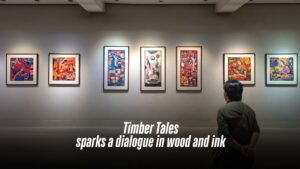
Timber Tales sparks a dialogue in wood and ink
The ongoing exhibition titled Timber Tales at La Galerie, Alliance Française de Dhaka invites audiences to experience the collaborative journey of three emerging artists who explore memory, process, and material through the art of woodcut printmaking. Within the exhibition, a faint, earthy scent of wood and ink hangs in the air. Walking into the gallery, some might find themselves pausing longer than expected, tracing the grain of the wood as if searching for their own stories between the lines. The exhibition features three artists—Rakib Alam Shanto, Shakil Mridha, and Abu Al Naeem—who express individuality through their woodcut prints. This contemplative exhibition is running from June 17 to June 25, 2025. Curated by the artists themselves, the exhibition reimagines the possibilities of woodcuts as a medium. Here, the tactile intimacy of carved timber meets the visual language of reflection, nostalgia, and search. As you wander through the space, individual voices emerge. Shakil Mridha’s work, with its minimalistic yet profound geometric forms, feels like a contemporary ode to Bangladeshi folk art, skillfully abstracting familiar motifs. Rakib Alam Shanto’s large-scale black-and-white pieces command attention, a powerful revival of a tradition, showcasing his remarkable focus. Abu Al Naeem’s pieces, often abstract, subtly reveal hidden figures, reflecting his continuous exploration of materials and techniques. Each artist, in their unique way, elevates woodcut beyond mere reproduction, transforming it into a medium of profound personal expression. And through that expression, each of their work reflects the heart of the creative process, where stories are carved into existence. At the heart of Timber Tales is a tribute to beginnings, to the mentor who shaped them, and to the space where it all began. Their acknowledgement of Professor Md. Anisuzzaman, whose generous guidance helped steer their vision, reveals the deeply collaborative ethos of the show. “This is where it all began—for the three of us,” reads a line from the exhibition note, underscoring the intimate bond between craft, community, and coming-of-age. In an era of digital immediacy, there’s something revolutionary about the deliberate slowness of woodcuts. And the three artists have breathed new life into the ancient art of woodcut. More than just a technique, it’s a dialogue between human touch and natural materials. Each frame holds a deeper narrative of tireless dedication—the careful selection of wood, the precise cuts, the methodical inking, and the final, expectant press. Open to all and continuing until 25 June 2025, Timber Tales will leave visitors with more than just images on paper. In a city rushing to reinvent itself, the exhibition feels like a pause, a reminder of our roots with a sense of belonging—to the artists, to the materials, and to the timeless, meditative act of making. Written by Samira Ahsan
Read More
KARMASANGSTHAN BANK: Vision for Inclusive Growth
Karmasangsthan Bank is a unique state-owned social bank in Bangladesh, established in 1998 to turn unemployed youth into entrepreneurs. Its mission is to extend financial services to underserved communities and foster sustainable businesses. Literally translated as the “Employment Bank,” it empowers aspiring entrepreneurs to transform their ideas into sustainable ventures. Born from a national vision for inclusive economic development, the bank has dedicated itself to bridging the financial gap for underserved segments of society, particularly in rural areas. This focus on inclusive growth sets it apart from conventional commercial banks and makes it an essential instrument for national development. Under a government mandate and with initial capital of Tk 300 crore, Karmasangsthan Bank was created to tackle unemployment by funding small enterprises. Over time, government backing has expanded its loan pool to around Tk 4,500 crore, amplifying its reach. Its core purpose remains nurturing grassroots entrepreneurship and uplifting marginalised groups. Karmasangsthan Bank tailors its products to the needs of unemployed youth and small-scale entrepreneurs. Its flagship offerings include: Low-interest and interest-free loans for start-up ventures, microcredit schemes designed for first-time borrowers and special financing packages for persons with disabilities. The bank’s board unites professionals from financial and administrative backgrounds, ensuring strategic oversight and mission alignment. In November 2024, Dr AFM Matiur Rahman took the helm as the 14th chairman, while Arun Kumar Chowdhury guides daily operations as Managing Director. Their stewardship has driven both stability and innovation. With over 285 branches and 1,800 employees spanning every district and most upazilas, Karmasangsthan Bank brings its services to urban centres and remote villages alike. This footprint underscores its commitment to rural financial inclusion and fuels broader socio-economic development across Bangladesh. Beyond financing, Karmasangsthan Bank serves as a catalyst for community uplift. Its operations blend government policy, entrepreneurial mentoring, and localised development initiatives—proving that a bank can be a powerful tool for social transformation. To reach the unbanked, the bank is rolling out mobile banking apps, digital payment gateways, and online portals. These technologies bridge geographic divides, making services more accessible to rural and marginalised populations. Through initiatives like this, Karmasangsthan Bank continues to fulfil its mission of fostering a balanced economic structure by converting the population into productive manpower and reducing unemployment. Currently, Bangladeshi citizens aged 18 to 50 are eligible for loans up to Tk 5 lakh without collateral and up to Tk 75 lakh with collateral. Thanks to its outstanding performance across key indicators, Karmasangsthan Bank ranked first among state-owned specialised banks for the last two consecutive fiscal years. The government approved the construction of a 25-storey multi-purpose building atop a four-storey basement at a cost of Tk 260 crore. This project will be built on 37 decimals of land formerly belonging to the Times-Bangla Trust in Motijheel, Dhaka, now registered under the bank’s name. Since Karmasangsthan Bank operates under a similar model as Grameen Bank, the government should consider granting it full tax exemption. This measure would enable the bank to lower its interest rates further, providing greater support to unemployed and poor borrowers. Additionally, the nation would benefit from more affordable products, fostering a competitive market environment. Bank’s Performance Karmasangsthan Bank has lent Tk 18,000 crore to over 1.2 million youth, indirectly benefiting some 4.2 million people. Its recovery rate is about 96%. Currently, approximately 2,25,000 entrepreneurs—30% of whom are new each year and 40% of whom are women—tap into its schemes, with a total of about Tk 4,300 crore in outstanding loans. In the last fiscal year (July 2024–June 2025), Tk 2,838 crore was disbursed in self-employment loans to 1,25,000 entrepreneurs. Tracking job creation and enterprise growth provides clear evidence of its social footprint. The breakdown includes: Cattle fattening: Tk 1,595 crore (56.2%) to 76,744 individuals. Dairy farms: Tk 525.36 crore (18.5%) to 24,712 individuals. Fisheries: Tk 126.75 crore (4.5%) to 5,832 individuals. Poultry farms: Tk 15.43 crore (0.6%) to 745 individuals. Agro-based industries and nurseries: Tk 11.28 crore (0.4%) to 530 individuals. Commercial sector: Tk 160.35 crore (5.65%) to 7,309 individuals. Service sector: Tk 76 crore (2.65%) to 3,669 individuals. Small and cottage industries: Tk 53.84 crore (2%) to 2,531 individuals. Other sectors: Tk 275 crore (9.5%) to 2,100 individuals. During the same period, the bank earned Tk 408.37 crore in revenue against operational expenses of Tk 270.33 crore. Its pre-tax profit stood at Tk 138.04 crore, and it paid Tk 19 crore in advance corporate income tax. Customer Success Stories Rezaul Haque, a 45-year-old resident of Sundarpur in Paba Upazila (Rajshahi), transformed his life through commercial fish farming. With an initial loan of Tk 50,000 from the Rajshahi branch of Karmasangsthan Bank, Rezaul received subsequent training from the Department of Fisheries and the Department of Youth Development. Starting modestly, his venture expanded over 95 bighas of water bodies. Today, his investment has soared past Tk 1 crore, and he earns an annual income of about Tk 10 lakh. His journey not only provided him with financial stability but also inspired many local youths to explore similar opportunities, contributing to the region’s growing protein demand. Broadening Horizons in Aquaculture Another remarkable example is Borhan Uddin from Bagsara village. After securing a loan from the bank, Borhan invested Tk 75 lakh in a fish-farming business. With clear prospects for future expansion, his investment is expected to hit Tk 1 crore in the near future. His success story is a testament to how specialised loan products, combined with financial guidance, can spur rapid growth and foster entrepreneurship at the grassroots level. Retail and Small Business Beyond aquaculture, Karmasangsthan Bank has also empowered entrepreneurs in the retail and small-business sectors. For instance, Shahajahan Ali, owner of a local enterprise in Nawhata Municipality Market, has been utilising the bank’s credit support for over a decade to sustain and grow his business. Similarly, Mokbul Hossain, who runs a shoe store in the same market, successfully expanded his operations with consistent financial backing. Beef Fattening and Dairy To promote food security and create
Read More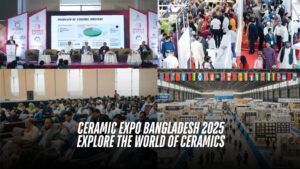
CERAMIC EXPO BANGLADESH 2025 EXPLORE THE WORLD OF CERAMICS
Ceramic Expo Bangladesh 2025 is fast approaching, promising to be the largest and most prestigious exhibition in the country. The event will bring together a wide range of manufacturers, innovators, professionals, and enthusiasts from both the local and global ceramic industries. The Bangladesh Ceramic Manufacturers and Exporters Association (BCMEA) will organize the event at the International Convention City Bashundhara (ICCB). This four-day event is more than just an expo – it’s a celebration of innovation, networking, and excellence in ceramics. Key Highlights of Ceramic Expo Bangladesh 2025 B2B & B2C Networking Opportunities Business-to-business (B2B) and business-to-consumer (B2C) sessions will allow exhibitors to showcase new products, technologies, and innovations to their target audiences. These sessions will help businesses explore opportunities for strategic collaboration and expansion. Awards & Recognitions An exciting feature of the event is honouring exhibitors with the Best Pavilion and Stall Design Awards. Exhibitors will design their pavilions and stalls based on their brand identity or how they wish to portray it to their target audience. Winners will be selected by a distinguished jury. A Lifetime Achievement Award has been introduced to honour an individual who has made a significant contribution to the development and growth of Bangladesh’s ceramic industry. Knowledge-Driven Seminars & Conferences The 2025 edition of the expo will host five insightful seminars and panel discussions. These sessions will feature prominent industry experts, architects, engineers, and thought leaders. Topics will focus on the future of ceramics, technological advancements, sustainability, and design innovations. Job Fair For job seekers, students, and professionals, Ceramic Expo Bangladesh 2025 offers a golden opportunity to connect with leading ceramic companies. Visitors will be able to submit their résumés to explore job opportunities with prominent ceramic manufacturers in Bangladesh. Visitor Engagement & Raffle Draw BCMEA will distribute exciting gifts and organise a raffle draw to appreciate and encourage maximum visitor participation. These activities aim to celebrate the continued support for the industry’s growth. Ceramic Expo Bangladesh 2025 proudly invites all to explore, exhibit, network, and learn through the event. It is a gateway to the future of ceramics and a grand opportunity for the ceramic industry to grow further. Written by Preety Dey
Read More
A Legacy of ABC Group Trust, Tenacity and Timeless Vision
In a business landscape where many joint ventures of the past century faltered under fractured trust and unchecked ambition, ABC Group shines as a beacon of integrity, resilience, and generational continuity. For over five decades, the organisation has not only transformed skylines but also redefined the very essence of partnership—proving that enduring success is built not solely on ambition, but on unwavering principles, a shared vision, and an unshakable commitment to people both within and beyond the company. “Partnerships rarely fail because of market forces,” reflects Subhash Chandra Ghosh, Chairman of ABC Group. “They collapse when trust erodes—when dishonesty, greed, or envy take root. Our survival has been anchored in three simple values: transparency in every transaction, fairness in every decision, and respect in every relationship.” This philosophy has guided ABC Group through the passing of its five founding partners, enabling a seamless transition of leadership to the next generation while preserving the spirit of its origins. Today, the group stands as a diversified conglomerate with four core divisions: ABC Limited (Construction), ABC Real Estate Limited (Property Development), ABC BPL (Ready-Mix Concrete Manufacturing & Supply), and the newly launched ABC FL (Facility Management Services). Each division plays a pivotal role in Bangladesh’s infrastructural and economic growth. Beyond construction and real estate, the group’s influence extends into the financial sector. The directors of ABC have been prominent founding shareholders of Mutual Trust Bank Limited (MTBL), one of Bangladesh’s most successful and trusted private banks. Rashed A. Chowdhury, the son of ABC’s founding chairman, Saifuddin Ahmed Chowdhury, now serves as Chairman of MTBL, further cementing the ABC Family’s legacy in nation-building across industries. The Genesis: Building Dreams from the Ground Up The story of ABC Group is intertwined with the birth of a nation. In 1972, in the stirring aftermath of Bangladesh’s independence, a bold vision took shape. Amirul Islam, his brother Nazrul Islam, and Saifuddin Ahmed Chowdhury—along with two associates—laid the cornerstone of Associated Builders Corporation (ABC) Limited. Soon thereafter, civil engineer Subhash Chandra Ghosh and architect Mostaqur Rahman joined the venture, forming a partnership that would one day redefine the country’s urban fabric. In those early days, ABC was not an empire—it was a dream defined by determination. With no heavy machinery, limited skilled labour, and scarce capital, the founders relied on resilience, strategic alliances, and sheer perseverance. Subhash Chandra Ghosh, then a young engineer, had begun his career at Yakub Limited earning a modest salary of 350 taka. When the company’s West Pakistani owner fled post-independence, Subhash and a colleague assumed leadership, keeping the operations afloat. It was during those turbulent times that fate brought him together with Amirul Islam—a meeting that would sow the seeds of an enduring legacy. Mr. Ghosh recalls with pride that his stake in the company was secured not through capital but through the strength of a handshake, a testament to an era when a man’s word was his bond. Forging a Future: The Rise of an Empire ABC’s first major breakthrough came with a two-crore-taka contract for the Bangladesh Machine Tools Factory, marking the beginning of its ascent. Landmark projects soon followed—Ashuganj Fertilizer Factory, Khulna Thermal Power Plant, and the Gorai Bridge—all setting new benchmarks in engineering excellence. Over the decades, ABC Group’s portfolio expanded to include national icons such as the Grameenphone Headquarters, North South University, BRAC University’s New Campus, and the Third Terminal of Hazrat Shahjalal International Airport. Currently, ABC Limited is building the prestigious Aga Khan Academy campus at Basundhara. By the late 1980s, ABC’s vision expanded beyond construction into real estate. In 1988, ABC Real Estate Limited (ABC REL) was born—a bold move at a time when the concept of apartment living was still in its infancy in Dhaka. From Concrete Foundations to Living Communities Challenges abounded: land scarcity, public skepticism toward apartment living, and the absence of clear registration laws. Yet, through meticulous planning, superior design, and uncompromising transparency, ABC Real Estate earned trust—one project at a time. The company has always approached the market with caution to avoid overambitious trading, a common pitfall in the real estate industry. Today, it has delivered more than 1,880 apartments across 70 projects in prime locations such as Uttara, Banani, Dhanmondi, Gulshan, Baridhara, and Chittagong. A crowning achievement is The Oasis at Ispahani Colony, an international-standard gated community in Moghbazar that spans 14.5 bighas. Completing 457 units within 70 months—despite various crises induced by the pandemic—is a true testament to ABC Real Estate’s planning and resilience. A New Vision: Affordable Excellence Beyond Dhaka Under the leadership of Srabanti Datta and Shougata Ghosh, ABC Real Estate is shifting its focus toward large-scale residential projects in mid-cost areas of Dhaka and its suburban localities. Their vision is clear: to provide quality housing with modern amenities accessible to the upper-middle class at reasonable prices. “Dhaka’s land prices have made premium housing unaffordable for many,” explains Srabanti Datta. “By developing well-planned communities in emerging zones, we can offer spacious living, green spaces, and modern facilities—without the exorbitant costs of the city center. With The Oasis, we are now confident that ABC has the best set of pragmatic ideas, skilled people, and strategic planning tools to successfully deliver massive projects beyond mere flashy brochures.” Upcoming projects like The Orchard exemplify this strategy, combining affordability with international standards. Additionally, the group is exploring expansion to Narayanganj, ensuring sustainable urban growth beyond the capital’s high value yet densely populated areas. Diversification & Innovation: The ABC Ecosystem Beyond construction and real estate, ABC Group has strategically diversified into ready-mix concrete (ABC BPL) and facility management (ABC FL), ensuring control over quality and service delivery across the board. ABC BPL is one of the country’s leading suppliers of ready-mix concrete, known for its precision, durability, and efficiency in high-rise constructions. ABC FL—the newly launched division—provides high-quality facility management services in Bangladesh, offering maintenance, security, and operational excellence for both residential and commercial properties. The Heart Behind the Helm: A Symphony
Read More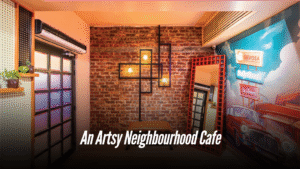
You Actually Want to Hang Out in! Brutown’s Got a Funky New Friend: Say Hello to Nervosa.
For those who enjoy café culture, a delightful spot has opened its doors to Dhaka’s vibrant crowd. Nervosa is a cafe located on Siddheswari Road, Dhaka, at the edge of a bustling neighbourhood—just above Brutown, which has long been a favorite in the heart of Bailey Road. Why Nervosa The name, “Nervosa,” is a deliberate nod to the beloved sitcom Frasier, where a fictional coffee shop of the same name served as a backdrop for the characters’ daily lives. Sabeel Rahman, CEO and Proprietor of BruTown and Nervosa, explains his choice with a playful intrigue: “The question of ‘Why Nervosa?’ is what makes it captivating. It draws attention, it’s a memorable name.” Consider Nervosa as the upscale, fancy, artistic neighbor of the popular cafe, BruTown, finding its niche in the community. Behind the Scenes Rehnuma Tasnim Sheefa, the principal architect of Parti.studio elaborates on the design philosophy: “Every design develops from a concept or a vision and if for a restaurant or a cafe, the branding has its influence as well. For Nervosa, that concept was built on strong character and a vibrant color palette, designed to draw a younger crowd into the cafe, as envisioned by the owner. When working in a public realm like cafes, as an architect I also had to focus on the psychological impact a person would have with the colors and the characters.” The color palette evolved gradually. Pale Orange took precedence, aligning with the theme initially, with striking illustrations bringing life to the walls. To make the illustrations stand out, a monochrome backdrop was introduced for the floors, ceilings, and other walls, allowing the boldly patterned and colored furniture to shine truly. The exposed brick on some of the walls adds a touch of urban grit, while the wooden flooring brings warmth and texture; keeping them aligned with the basic pale orange color. The cafe culture in Dhaka thrives on connection. Comfortable seating arrangements encourage heartfelt conversations, from an upcycled plush couch perfect for intimate gatherings to communal tables fostering spontaneous interactions. Nervosa goes a step further with cozy bookshelves stocked with comics and novels, perfect for anyone who wants to settle in with a good read. Instagrammable Spots Several strategically placed elements aim to create visually captivating ‘Instagrammable’ moments. The journey begins at the entry staircase, where a whimsical illustration introduces the cafe’s personality. Upon entering, a prominent neon light sign immediately catches the eye. Inside, a one-of-a-kind waffle mirror greets you at the entrance for your mirror selfies with your friends. Track lights are incorporated here to highlight specific areas, making them ideal for photos. “You will also find the neon lights in different spots around the cafe”, shares Architect Sheefa. The use of neon lights is an interior design trend in restaurants targeting younger crowds, particularly Gen Z. They create a visually appealing and Instagram-worthy atmosphere, making restaurants more attractive to social media-conscious customers, to create a unique and memorable visual experience. illustrations that speak to you To add character to the interiors, the beams and walls are filled with vibrant illustrations. In the beam above the counter, the illustrated characters resemble the target audience of the cafe, and how they interact and behave. Describing the artworks, Mashqurur Sabri, the artist, shares, “Nervosa walls are a burst of young energy and Dhaka madness — messy, loud, and full of heart. The hand-drawn, sketchy art style mixes raw lines with pops of bold, chaotic color — think warm reds, electric yellows, moody teals — capturing the city’s wild rhythm. From buzzing rickshaws to rooftop chill scenes, it’s the city on caffeine — vibrant, warm, and wide awake.” “When I think of Nervosa as perceived by the public, I wish it to be known as the most happening place in Siddeshwari,” says the owner, Sabeel Rahman. The vibrant interior, the playful name, and the strategic use of social media-friendly elements all point to a well-thought-out strategy. Nervosa isn’t just serving coffee; it’s serving an experience. And if the initial buzz is anything to go by, it’s an experience that Dhaka’s café-goers are eager to embrace. Written by Samira Ahsan
Read More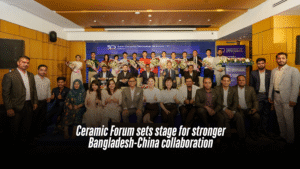
Ceramic Forum sets stage for stronger Bangladesh-China collaboration
With an emphasis on quality enhancement, efficiency improvement, and deeper cross-border collaboration, the Asian Ceramics Technology 50 Forum – Dhaka commenced on Saturday, drawing together leading figures from Bangladesh and China’s ceramics industries. Held at the Eden Grand Ballroom of Hotel Amari Dhaka, the forum was jointly organised by the Bangladesh Ceramic Manufacturers & Exporters Association (BCMEA) and Foshan Uniceramics Expo, under the theme: “Product Quality & Production Efficiency Enhancement and Investment Opportunities in Bangladesh – Win-Win Cooperation.” The day-long event served as a platform for industry leaders, technical experts, and stakeholders to explore strategies for improving production standards, reducing costs, optimizing performance, and boosting investment in Bangladesh’s ceramics sector. Participants from both countries stressed the urgency of embracing technological innovation and forging stronger partnerships to sustain growth and remain competitive in the evolving global market. Delivering the welcome address at the opening session, Mr. Irfan Uddin, General Secretary of BCMEA, welcomed the international delegates and highlighted the significance of events like this in strengthening industry ties between Bangladesh and China. “Together, let us explore new ideas, connect industries, and work toward a more vibrant future for ceramics in Asia,” he said. Mr. Irfan also acknowledged the contributions of the Chinese delegation, noting, “China’s technological advancements and global leadership in ceramics have long inspired us. Their participation here today reflects a mutual commitment to knowledge-sharing, sustainable growth, and regional cooperation.” Delivering his keynote address as chief guest, Mr. Md. Mamunur Rashid FCMA, Acting President of BCMEA and Additional Managing Director of X Ceramic Group, echoed similar sentiments. He underscored how the presence of Chinese industry leaders underscores a strong bond between the two industries and paves the way for joint ventures, technology transfer, and knowledge exchange. “Forums like this serve as a powerful platform for dialogue, innovation, and mutual growth,” he said, further highlighting Bangladesh’s investment opportunities and the government’s supportive policies and incentives for investors amid the country’s evolving socio-economic landscape. The forum’s technical sessions reflected its ambitious agenda. Technical Session 1: Product Quality & Production Efficiency Enhancement The first technical session focused on Product Quality and Production Efficiency Enhancement and was chaired by Mr. Mohd Ziaul Hoque Zico, Director of BCMEA and Deputy Managing Director & CEO of Hua Thai Ceramics Industries Ltd. Engr. Sadat H. Talukder, a consultant in the ceramic sector, and Mr. Luo Fei, a ceramic equipment technology expert from Foshan Uniceramics Development Co. Ltd., served as resource persons. Mr. Saidur Rahman Khan, Director of Operations at Akij Ceramics Ltd., and Ms. Yang Shuilan, General Manager of Foshan Lang Kun Electromechanical Equipment Co. Ltd., contributed as discussants. The session concluded with an engaging floor discussion. Technical Session 2: Cost Reduction, Efficiency Improvement & Optimization Mechanisms The second session, which explored two key topics—(i) Cost Reduction and Efficiency Improvement and (ii) Optimization Mechanisms for Tile Performance—was chaired by Mr. Mahin Bin Mazher, Advisor to BCMEA and Managing Director of X Ceramic Group. For Topic (i), Mr. Mohammad Bayazed Bashar, Chief Business Officer of DBL Ceramics Ltd., presented strategies for cost reduction and enhanced operational efficiency. For Topic (ii), Mr. Liu Zhanjie, a ceramic process and formulation technology expert from Foshan Uniceramics Development Co. Ltd., delivered technical insights on optimizing tile performance. The session’s discussants included Mr. A.K.M. Ziaul Islam, Chief Operating Officer of Meghna Ceramic Industries Ltd., and Mr. Sun Bowen, Sales Manager of Zibo Huayan Industrial Ceramics Co. Ltd.. Like the first, this session also concluded with a floor discussion. Technical Session 3: Investment Opportunities in Bangladesh The final session focused on Investment Opportunities in Bangladesh under the Changed Socio-Economic Scenario. It was chaired by Dr. Md. Anwar Ullah FCMA, former Secretary to the Government of Bangladesh. Mr. Md. Mominul Haque, Vice President of LankaBangla Investments PLC, served as the resource person for this session. Mr. Muhammad Nazrul Islam, Managing Director and CEO of Sandhani Life Finance Ltd., Mr. Li Xinliang, President of Ceramic Town Weekly and General Manager of Foshan Uniceramics Development Co. Ltd., and Ms. Joanna Sun, General Manager (Asia Market) of Tangshan Hexiang Intelligent Technology Co. Ltd., joined as discussants. Throughout the day, speakers from leading Bangladeshi companies such as Akij Ceramics, DBL Ceramics, Meghna Ceramic Industries, and LankaBangla Investments underscored the importance of strategic collaboration with China, especially in areas like technology integration, production management, and investment facilitation. The event concluded with a vote of thanks from Mr. Abdul Hakim Sumon, Senior Vice President of BCMEA and Managing Director of Excellent Ceramic Industries Ltd., who expressed gratitude to all guests, speakers, and participants for their contributions. He remarked that the forum marked a significant milestone in advancing regional partnerships and securing a sustainable future for Bangladesh’s ceramics industry. Participants wrapped up the day with a networking session over evening refreshments, celebrating the successful exchange of ideas and reaffirming commitments to long-term collaboration.
Read More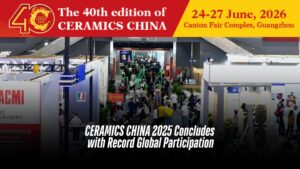
CERAMICS CHINA 2025 Concludes with Record Global Participation
CERAMICS CHINA 2025, the world’s leading trade fair for ceramic equipment and materials, successfully concluded on June 21st in Guangzhou, marking an exceptional edition characterized by unprecedented international engagement and vibrant business exchange. The event solidified its position as the indispensable global marketplace for innovation, collaboration and networking across the entire ceramics value chain. This year’s exhibition achieved remarkable scale and reach, attracting 786 outstanding exhibitors from 21 countries and regions, including mainland China, Belgium, Germany, France, Korea, Malaysia, Japan, Slovenia, Turkey, Spain, Italy, India , Indonesia, UK, Vietnam, Bangladesh, Russia, USA, Brazil, Taiwan China and Hong Kong China. The extensive participation validated the exhibition as a truly global microcosm showcasing advanced products, cutting-edge technologies and innovative solutions spanning intelligent production equipment, eco-friendly materials, digital manufacturing processes and end-to-end service system. The exhibition highlighted three defining trends within the ceramic industry development: the comprehensive AI-driven intelligence integrated throughout production workflows to enhance efficiency and strengthen quality control; the sprouting compact equipment designed for eco-friendly operations, cost reduction, and flexible manufacturing; the cross-sector diversified expansion dominated by traditional equipment manufacturers to cultivate sustainable market growth in different sectors. The evolving products and technologies showcased on-site also gave visitors insights into the latest industry trends and market dynamics, informing their purchasing decisions and strategic planning. From June 18-21, CERAMICS CHINA 2025 welcomed totally 80,240 visits of industry professionals from 94 countries and regions in the 4-day exhibition. Key visitor delegations this year represented major manufacturing hubs, industry associations, leading ceramic manufacturers and import/export giants. The expansive participation this year signified a significant leap in the global influence and appeal of the event. Building on the record participation and vibrant exchange of CERAMICS CHINA 2025, the highly anticipated next edition is now scheduled for June 24-27, 2026, in Guangzhou, where the global ceramics community will reconvene to build on this momentum and drive further industry advancement.
Read More
Ceramica Alberdi kickstarts a new ceramic manufacturing era with SACMI Continua+
Winner of ‘best new ceramic plant in South America’ at the Tecna Awards 2024, the company has introduced two new Continua+ lines to manufacture ultra-high quality products: an ambitious project that aims to build a smart, sustainable ceramics factory, with SACMI providing all the key production technologies Ceramica Alberdi has selected SACMI Continua+, installing – for the first time in South America – two parallel lines for the manufacture of ultra-high-quality slabs and tiles. Founded in 1907 and based in José C. Paz near Buenos Aires, the company has always been at the forefront of innovation: now, with this project, it’s taken another huge technological leap forward. The supplied plant, the first of its kind in South America, consists of two Continua+ presses (PCR 2120 model) operating in parallel to feed a single drying, glazing and firing line. Alberdi has taken a bold step here and has, with this new plant, targeted a specific segment: thin tiles and slabs (6 mm thick) that combine outstanding quality, practicality and aesthetics with low environmental impact, also significantly reducing the transportation costs of the finished product. A smart, high-quality ceramic plant that requires less energy, reduces handling/storage costs and streamlines installation: to build it, the only realistic choice was the PCR 2120, the compact ‘smart’ version of the SACMI Continua+ that delivers outstanding flexibility and productivity with the market’s most popular slab sizes (1200×2400, 600×1200 and related sub-sizes). In addition to the two Continua+ presses, SACMI supplied all the other key plant technologies, from body preparation – a new ATM140 spray dryer and a MMC 120 modular mill – to the new 5-tier dryer. Completing the order, the 300-meter-long FMA Maestro kiln offers a modulated air-gas solution with cutting-edge features that reduce consumption and emissions and retrieve heat to maximize efficiency. In this configuration – and thanks to the dual Continua+ line – Ceramica Alberdi has boosted plant productivity to over 25,000 square meters per day on all sizes, with a sharp focus on manufacturing extremely high-quality products to keep ahead of market trends. This outstanding inventiveness saw the company awarded the prestigious Tecna Award at the Tecna trade fair for ‘best new ceramic plant in South America’. The award acknowledges the company’s recent investments in technology that have allowed it to excel in terms of product and process innovation, strengthening its leadership on the Argentinian floor and wall tile market.
Read More
Dissonance Of Debris
From May 17th to 31st, the solo painting exhibition titled “Debris” by Kazi Salahuddin Ahmed adorned the walls of La Galerie, Alliance Française de Dhaka, Dhanmondi. The two-week-long, thought-provoking exhibition featured nearly 30 works on board paper, providing spectators with a glimpse into the artist’s most recent studies. Remembering is a kind of rebellion in Kazi Salahuddin Ahmed’s universe. His solo exhibition, “Debris,” was an uncompromising documentation of human vulnerability. The artist’s recollections of Bangladesh’s 1971 Liberation War seep into modern tragedies—Gaza’s annihilation, the Rohingya exodus, and Kashmir’s stifled cries. The paintings didn’t merely show ruins; they also resurrected spirits. Ahmed’s life had several eras of turmoil. Born within a world transformed by partition and war, his early work in the 1980s was abstract, but the twenty-first century tightened his emphasis. The song “Debris” captures this progression. Each piece is a palimpsest, with layers of pigment representing the strata of history, where erasure and evidence fight silently. Ahmed’s use of board paper as canvas makes a statement in and of itself. Board paper repels, as opposed to ordinary canvas, which absorbs, forcing the artist to handle surface tension. The resulting sculptures have a temporary quality, as if they would disintegrate like the makeshift shelters in Cox’s Bazar’s refugee camps. Though anchored in Bangladeshi stories, “Debris” speaks to a lexicon of global migration. The exhibition’s centerpiece, “Babel Fragment” (2024), depicts the mythological tower as a jagged silhouette against a sulfurous hue. Its shattered planes evoke both bombed-out Aleppo and the decaying tenements of Old Dhaka. Ahmed, who has flown from Paris to Islamabad, appears to imply that rubbish knows no boundaries. In “Eclipse of Return” (2024), a skeletal stairway rises into the emptiness, its steps fractured like vertebrae. Nearby, “Archive of Dust” displays a child’s sneaker half-buried in a thick texture that mimics charred dirt “The utter erasure of Gaza, which was once full of life; the ongoing miseries of people in Kashmir; or the hopelessness faced by displaced Rohingyas attempting to make a living in camps in Chattogram—all of this jostles the mind as one attempts to ponder the future of the human race. Furthermore, it is difficult to leave behind the legacy of Bangladesh’s repeated failures to shape a future. The people’s desire for political stability has always been a never-fulfilled dream in our country. The demise of the authoritarian dictatorship has undoubtedly allowed everyone to focus on a future beyond the current system, but it appears that things are still breaking apart, leaving us with only emotional rubble,” observed famous art critic Mustafa Zaman. The intimacy of “Debris” sets it apart from other forms of protest art. In “Letters Unsent,” bits of Urdu and Bangla letters emerge behind layers of gray, like voices muted by time. The piece is similar to Ahmed’s 2018 series on refugee diaries, but the language is virtually illegible—a metaphor for history’s selective memories. Written By Shahbaz Nahian
Read More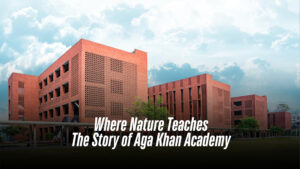
Where Nature Teaches: The Story of Aga Khan Academy
In Dhaka’s Bashundhara Residential Area, the Aga Khan Academy immediately catches your eye. Its warm brick walls, softened by greenery and a sparkling water channel, glow in the morning light. The building feels like a historical monument—orderly courtyards, intricate brickwork—yet the lively chatter of students reminds you this is a school—a place where learning blends seamlessly with nature’s rhythms. Bangladesh’s heritage that make it truly remarkable. Here, architecture becomes a canvas, interiors breathe with narrative, and every art installation stands as a tribute to the nation’s soul. Spanning in 17 acres, the award-winning Aga Khan Academy in Dhaka was developed through a collaboration between SHATOTTO Architecture for Green Living and Feilden Clegg Bradley Studios. The design draws inspiration from the region’s ancient Buddhist Mahaviharas, incorporating their architecture and philosophy into the campus. A clay model was used to visualise the design, helping stakeholders understand the campus’s spatial organisation before construction. Covering 74,150 square metres, this is Shatotto’s largest school project to date. The campus provides a green sanctuary within Dhaka’s urban environment. This academy represents a significant investment by the Aga Khan Development Network in Bangladesh’s future. As the fourth institution in a planned network of 18 Aga Khan Academies across Africa, South and Central Asia, and the Middle East, the Dhaka campus connects students to a wider academic and cultural community. Other campuses are located in Mombasa, Hyderabad, and Maputo, forming a global network focused on pluralism, leadership, and excellence. To support education from nursery to diploma level, Aga Khan Education Services required a permanent campus. This presented a challenge in a dense city like Dhaka. The project is designed to be scalable and sustainable, planned in seven construction phases. Since its first phase launched in September 2022, the academy has offered an integrated environment that connects nature with education, providing a calm setting within Bashundhara’s urban area. The Dhaka campus currently enrolls 750 students, with plans for expansion to 1,200. The masterplan includes residential facilities designed to accommodate students and staff from across Bangladesh and other countries. This lays the foundation for a diverse and inclusive learning environment upon full implementation. The vision for this project was led by Architect Rafiq Azam of Shatotto Architecture for Green Living, who incorporated Bangladesh’s heritage into the design. He conceptualized it as an “archaeological site, like our ancient monasteries.” Co-lead Architect Peter Clegg of Feilden Clegg Bradley Studios contributed global standards and technical precision. A central amphitheatre serves as a space for performances and gatherings. The adjacent Maidan, a large open playground, accommodates student activities, serving recreational and social functions. Brick buildings surround these shared areas on a planted base, offering unobstructed views of the Maidan from all directions. The Maidan functions as the campus’s central point, reflecting the spirit of ancient Buddhist Mahaviharas. These elements collectively support an environment where the physical space contributes to the educational process. “The school itself teaches,” says Rafiq Azam, lead architect of the Aga Khan Academy. “Students learn from books inside the classroom, but when they step outside, they begin to notice surroundings on their own — how water flows, how flowers bloom, how the sun moves across the sky, and how the breeze blows from a certain direction.” He adds, “This kind of learning happens naturally, guided by the environment rather than just by the teacher. The process encourages students to learn independently, beyond what is taught in the classroom.” Rafiq Azam emphasised the local context influencing the design, noting the significance of greenery, water, and rain in Bangladesh’s fertile landscape. This sensitivity is integrated into the campus layout, where natural elements are part of daily student life. The academy’s design heavily features brick, chosen for both its practical and aesthetic qualities, consistent with Bangladesh’s architectural history. Each brick is carefully positioned. According to Feilden Clegg Bradley Studios, brick was selected to revive local craftsmanship and to contrast with the render and concrete common in surrounding new buildings. The construction method involves deeply embedded mortar between brick pairs, a technique seen in historical sites, ensuring longevity and a timeless appearance. This strategic use of locally sourced brick, combined with Bangladeshi brick patterning, creates a cohesive campus. It establishes a hierarchy of spaces through its brickwork. Facade perforations allow daylight into interior corridors, using traditional techniques. Recessed windows, screens, and protruding brick columns provide shading for classrooms and create covered balconies and walkways. Classrooms are oriented to minimise solar gain in summer, with external walkways and adjacent buildings providing passive solar shading from the morning sun throughout the year. This ensures adequate daylight and outdoor views. Architects designed these spaces for passive heating and shading year-round to minimise energy consumption. This climate responsiveness was achieved through extensive sun pattern analysis and wind flow direction studies, optimising light and ventilation. The academy’s character reflects many original Buddhist universities in Bangladesh. It is defined by the massing and materiality of brick buildings located on a sculpted and planted landscape base surrounding the central Maidan. Alongside the main field, the complex includes smaller connected areas featuring concrete canopies for shelter, along with brick benches and planters. These peripheral spaces serve as transitions between the central Maidan and more intimate interior areas. Spaces are tailored for different age groups; for example, the senior courtyard offers shaded zones under planted trees for focused group activities. The assembly court is simple, with four ‘Dhaak trees,’ which inspired Dhaka’s name. The primary central courtyard accommodates larger gatherings and includes an amphitheatre built around a sand pit. This pit is designed to collect rainwater during heavy rainfall, holding up to 170 mm of water for approximately 10 to 30 minutes. The campus masterplan organises spaces into four zones—Intellectual, Moral, Physical, and Spiritual—supporting a holistic educational philosophy. Each block is designed for a specific function. The Academic Block, a central hub, contains administrative workstations, learning centers, group study areas, and a lecture hall, along with a terrace. Its white-walled classrooms vary in
Read More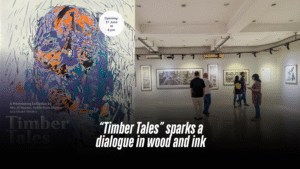
“Timber Tales” sparks a dialogue in wood and ink
The ongoing exhibition titled Timber Tales at La Galerie, Alliance Française de Dhaka, invites audiences to experience the collaborative journey of three emerging artists who explore memory, process, and material through the art of woodcut printmaking. Within the exhibition, a faint, earthy scent of wood and ink hangs in the air. Walking into the gallery, some might find themselves pausing longer than expected, tracing the grain of the wood, as if searching for their own stories between the lines. The exhibition features three artists—Rakib Alam Shanto, Shakil Mridha, and Abu Al Naeem—who express individuality through their woodcut prints. This contemplative exhibition is running from June 17 to June 25, 2025. Curated by the artists themselves, the exhibition reimagines the possibilities of woodcut as a medium. Here, the tactile intimacy of carved timber meets the visual language of reflection, nostalgia, and search. As you wander through the space, individual voices emerge. Shakil Mridha’s work, with its minimalistic yet profound geometric forms, feels like a contemporary ode to Bangladeshi folk art, skillfully abstracting familiar motifs. Rakib Alam Shanto’s large-scale black and white pieces command attention, a powerful revival of a classic tradition, showcasing his remarkable focus. And Abu Al Naeem’s pieces, often abstract, subtly reveal hidden figures, reflecting his continuous exploration of materials and techniques. Each artist, in their unique way, elevates woodcut beyond mere reproduction, transforming it into a medium of profound personal expression. And through that expression, each of their work reflects the heart of the creative process, where stories are carved into existence. At the heart of Timber Tales is a tribute to beginnings, to the mentor who shaped them, and to the space where it all began. Their acknowledgement of Professor Md. Anisuzzaman, whose generous guidance helped steer their vision, reveals the deeply collaborative ethos of the show. “This is where it all began—for the three of us,” reads a line from the exhibition note, underscoring the intimate bond between craft, community, and coming-of-age. In an era of digital immediacy, there’s something revolutionary about the deliberate slowness of woodcut. And the three artists have breathed new life into the ancient art of woodcut. More than just a technique, it’s a dialogue between human touch and natural materials. Each frame holds a deeper narrative of tireless dedication—the careful selection of wood, the precise cuts, the methodical inking, and the final, expectant press. Open to all and continuing until 25 June 2025, Timber Tales will leave visitors with more than just images on paper. In a city rushing to reinvent itself, the exhibition feels like a pause, a reminder of our roots with a sense of belonging—to the artists, to the materials, and to the timeless, meditative act of making. Written By Samira Ahsan
Read More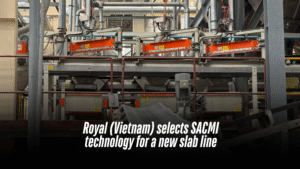
Royal (Vietnam) selects SACMI technology for a new slab line
The heart of the order is the new Continua+ 2180, equipped with cutting-edge digital decoration solutions Following installation of the new SACMI Continua+ 2180, Royal (Vietnam) becomes the first Asia-Pacific group to equip itself with SACMI technology for on-surface and through-body slab decoration. Moreover, the line is digitally coordinated with Deep Digital solutions, supplied here in an all-round configuration: two DHD digital wet decorators and a DDG digital grit-glue decorator. The new line will allow Royal to expand its range by creating new products with unmatched three-dimensional ‘material’ effects, all the strength and durability of ceramic, and a look that mirrors the aesthetics of natural materials. This important investment decision was not motivated by the innovative forming and decorating technology alone: equally crucial was SACMI’s ability to supply the complete plant, from body preparation (with two spray dryers and relative spray-dried powder conveying/storage systems) to firing in a high-efficiency roller kiln. Already strongly positioned on international markets, Royal has now – with SACMI – taken quality in these high-added-value segments to the next level. For example: the manufacture of ceramic countertops and furnishing accessories, with all the advantages Continua+ has to offer in terms of versatility, productivity and fully flexible control of size and thickness, in coordination with all the digital devices on the line.
Read More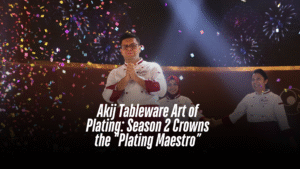
Akij Tableware Art of Plating: Season 2 Crowns the “Plating Maestro”
The curtain has drawn on the remarkable journey of Akij Tableware Art of Plating: Season 2, the pioneering reality show that reimagined tableware as a medium for creative expression and showcased the artistry of modern plating. Following weeks of intense competition, visually striking presentations, and exceptional culinary performances, the grand finale—held on May 16, 2025—served as a fitting conclusion to a season defined by innovation and excellence. Md. Golam Rabby emerged victorious as the champion, taking home the Plating Maestro title along with BDT 10,00,000 along with a professional plating course, national media exposure, and an exclusive Akij Tableware dinner set. The competition was fierce, with equally impressive performances by the runners-up: Iffat Jerin Sarker, awarded Plating Icon (1st Runner-up), received BDT 5,00,000; Dr. Rawzatur Rumman, crowned Plating Maverick (2nd Runner-up), won BDT 3,00,000; Homayun Kabir and Nawsheen Mubasshira Rodela, honored as Plating Masterminds (4th and 5th place respectively), each received BDT 1,00,000. Hosted across Banglavision, RTV, Deepto TV, and streaming on Chorki, Akij Tableware Art of Plating: Season 2 captivated audiences nationwide with its unique blend of tradition and innovation. Contestants turned beloved dishes into visual and gastronomic masterpieces, judged on aesthetics, technique, and culinary understanding. Akij Tableware Art of Plating: Season 2 redefined how we experience food—elevating it from everyday necessity to a dynamic, visual art form. The show celebrated creativity, precision, and innovation, turning each plate into a canvas where flavor met form. Throughout the season, contestants pushed boundaries, transforming ingredients into stunning, story-driven presentations that delighted both the eyes and the palate. More than a competition, this season launched a new movement in culinary expression, inspiring audiences to rethink how food is seen, served, and appreciated. And the journey isn’t over—a new season is coming soon, promising fresh talent, bold ideas, and next-level plating artistry. To stay updated on what’s next, follow www.aop.com.bd and join the evolution of food into a true visual experience.
Read More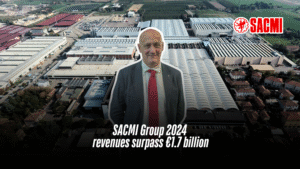
SACMI Group 2024: revenues surpass €1.7 billion
The yearly financial statement – approved yesterday, 16th May, during the Parent Company Shareholders’ Meeting – highlighted a net equity of more than one billion euros, growing margins and financial solidity. 2024 also saw the drafting of the first Group Sustainability Plan. Paolo Mongardi, President of SACMI, states: “Sustainability is the fuel of future competitiveness. We continue to invest in people and remain focused on the values that have guided SACMI’s enduring worldwide success” Imola, 17th May 2025 – SACMI closes 2024 with sales revenues of 1.728 billion euros. Despite the complex international economic and geopolitical backdrop, the company’s economic and financial fundamentals proved to be sound. For the first time, net equity exceeded one billion euros (1.055 billion, +172 million compared to 2023) while EBITDA settled at over 323 million euros and EBIT at 236 million. Net profit exceeded 200 million. These were the highlights of the Consolidated Financial Statement, presented yesterday evening, 16th May, at the Parent Company’s (SACMI Imola) Shareholders’ Meeting. “2024 was a solid year that went beyond expectations”, pointed out the President, Paolo Mongardi. “SACMI’s forward-thinking strategy rests on solid foundations and fully embraces the global drivers of digitalization and sustainability”. The year saw a continued focus on the core businesses, confirming the sterling reputation of – and customers’ confidence in – SACMI products across all sectors. In parallel with the to-be-expected slowdown in the ceramic sector – the result of international tensions and the sluggish global construction market – the Rigid Packaging, Advanced Technologies, Packaging & Chocolate sectors all performed excellently, driven by highly dynamic markets receptive to innovation. Investment remained consistently high in 2024 at 71 million euros, in line with the previous year, with a strong focus on innovation (276 new patent applications in 2024 alone, over 6,200 in the Group’s history) and training (over 94,000 hours). In parallel, SACMI confirms its role as a key player in the manufacturing industry’s ecological transition: during the year it presented innovative firing processes (e.g. electric), new process control solutions (thanks also to the acquisition of a majority share in Italvision in 2024), plus new eco-compatible standards, processes and materials in the packaging sector. “Sustainability is the key to future competitiveness”, explains President Paolo Mongardi. “We continue to invest in people by focusing on our values, which have consistently guided SACMI to worldwide success.” The green commitment is also evident at Governance level: the obligations of the new European CSRD (Corporate Sustainability Reporting Directive) were brought forward to 2024 and the first Group Sustainability Plan – an ambitious project that details actions and goals along the entire value chain, from suppliers to local communities – was drawn up. In the ESG sphere, SACMI has strengthened monitoring of indirect emissions linked to the use of its products and plants: this is part of an approach that centers on eco-design and the entire product life cycle to ensure processes are truly circular and impacts are minimized. The share of self-produced renewable energy is also growing (2.6 million kWh), the goal being to progressively decarbonize production facilities. On the employment front, the Group had a total of 4,756 employees at the end of 2024, with over 50% of new hires aged under 30. Close collaboration with universities and research facilities also continued. Ties with local communities – a part of SACMI’s DNA since its founding – became even stronger in 2024, with 90% of procurement networks consisting of local suppliers. Over the three-year period, the company also donated 2.4 million euros to healthcare, educational, safety, inclusion, sports and cultural projects. The year 2024 was a special one for SACMI, with the company reaching the milestone of its 105th anniversary. “We enter 2025 aware of not just the challenges but also the opportunities”, concludes the President, Paolo Mongardi, “with all the confidence that only a long history of innovation, solidity and responsibility can provide”.
Read MoreFor the Love of Language, Literature and Nation
With a new sun, new authorities emerge, revitalising familiar spaces. The 40th Ekushey Book Fair 2025, themed “July Mass Uprising: Building a New Bangladesh (New Bangladesh Deconstruction),” featured over 700 publishing houses at the premises of Bangla Academy and Suhrawardy Udyan. The month-long fair was inaugurated by Dr. Muhammad Yunus, the Chief Adviser of the interim government on 01 February. The Amar Ekushey Book Fair, a fundamental element of Bangladesh’s literary heritage, returned this year with a striking and visually captivating transformation. Uniquely crafted stalls add an architectural charm that sets this year’s fair apart from the previous editions. Visitors are greeted with the richness of literature and an impressive array of architecturally designed stalls, each presenting a unique identity. The influence of the new government is evident in the fair’s structured setup, where each stall showcases unique aesthetics through bold shapes, intricate exteriors, and thematic designs. When visiting this year’s Ekushey Book Fair, the crowd was astounding. People of all ages turned the fair into a true celebration. The entrance was bustling with various food vans, and women and children were all dressed up. The Book Fair has never been this festive and crowded in recent years, even on working days. Whether for recreation or out of love for books, the fair should continue in this spirit for eternity, celebrating Bangla language and literature. Readers and visitors took a moment to admire the aesthetics embraced by publishers who dedicated extra time and thought to beautifully decorate their pavilions. One of the highlights of this year’s book fair is the pavilion by Iti Prokashon, titled ‘Ziar Bari’ (Zia’s House), named after Ziaur Rahman, a prominent army chief, freedom fighter and politician who served as the sixth President of Bangladesh from 1977 to 1981. A key figure in the country’s War of Independence, Zia’s name has often been sidelined in public discourse and textbooks due to the agendas of the previous autocratic regime. In contrast, Onnodhara Prokashon transformed its pavilion into a representation of the Bangladesh Parliament House. The sight of these two distinct symbols coexisting on the same ground truly captivated visitors. Afsar Brothers gave their pavilion a harmonious blend of heritage and functionality, making it an inviting space for book lovers while paying homage to Bengal’s rich architectural traditions.
Read More


